#normally on a summer Saturday evening this street would be busy with tourists
Text

After the rain... & it was all quiet as we headed home, down the cobbled street.
#normally on a summer Saturday evening this street would be busy with tourists#there's an old pub halfway down... as well as cafes... a church at the far end... a couple of small museums#anyway this time of year we are continuously dodging visitors taking photos of the lane!#but today we had a sudden & rather heavy rain shower which made everyone dash back inside!#apart from Flynn & me - we hid under a tree in the woods until it mostly dropped off#then scurried home before it started again!#flynn#border collie#dog#lane#england#cobbled street
115 notes
·
View notes
Text
Afterglow (Nice to Meet You Series)
Charlie Barber x Reader
Nice to Meet You: a series of one shots based off of this post. Previous installments can be found here:
Adam Sackler
TW: Lil bit of angst and cynicism at the beginning, mentions of divorce, breakups, anxiety, depression, mention of alcohol consumption
A/N: This is my first piece that I’ve posted in awhile, I’m so sorry for the content drought! This series is kind of sporadic atm (kind of a result of life) but I miss you all so very much. Here’s to a normal content schedule some day 💓 Thank you for reading!
...
Timing always tends to be a funny thing, you supposed.
You weren’t sure if you were an “everything happens for a reason” sort of person person, a person who believed in fate. Who believed in soulmates. You used to be that way six years ago, before the reality of life and relationships and loss and grief and disappointment and all of the wonderful bad things had gotten to you. Had snatched up who you were, chewed that essence up, and spit it right back out.
So here you were, one year removed from when everything essentially blew up in your face, leaving you to rebuild.
And here Charlie was, coming off one of the worst years of his life, knowing almost exactly how you felt.
The cynic in you is saying that it’s just too cliché, the two of you being so broken and finding each other like this.
The small voice in the back of your mind that’s still clinging to the dreamer you once were? It’s telling you that the two of you were meant to find each other and, yeah, you roll your eyes every time the thought crosses your mind. However, with each passing day, you become more and more convinced that it was true.
How embarrassing.
It’s one of those rare September days that happen before the seasons change, when it feels more like mid October than the last few days of summer. Your cheeks are burning from the wind that whips your hair everywhere, a pleasant cold that you’d longed for over the summer months. The hot coffee in your hand threatens to spill from it’s cup and you take tentative sips when you absolutely have to stop at crosswalks and wait for cars to go by before darting out again.
Naturally, you were running late to the Saturday morning meeting of people on the New York theater scene planning for what the industry calls red bucket season. In the aftermath of all of the loss and grief and spiraling thoughts last fall you had finally said yes to the constant begging of your coworkers in the marketing department at Schubert and started to become more heavily involved with Broadway Cares/Equity Fights Aids. The overwhelming joy that came with the annual Flea Market in the Schubert Ally last September had given you hope to last all the way through to red bucket season, which carried you into the spring and helped you to feel like you were doing something productive with your time other than sleep, eat, work, and cry.
You’d met people from different companies in the theater world, met so many lovely actors and musicians and dressers and heads of house and developed a net to busy yourself, to affirm your sense of self worth, to get a drink with on a Sunday afternoon when the ghost light was finally turned on after the matinee crowd had finally cleared the stage door and the last member of the orchestra had said goodnight.
Taking a deep breath and glancing at your watch only to see that you were fifteen minutes late, you swallow and push your way through the doors, cheeks heating up even more if at all possible. There isn’t anyone you know staring back at you when all twenty something people turn to see who had arrived late and interrupted the meeting’s organizer. You cringe internally as you call out a simple apology and slip into the first vacant seat that catches your eye.
Enter Charlie Barber.
His head whipped back when everyone else’s had. He had looked you up and down, tried to see if you were anyone he knew like everyone else in the room. He couldn’t see you, didn’t really see you until you plopped down next to him, wind blown and flustered and absolutely breathtaking.
Post divorce finalization, Charlie had decided that he wasn’t going to go looking for someone else. He didn’t need someone to come in and pick up all the pieces or any of that bullshit. He wasn’t looking for a savior to fix it all —grief was something to handle on your own in his eyes.
As you lean over and whisper another apology to him specifically, as if you had inconvenienced him personally by sweeping into the room late and choosing to sit next to him and draw attention to him too, Charlie feels like he’s been hit by a truck. The simple apology rings like a crescendo through his head and chest and he feels it in his bones. He rushes out his acknowledgement, tells you it’s okay, but he feels like his mouth has turned into molasses.
About halfway through the presentation, he leans over and nudges you, pointing out a typo in the slide presentation. It’s a bold move, all things considered — you did know the woman running the meeting, she was your boss and someone you considered to be a close acquaintance. You’d mentioned as much when Charlie had turned to you during some dumb partner exercise she had made you all do to get to know each other.
The stifled laughter that bubbles past your lips rivals any top forty hit that played in the background when Charlie got his coffee that morning, much earlier than you, in the coffee shop three blocks from the auditorium you were now sitting in. Suddenly, he finds himself obsessing over how it would sound uninhibited by the social circumstances. He wants to make you laugh over and over again.
It’s chance that the two of you are assigned to help run the first red bucket training session of the season before the first performance of a long running musical that you had never seen nor cared to have seen three days later. It’s close to dinner time and you’ve had a long day at the office. Charlie’s had a long day too, a long few days thinking about when he’d see you again. How well the two of you had gotten on, how your hands had brushed over each other at the stupid little food spread during your break on Saturday.
He thinks about what he should wear, what you’d be wearing, if you’d want to run across the street afterwards and split a pie at the local pizza joint that all of the tourists frequented before shows, wanting to get an “authentic” slice but not wanting to stray to far from the familiarity of the theater district and Times Square in all of it’s grubby, overrated glory.
Charlie doesn’t assume he’d even crossed your mind since you parted ways Saturday. He figures you’re busy, that you aren’t looking for anything because you’re just fine on your own or maybe you’re with somebody else. He doesn’t chance snooping on your social media to break the lovely reverie dancing in his head as he falls asleep Saturday, Sunday, and Monday evening. The one where he gets to start over, gets to start a relationship that’s based in equal footing and rationality rather than fear and chaotic emotions and limelight.
Little does he know that you’ve been thinking about him too, your mind reeling with the same possibilities for yourself. It scared you more than anything that you’d even begun to entertain those types of thoughts.
You knew he’d just come off of an ugly divorce. Hell, you knew who he was when you had plopped down next to him and caught a glimpse of his furrowed brow and broad shouldered stature. You hadn’t expected someone as busy as him, as important as him to be here with the rest of you, all minor players in the theater world for the most part. You certainly hadn’t expected to enjoy your time with him and dance almost the whole way home because you were so excited that you’d been given the opportunity to see him again.
Was it worth asking him to hang out after the meeting? Would he laugh in your face? Turn you down politely and tell you he’d see you at your next assigned training session? Would he ignore it and walk out to meet someone else and kiss them under the lights of the marquees?
You spent the whole meeting wondering how you would ask him, if you would even ask him. You worked on autopilot, completely preoccupied with stealing glances across the room at Charlie, joking with Charlie during breaks, brushing Charlie’s hand when you passed him paper...Charlie, Charlie, Charlie.
“Nice work tonight.” A baritone voice pulls you from your thoughts and you glance up to see the man himself, eyes crinkled at the edges as he smiles down at you while the cast filters back stage.
You start to clean things up, trying to busy yourself so you don’t put your foot in your mouth. “You too, Charlie.” You hum, mentally kicking yourself because wow were you lame. You could have said anything else and you just echoed his words instead? Your chances were slipping right through your fingers.
He picks at lint on his sweater that isn’t even there, kicks some invisible object as he watches you. “How come I’ve never seen you around before last weekend? Charlotte told me you’ve been with Schubert for awhile now and both of my shows have been in Schubert buildings. So’s my third.”
“You were talking to Charlotte about me?” You ask, head snapping up with a shit eating grin. He was talking about you with other people?
Charlie’s cheeks go bright red and his hand comes up to rub the back of his neck, a nervous habit of his. He stumbles over his words, tries to come up with any other explanation to hide the truth of why he had asked Charlotte about you. Before he could say anything else, you swallow your nerves, then stand up straighter.
“Because maybe I’ve been talking to her about you.” You shrug — you hadn’t really. Hell, you don’t even know why the words came out of your mouth.
His eyes sparkle a bit as he tilts his head. “Maybe?”
“Yeah, maybe.”
The man standing across from you grabs an armful of infographics and slips them into the box that was meant to go to the head of house, to have on hand for people interested in donating. “Charlotte mentioned you liked pizza.” He says and, of course, it couldn’t have been true, you didn’t know Charlotte that well, but you appreciated the effort.
You smile and take a step forward, looking him up and down shyly. “Maybe I do.”
Charlie snorts, rolls his eyes, then nudges you playfully for good measure as he prays that he’s reading the room correctly. “Well maybe you’d want to get some with me?”
You half hear the question. He’s so handsome and you wonder if he knows it. If he knows he’s had you weak at the knees since the minute you’d made eye contact with him Saturday. “Maybe I’d like that.” You say, eyes round and full of wonder.
He smiles, putting his hands in his pockets. “It’s a date then.”
“You want to call it a date?” Butterflies are now running rampant in your stomach.
“Maybe.”
You’re both grinning from ear to ear now, faces hot and hands sweaty and shaking. “If you’re calling it a date, then yeah. I’d like that a lot.”
So Charlie takes you across the street and you each eat half a pizza, laughing over cheap wine and talking about how snooty actors could be. How demanding the stage door was. Your respective backgrounds in theater, his early success, your acceptance of the fact that you wouldn’t make it big and it was better to just settle into marketing and still be in the industry. Job security and such.
He takes your hand outside of the restaurant as you lead him toward the local bakery that sells cookies fresh from the oven.
You intertwine your fingers with his while you stand in line for hot chocolate as dusk turns to night in Central Park.
He kisses you after wiping a bit of chocolate from the corner of your mouth on the Brooklyn bound A train a half hour later. And again on your stoop when you finally arrive home.
He kisses you another time after he gives you his number and then once more when he realizes he’s only a ten minute walk from your apartment.
After heading upstairs, showering, doing some dirty dishes, and then plopping onto your bed, you smile when you see three texts from Charlie on your phone’s lock screen. Was it cliché to say that he had swooped in and fixed everything? Yeah and he didn’t fix anything really. He’d kissed you a few times and held your hand, sure, and he seemed like he wanted more. You wanted more too, but that didn’t mean that you were healed.
All you did know was that the hopeless romantic in you was louder than they had been for the better part of two years and you couldn’t stop smiling and wondering if it was coincidence that you had plopped down next to Charlie Barber during the meeting. Was it coincidence that the barista had taken longer with your latte that morning or was it fate telling you to take a deep breath and hold on tight because in a matter of minutes, you’d be meeting someone special.
#Charlie Barber#Adam Driver#Marriage Story#reader self insert#Charlie x reader#Charlie Barber x reader#Charlie#Charlie Barber fic#Charlie fic#Marriage Story fic#charlie barber x you#charlie x you#charlie barber reader insert
31 notes
·
View notes
Text
Headlines
Declining Western birth rates
(Nikkei Asian Review) Births in many developed countries are poised to crater next year amid the economic turmoil caused by the pandemic and, in many cases, the botched response. Japan is projected to see births drop 10 percent in 2021, accelerating a decline. Last year there were 860,000 births in Japan, the first time the level dipped below 900,000 since tracking began. Babies in the U.S. could decline by 300,000 to 500,000 next year, a 10 percent drop in the 3.7 million average annual births. According to the International Labor Organization, 17.1 percent of people aged 18 to 29 around the world have not worked since the pandemic began, and those who did saw their hours shrink an average of 23 percent.
Mean streets
(Bloomberg) Mean streets are getting meaner, and more than 700 cities have said they may cut infrastructure spending due to budget shortfalls. Potholes caused $15 billion in damages to cars over five years, and some states are in a particularly rough stretch of road: in Rhode Island, 48 percent of urban streets are in poor condition according to the Federal Highway Administration, followed by California (46 percent), New Jersey (42 percent), and South Dakota and Hawaii (36 percent each). In some metropolitan areas in particular, most roads are bad: San Francisco-Oakland (71 percent of streets are poor), San Jose (63 percent) and Los Angeles (63 percent).
Big California wildfires burn on as death toll reaches 7
(AP) Firefighters battling three massive wildfires in Northern California got a break from the weather early Monday as humidity rose and there was no return of the onslaught of lightning strikes that ignited the infernos a week earlier. The region surrounding San Francisco Bay remained under extreme fire danger until late afternoon amid the possibility of lightning and gusty winds, but fire commanders said the weather had aided their efforts so far. The three big fires around the Bay Area and many others burning across the state have put nearly 250,000 people under evacuation orders and warnings and authorities renewed warnings for anxious homeowners to stay away from the evacuation zones.
National Guard called out after police shoot Black man
(AP) Wisconsin’s governor summoned the National Guard for fear of another round of violent protests Monday after the police shooting of a Black man under murky circumstances turned Kenosha into the nation’s latest flashpoint city in a summer of racial unrest. The move came after protesters set cars on fire, smashed windows and clashed with officers in riot gear Sunday night over the wounding of 29-year-old Jacob Blake, who was hospitalized in serious condition. In a widely seen cellphone video made by an onlooker, he was shot [by police seven times] in the back, as he leaned into his SUV while his three children sat in the vehicle. The shooting happened around 5 p.m. Sunday and was captured from across the street on video that was posted online. In the footage, Blake walks from the sidewalk around the front of his SUV to his driver-side door as officers follow him with their guns pointed and shout at him. As Blake opens the door and leans into the SUV, an officer grabs his shirt from behind and opens fire while Blake has his back turned.
Marco collapses, sets stage for Laura to hit US as hurricane
(AP) Tropical Storm Marco began falling apart Monday, easing one threat to the Gulf Coast but setting the stage for the arrival of Laura as a potentially supercharged Category 3 hurricane with winds topping 110 mph (177 kph). While Marco weakened, Laura’s potential got stronger, and forecasters raised the possibility of a major hurricane that would pummel western Louisiana and eastern Texas from late Wednesday into Thursday. The two-storm combination could bring a history-making onslaught of wind and coastal flooding from Texas to Alabama, forecasters said. State emergencies were declared in Louisiana and Mississippi, and shelters were being opened with cots set farther apart, among other measures designed to curb infections.
In Mexico's televised 'return to classes,' parents turn to state schools
(Reuters) Millions of students return to classes virtually in Mexico on Monday after a hiatus lasting months caused by the coronavirus pandemic that has sparked an exodus from private schools. Mexico has yet to publish official data, but private-school bodies consulted by Reuters said almost 2 million students at all levels were expected to quit private schools because of the crisis to join an already overcrowded public system. The lack of both in-person teaching and access to facilities has left many parents unwilling to shoulder private-school costs. Supporters of private schools worry the turmoil could stretch the education system, especially after President Andres Manuel Lopez Obrador last year canceled a reform that the previous government said would improve teaching standards in Mexico, one of the worst-performing countries in the 37-nation Organisation for Economic Cooperation and Development (OECD). As state schools reopen, students will start the new academic year with a home-learning program broadcast by major television networks until infection rates are deemed sufficiently low.
Mexico’s coronavirus toll
(Financial Times) Mexico has surpassed its “catastrophic” worst-case scenario of 60,000 Covid-19 deaths and is shaping up as one of the worst health and economic casualties of the global pandemic. Latin America’s second-biggest economy, which has the world’s third highest overall coronavirus death toll, hit the grim milestone on Saturday, when the health ministry reported 60,254 and 556,216 confirmed cases. But officials have long acknowledged that the government’s data is an underrepresentation and the health ministry and private studies say the real death tally could be some three times higher.
Sweden’s success in fighting the coronavirus
(London Times) Sweden is beating many European countries in the fight against new coronavirus infections, possibly because of its decision not to implement tough lockdown measures. As cases surge across Europe, leading to new restrictions such as the mandatory wearing of masks in many public areas, the infection rate in Sweden is falling. “Sweden is doing fine,” Arne Elofsson, a professor in biometrics at Stockholm University, said. “Strict rules do not work as people seem to break them.” Figures from the European Centre for Disease Prevention and Control show that the infection rate in France is more than 60 per cent higher than that of Sweden. France implemented a strict lockdown in the spring and requires masks to be worn in many public areas but has a fortnightly infection rate of 60 cases per 100,000 people. Sweden, which decided not to implement compulsory measures at that time and which rejected the use of masks, has a rate of 37 cases per 100,000 people. The government is recording between 200 and 300 new cases a day, with deaths down to three last Friday.
German doctors say tests indicate Kremlin critic Navalny was poisoned
(Reuters) German doctors said on Monday that medical examinations indicated that Russia opposition figure Alexei Navalny, who is in a Berlin hospital after collapsing on a plane in Russia last week, had been poisoned. The specific substance was not yet known, German doctors said. The outcome remains uncertain but long-term effects, especially to the nervous system, could not be ruled out, it said.
European job cuts coming
(The New York Times, McKinsey) A tsunami of job cuts is about to hit Europe as companies prepare to carry out sweeping downsizing plans to offset a collapse in business from the new coronavirus outbreak. Government-backed furlough schemes that have helped keep around a third of Europe’s work force financially secure are set to unwind in the coming months. As many as 59 million jobs are at risk of cuts in hours or pay, temporary furloughs, or permanent layoffs, especially in industries like transportation and retail, according to a study by McKinsey & Company.
At least 100 feared trapped in building collapse south of Mumbai
(Reuters) At least 100 people are feared trapped in the debris of a five-storey building that collapsed on Monday in an industrial town in western India, a lawmaker said. Not all the roughly 200 residents of the building in Mahad, about 165 km (100 miles) south of India’s financial capital Mumbai, were at home when it crumbled in the evening, Bharatshet Maruti Gogawale, the local lawmaker, told Reuters. Authorities have yet to ascertain the cause of the collapse and the number of casualties, but about 30 people were pulled out by rescue teams and local residents. Old creaky structures and illegal constructions in India often lead to collapses, typically during torrential rain.
In China, Where the Pandemic Began, Life Is Starting to Look … Normal
(NYT) In Shanghai, restaurants and bars in many neighborhoods are teeming with crowds. In Beijing, thousands of students are heading back to campus for the fall semester. In Wuhan, where the coronavirus emerged eight months ago, water parks and night markets are packed elbow to elbow, buzzing like before. While the United States and much of the world are still struggling to contain the coronavirus pandemic, life in many parts of China has in recent weeks become strikingly normal. Cities have relaxed social-distancing rules and mask mandates, and crowds are again filling tourist sites, movie theaters and gyms. The return to normalcy has made China an outlier in the global economy. The United States is facing a potentially long and painful recession, as some places have reimposed restrictions to contend with a surge in cases this summer. Several countries in Europe have been experiencing fresh outbreaks, putting additional pressure on an already weak economy. By contrast, China has been slowly recovering in recent months and its factories are humming again, although its growth is still weaker than before the pandemic and job losses are significant.
COVID-19 scary? Japan group offers coffins, chainsaws for stress relief
(Reuters) Finding the pandemic scary? A Japanese group is trying to take people’s minds off COVID-19—by putting them in coffins surrounded by chainsaw-wielding zombies. Customers this weekend in Tokyo can lie in a 2-metre (6 1/2-foot) windowed box, listening to a horror story, watching actors perform and getting poked with fake hands and squirted with water. “The pandemic is stressful, and we hope people can get a bit of relief by having a good scream,” said Kenta Iwana, coordinator of production company Kowagarasetai—“Scare Squad”—which is putting on the 15-minute shows.
With Delay in Afghan Peace Talks, a Creeping Sense of ‘Siege’ Around Kabul
(NYT) Mornings in the city begin with “sticky bombs,” explosives slapped onto vehicles that go up in flames. With night comes the dread of hit-and-run assassinations in the nearby suburbs—government employees shot dead by motorcycle-riding insurgents who roam free. As peace talks to end Afghanistan’s long war face delays, the Taliban may be sparing Kabul, the capital, from mass-casualty attacks as part of an understanding with the United States. But the insurgents have instead shifted to a tactic that is eroding the Afghan government’s standing with each passing day: frequent targeted assaults that the country’s security forces seem unable to control. The city has taken on an air of slow-creeping siege. At least 17 small explosions and assassinations have been carried out in Kabul in the past week, according to a tally by The New York Times. Three magnetic bombs went off within one hour on Saturday morning, and at least two more targeted attacks followed before the end of the day.
More U.S. troops pull out of Iraq
(Foreign Policy) U.S.-led coalition troops withdrew from Iraq’s Taji base located north of Baghdad on Sunday and transferred control of the facility to the Iraqi security forces, part of a larger drawdown of U.S. troops in the country. The base has held up to 2,000 troops in the past, but most of those stationed there have departed this summer. The final troops are due to leave in the coming days. Sunday’s withdrawal comes as the Trump administration has been working with the Iraqi government to coordinate the withdrawal of U.S. troops from the country. On Friday, after a meeting with Iraqi Prime Minister Mustafa al-Kadhimi, Trump reiterated his desire to pull out of Iraq. “Frankly, I didn’t think (the Iraq War) was a good idea,” he said. “Now we’re getting out, we’ll be leaving shortly.” The handover of Camp Taji is the eighth such transfer of an Iraqi base to Iraqi security forces.
Beirut faces mental health crisis after blast
(Reuters) More than two weeks after a massive explosion tore through Beirut killing 181 people and leaving entire neighbourhoods in ruins, Sandra Abinader still jumps at the slightest sound. “The other day, I was trying to open a jar and the popping sound made me jump back and scream. I felt for a second I needed to run away.” The blast caught Lebanon at an extremely vulnerable point following months of severe economic crisis compounded by the coronavirus pandemic. Now practitioners are warning of a national mental health emergency as people begin to show signs of trauma from the explosion, including nightmares, flashbacks, crying, anxiety, anger and exhaustion. Psychologists say this is being exacerbated by the constant stream of images on Lebanese TV and social media showing the blast and its bloody aftermath. “Every time we say it can’t get worse in Lebanon, it somehow does,” said Jad Daou, a volunteer with Lebanese mental health NGO Embrace, who mans the phones at its crisis clinic. “A lot of people are feeling hopeless about the entire situation here in Lebanon.”
1 note
·
View note
Text
A New Orleans Mardi Gras With a Different Sort of Mask
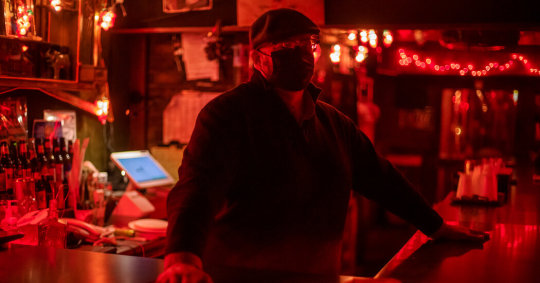
NEW ORLEANS — Last January, Polly Watts estimated how much alcohol she would need to make it through Mardi Gras at her bar, Avenue Pub — and then ordered considerably more than that. It’s a practice she and other bar owners here use to lock in savings that many liquor companies offer in the early months of the year.
“We had an Armageddon-level liquor stock,” Ms. Watts said. “It usually lasts us a few months.”
New Orleans has again entered Mardi Gras season — the big finale, Fat Tuesday, is Feb. 16 — and Ms. Watts, like many bar owners, has yet to sell much of the alcohol she purchased a year ago, just before the pandemic halted the city’s famous nightlife as the high season for festivals and tourism was set to begin. She doesn’t expect to go through her overstock of vodka, whiskey and beer anytime soon, even though Avenue Pub is on St. Charles Avenue, a main route for most of the large Mardi Gras parades.
That’s because this year’s official parades have been canceled. The balls, parties and other events that make up “the largest free party on earth” violate Covid-19 restrictions, which early this month were raised in New Orleans to levels not seen since the start of the pandemic, when the city struggled with one of the highest coronavirus caseloads anywhere.
Mardi Gras 2020 is remembered locally as the last gasp of pre-Covid normalcy, as well as an accelerant of the virus’s spread. So few people here expect this year’s edition to be anything like normal. It can’t be.
Infection rates in the city are at near-record levels. Current restrictions will be re-examined at the end of the month, said Sarah Babcock, director of public policy and emergency preparedness for the New Orleans Health Department. “What activities are going to be allowed on Mardi Gras is really dependent on what New Orleanians do today,” Ms. Babcock said. “But the Mardi Gras that the nation thinks of, the picture they have, is not going to happen.”
Still, Mardi Gras, a holiday with Christian (and pagan) underpinnings, can’t be canceled. “People are going to find a way to celebrate,” Ms. Babcock said. And in the absence of traditional programming, the focal point is likely to be the bars that showcase the music and drinking cultures so central to the city’s economy, identity and allure.
These businesses, which have been as damaged by the pandemic as any sector of the city’s life, face a holiday that embodies New Orleans’s spirit — the capacity for joy, the sense of community, the embrace of art and excess — in a year when no one knows what form the celebration will take, at a time when summoning that spirit could cause harm.
The bar scene here, which not even Hurricane Katrina fully shut down, has been brought to its knees by the pandemic, but it hasn’t been snuffed out. As current regulations forbid bars without food permits to serve indoors, the activity has largely moved outside, aided by relatively mild winters and laws that allow public consumption of alcohol. (Bars with food permits can serve indoors at 25 percent capacity, but can sell alcohol only with food. Mask-wearing and social distancing have been required in New Orleans since early in the pandemic.)
Serving the tourists who are bound to join costumed locals on the streets may amount to little more than selling to-go drinks and food for customers to carry as they stroll. At a news conference on Monday, Mayor LaToya Cantrell welcomed visitors for Mardi Gras while commanding them to obey pandemic restrictions, “so our residents and our folks at the forefront of hospitality are safe.”
Tom Thayer, the owner of d.b.a., a music club in the Faubourg Marigny neighborhood, is considering recruiting musicians to play outside his club on Frenchmen Street, a live-music corridor. His decision will depend on what happens with infection rates.
“Having done almost no business since last March, it’s very tempting to try and grab the money,” said Mr. Thayer, 54, “but not at the risk of prolonging this virus.”
Ms. Watts, 55, plans to decorate the Avenue Pub to resemble a Mardi Gras float, as many locals have already done to their homes. “I just want something that will make people smile when they drive by, even if they don’t stop,” she said.
The ban on close public contact made necessary by the pandemic has rendered it all but impossible for the city’s famed drinking businesses — from its historic music clubs and neighborhood beer joints to its vintage and modern temples of exacting cocktails — to be their true selves.
The 11 p.m. closing time in place for much of the pandemic has been jarring, not least for veteran bartenders like Chris Hannah, an owner of Jewel of the South, a bar and restaurant in the French Quarter.
Mr. Hannah is one of the most respected cocktail makers in a city where bartenders enjoy outsize reputations. After 20 years of bartending, he found himself home alone for nights on end as the severity of the pandemic came into focus. Increasingly worried about his health, he started eating raw garlic, in an effort to bolster his immune system, and became obsessive about yoga.
He also spent a lot of time at Jewel of the South in the months before its July reopening, tending to the pepper plants, marigolds and herbs he’d planted to create “a victory garden, for when this is over.”
“I was extremely worried about getting this disease, because of my age and race,” said Mr. Hannah, who is 47 and Black. “Usually at the end of the night, I always think I can have one more spirit while I’m reading. Now it’s echinacea tea.”
Stinging losses to New Orleans’s drinking life include the sale of the Saturn Bar and the permanent closings of Lost Love Lounge, Prime Example and the original Johnny White’s Bar, all idiosyncratic neighborhood institutions. Also for sale is the Golden Lantern, a French Quarter bar known as “the home of Southern Decadence,” an annual festival put on by the gay and lesbian community. Storied music venues like Tipitina’s, the Maple Leaf, the Howlin’ Wolf and Snug Harbor have been silenced, though some have turned to streaming live shows online.
Kermit Ruffins, the owner of Kermit’s Treme Mother-in-Law Lounge, said he hopes Mardi Gras will provide bars a much-needed financial lift. At the same time, he’d like revelers to take note of how much better the city was when the bars were at full strength, and what would be lost if the permanent closings turn, as many here fear, from a trickle to a stream.
“I was a kid who grew up in bars in the Lower Ninth Ward,” said Mr. Ruffins, 56, a prominent jazz trumpet player, singer and band leader. He got his start as a musician playing in local bars as a teenager, something he continued doing several times a week, until last spring. The loss of income from performing is one of the reasons he started a GoFundMe page to keep the Mother-in-Law afloat.
“The number of musicians in New Orleans that play in bars for a living is overwhelming,” he said. “It’s really scary right now.”
Mr. Ruffins apologized publicly for violating Covid-19 restrictions, like requiring masks and forbidding dancing — lapses that prompted to the city to temporarily close his bar in September. He said he takes safety seriously, going so far as to close on Fridays and Saturdays, to keep from having to turn away friends from the back patio on those otherwise busy nights.
But Mr. Ruffins and others also contend that bars are being policed more closely for violations than other businesses, and that the authorities are stricter with local patrons than they are with tourists on Bourbon Street. Kelder Summers, an owner of Whiskey & Sticks, a Scotch and cigar bar, worries about the damage that could cause Black neighborhoods.
“Bars are an integral part of wealth-building in our community,” said Ms. Summers, 54, who is also a local radio host. “Historically, to have a little speakeasy was an easy way for Black people to enter into the business realm.”
In an emailed statement, a City Hall spokesman wrote that “Code Enforcement teams have largely achieved compliance by verbal warning, rather than shut-downs and citations,” and that “no area has been unfairly or disproportionately targeted.”
Mark Schettler, general manager at Bar Tonique, a craft-cocktail bar in the French Quarter, says bars are reflexively treated as less-than-respectable businesses because of their association with vice. That perception contributes to customers’ poor treatment of bar employees, he said.
“Bars are 102 years past the repeal of Prohibition,” said Mr. Schettler, an activist for hospitality workers’ rights. “But that sense of criminalization is not gone.”
Enforcement is not the only issue that has put bar owners at odds with Mayor Cantrell. Early in the pandemic, the city allowed businesses licensed as restaurants to stay open in a limited capacity, while bars were shut down entirely. (Ms. Babcock, of the Health Department, said the city was following recommendations from the federal government.)
D.J. Johnson, who opened the New Orleans Art Bar on St. Claude Avenue last February, is still sore over what he sees as a lack of government support for bars in those early months. Still, he knows the real enemy is the virus.
“Nobody wants to be in an empty bar,” Mr. Johnson said. “But during Covid, you don’t want to be in a crowded bar, either. It’s a real conundrum.”
Mr. Johnson, 40, entered into a bar scene that is vastly different from what it was in the early 2000s, when quality cocktails and wine were hard to find outside restaurants. When Mr. Hannah moved to New Orleans in 2004, he saw an opportunity to turn Arnaud’s French 75, the bar inside a historic French-Creole restaurant, into a destination for craft cocktails that had been lost to history.
The city’s bar scene blossomed after Hurricane Katrina struck in 2005. The opening of Cure, in 2007, helped bring the modern craft-cocktail movement to New Orleans, as did the growing popularity of Tales of the Cocktail, an annual festival that draws guests from around the world.
Cure’s founder, Neal Bodenheimer, 44, is a partner in two other local businesses, including Vals, a bar and taqueria opened in July on Freret Street, an Uptown corridor that Cure helped transform. All of his places straddle the line between restaurant and bar — the reverse of the phenomenon in which local chefs and restaurateurs open gastro pubs and wine bars.
Mr. Bodenheimer’s businesses have ample outdoor seating, a blessing during a health crisis that has allowed him to rehire more employees. He has added a mandatory 20 percent tip to each check.
“It’s really important to realize that these people are putting their health and safety on the line,” he said. “They should have their income guaranteed.”
The essence of the city’s bar culture, New Orleanians are apt to argue, is found not among the tourists on Bourbon Street but in the small bars that dot its residential neighborhoods. The Mother-in-Law is a good example, as are the Kingpin, in Uptown, or Markey’s Bar, in Bywater — beer bars that serve as home base for locals during Mardi Gras, and that regulars treat like second homes the rest of the year.
T. Cole Newton joined a new generation of owners trying to preserve New Orleans neighborhood bars in 2010, when he took over an existing bar in Mid-City to open 12 Mile Limit.
“Any reasonable business person who wasn’t a starry-eyed 20-something would have tore it down,” said Mr. Newton, 37, who believes modern zoning laws make it unlikely that bars like his will be replaced if they close. “I feel like I’m carrying on the legacy of a neighborhood bar in a time when that’s increasingly important.”
Snake and Jake’s Christmas Club Lounge is an archetype of the form. It’s partly hidden between two homes on a dark, deeply cracked street a short walk, and a world removed, from the lush Tulane University campus.
Andrew Ledford has been working at Snake and Jake’s, which opened in 1994, for more than 20 years. Covid restrictions have forced him to step from behind the bar to usher guests through the narrow barroom to the rear patio. A bucket filled with oyster shells holds the back door open.
Mr. Ledford, 41, said he expects to serve out-of-towners during Mardi Gras. He’ll encourage them to return after the pandemic wanes, to see what the bar — and New Orleans — is “really like.”
“I’m grateful to be open,” he said. “But we’re a shadow of our self.”
Multiple Service Listing for Business Owners | Tools to Grow Your Local Business
www.MultipleServiceListing.com
from Multiple Service Listing https://ift.tt/2LJtV1w
0 notes
Text
Pick Your Poison

Fall activities like apple picking and leaf peeping are generally considered safe, but with record crowds and a COVID surge expected to collide this fall, locals are worried
In the initial months of the COVID-19 pandemic, the outpouring of New York City residents to surrounding rural areas offered a boon to Twin Star Orchards. The U-pick apple farm and maker of Brooklyn Cider House cider sits just outside the small village of New Paltz, New York, about 80 miles north of New York City and halfway to Albany.
Susan Yi, who founded the business along with her brother Peter, says a wave of transplants buying new homes in the Hudson Valley gave business a bump during the usual off-season of April and May. Newly remote workers with flexible schedules have driven more business on Fridays, too, and the farm has added live music, usually reserved for holidays, to bring people out on Saturdays. There was even a socially distanced Fourth of July pig roast on its sprawling outdoor pavilion.
But as fall approaches at Twin Star Orchards, Yi worries that the farm’s high season could bring as much trouble as much-needed income. “Fall is always very busy with late September [to] early October as the peak, with apple-picking and leaf-peeping drawing a lot of people to the area,” she says. “We are typically packed each weekend, so we are a little concerned about keeping the crowds spaced out during that time.”
As spring turned to summer, the Northeast began to get a grip on the COVID-19 pandemic. New York state made a miraculous about-face from the nation’s hotbed to a model for how to contain the pandemic with aggressive lockdowns and testing. It made nearby places like New Paltz safer too. However, the popularity of fall activities could undermine those trends by coaxing people out of their homes just as experts predict a second wave of cases.
With what we know about the spread of COVID-19, outdoor escapes like apple picking seem relatively safe, making these fall getaways especially attractive for cooped-up city dwellers and parents desperate to distract their kids. The brilliant reds and oranges of fall foliage — shining in the face of everything this year — can still be admired from the isolated safety of a family car. The smell of “world-famous” apple pies will still be wafting across New England, and the treats are just as easily devoured at six-foot-spaced outdoor tables. Country farms are the stuff of quarantine cottagecore dreams, where animals offer themselves for therapeutic cuddles and no one needs to shuffle off the sidewalk to maintain social distancing.
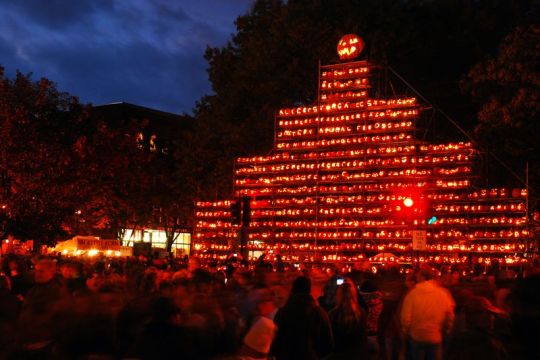
James Kirkikis / Shutterstock
The annual pumpkin festival in Keene, New Hampshire, with its signature tower, attracts thousands of visitors each year
But as tempting as this autumnal fantasy and its perceived safety may seem, the crowds it’s expected to draw to rural areas are inspiring mixed feelings among local business owners. After six months of financial hardship, including a delayed start to summer travel, some hope a fall boom will compensate for lost business. Others, fearing the potential for super-spreaders to hide among the pie stands and farm rows, worry that travelers could bring a second wave of infections to their doorsteps.
In May 2019, Greenleaf opened in Milford, New Hampshire, a small town famous for its pumpkin festival and leaf-peeping. The restaurant was only a few months old for its first festival in October last year. “Seeing all the people from the surrounding communities and traveling from afar to take part in this festival in such a small town was great to see,” says chef-owner Chris Viaud. “We were like, ‘Next year, we’re going to do this big. We’ll make sure we’re ingrained in the community and take a bigger part in this.’” Now the restaurant is in limbo as the town decides whether or not to cancel this year’s pumpkin festival.
Like nearly all other restaurants across America, Greenleaf is struggling with reduced traffic due to COVID-19. While it has received financial assistance from government programs, that can only take the restaurant so far, Viaud says, and he’s relying on business to pick up in the fall. Even if the pumpkin festival does get canceled, he still expects people will want to travel, and that puts him in a tricky position. “It’s a tough conversation. We have to think of ourselves and the wellness of our staff, but then the flip side of that is the wellness of the business,” he says.
Even in areas of the Northeast traditionally known more for summer and winter activities, fall has become an unexpected fulcrum of seasonal tourism. In Stowe, Vermont, for instance, summer hiking and winter skiing drive most tourist traffic, but summer travel was dampened by the coronavirus’s first wave, and Vermont’s popular ski mountains may shut down this winter. Local businesses need customers to show up in the next few months.
That might be tricky for Plate, a popular Main Street restaurant in Stowe that’s balancing its responsibility to locals against its dependence on tourists. “Early when we very first opened [for outdoor dining in May], we saw a lot of locals coming back to support us,” says chef-owner Aaron Martin. “Once people started traveling more, we noticed that it was mostly tourists, and our locals were feeling safer to stay away.” Martin says locals have returned tentatively, but they prefer the restaurant’s small, 10-seat patio to the indoor dining room — even at the 40 percent capacity it’s implemented to maintain social distancing. Some customers refuse to dine altogether if they can’t be seated outside. The chef chalks up their hesitance in part to the fact that out-of-state visitors tend not to follow Vermont’s 14-day mandatory quarantine for travelers. As temperatures drop, the restaurant will eventually have to pack up the outdoor seating, sacrificing the valuable added revenue along with it.
Viaud and Martin agree the potential for a second wave makes it difficult to make plans for the next few months. “Everyone’s listening to the media. In the fall, there is a scare of another spike. What does that mean for the businesses around?” Viaud wonders. Martin has no doubt about what would happen in Vermont. “We have a great governor who’s done a wonderful job. If we have a second wave, he’ll shut us all down again,” he says.
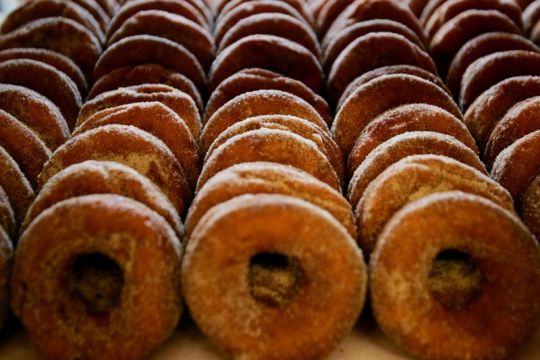
Boston Globe via Getty Images
Fresh cider donuts at Cider Hill Farm in Amesbury, Massachusetts
While some people might be stressing about the approaching autumn, apple trees and pumpkin vines are forging ahead at full speed. “The farm doesn’t know a pandemic from a regular year. The fruit’s going to grow either way,” says farm operations manager Jay Mofenson of Lookout Farm in South Natick, Massachusetts. “We have certain fixed expenses of equipment needs and labor needs that, regardless of the pandemic, have to continue.”
Lookout was founded in 1651, making it one of the nation’s oldest continually operating farms. Today the 180-acre orchard is home to 55,000 trees, drawing around 50,000 eager amateur apple pickers each year. While the farm does sell some apples to wholesale distributors, Mofenson says, “Agritourism is really our primary focus.”
Luckily for the farm, summer peach season is typically much slower than the fall, only attracting an average of 5,000 visitors in a normal year. Not only does this mean Lookout didn’t sacrifice much U-pick business during the initial wave of the pandemic, but it also gave Mofenson and his team a chance to reconfigure the entire operation ahead of the anticipated fall crowds. They re-envisioned the customer experience from the moment a guest gets out of their car to the moment they return to the parking lot. They nixed the trains that usually ferry people to the fruit trees, established a one-way path through the rows, and set up a reservation system with caps on the number of pickers per hour.
Across the country, in Camarillo, California, home of the Abundant Table, the leaves aren’t much of a draw, but the farm still offers a classic fall experience. Programming extends well beyond U-pick to include a produce shop, educational programs for kids and adults, open community farming initiatives, and other BIPOC-focused nonprofit efforts.
All of these programs were paused in the initial days of the pandemic, but Linda Quiquivix, institutional sales partnerships and CSA manager, says the team is planning their return in the coming months, with strict social-distancing measures in place. “The really cool thing about us is we’re a collective. We’re a democratic workplace,” she says. “We get to decide what conditions we work under. We always keep abreast of the [COVID-19] situation, so we don’t have any problems codifying plans according to new realities.”
Quiquivix explains that after the highly publicized breakdown of the food system early in the pandemic, community farming, U-pick, and the produce stand give people a chance to support local farming, which many customers are recognizing as increasingly important. The Abundant Table is also collaborating with the Rodale Institute, a nonprofit focused on organic farming, to set up a U-pick, no-till pumpkin patch. As kids shift to remote learning in the fall, Quiquivix is hoping the school district will allow a class of sixth graders to come help analyze the pumpkin patch once a week, not only to discuss maintaining soil carbon by avoiding tilling, but also the pre-colonial farming practices of the Chumash people on that land.
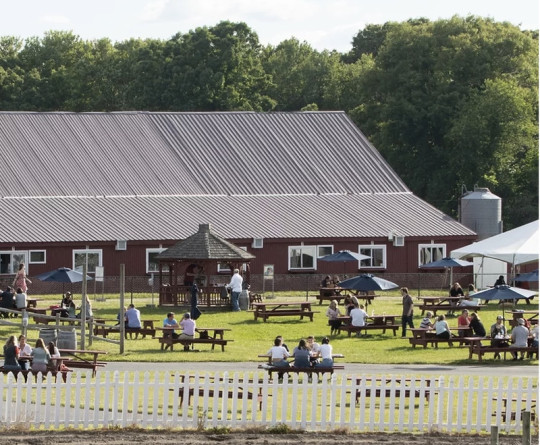
Lookout Farm
Lookout Farm in Massachusetts has transformed its outdoor dining area for social distancing.
Farther north, at R. Kelley Farms in Sacramento, owner Ron Kelley committed to his summer crops back in April, planting his seeds when rumors still indicated the pandemic would clear up soon. U-pick typically accounts for 60 percent of business for the 28-year-old farm, and the summer high season has been going well. Kelley has implemented social distancing and a reservation system, allowing him to host visitors from as far as 100 miles away to pick crowder, purple hull, and black-eye beans.
But that’s all changing in the fall, which doesn’t drive nearly as much business for him. The potential costs outweigh any potential gains for offering his usual winter greens for U-pick. “My business is the least of my concerns. I’m worried about my health,” he says. “I’m 72 years old and do not want to take any chances of getting ill from working outdoors in the fall and winter.”
While most restaurants and farms plan to do everything they can to stay in business, Kelley is more open about the potential of closing up shop. “I’m at the age that this may be the straw that breaks the camel’s back.” he says. “Once I finish this year, then I’ll take a hard look at it, decide whether I want to gamble again next year or what exactly I want to do.”
“It’s going to be a challenging year. I can’t say where we’re going to end up, financially speaking,” Mofenson says bluntly. But there’s always an upside to working through the crisis. “The farm is a very special place to us, to a lot of people. The benefit is tons of comments all the time from people about how grateful they are to have an opportunity to be outdoors, to see the kids smiling. It’s really been a silver lining to this whole situation.” He adds, “Hopefully everyone has a better 2021.”
from Eater - All https://ift.tt/351zsYv
https://ift.tt/3jKUyhY

Fall activities like apple picking and leaf peeping are generally considered safe, but with record crowds and a COVID surge expected to collide this fall, locals are worried
In the initial months of the COVID-19 pandemic, the outpouring of New York City residents to surrounding rural areas offered a boon to Twin Star Orchards. The U-pick apple farm and maker of Brooklyn Cider House cider sits just outside the small village of New Paltz, New York, about 80 miles north of New York City and halfway to Albany.
Susan Yi, who founded the business along with her brother Peter, says a wave of transplants buying new homes in the Hudson Valley gave business a bump during the usual off-season of April and May. Newly remote workers with flexible schedules have driven more business on Fridays, too, and the farm has added live music, usually reserved for holidays, to bring people out on Saturdays. There was even a socially distanced Fourth of July pig roast on its sprawling outdoor pavilion.
But as fall approaches at Twin Star Orchards, Yi worries that the farm’s high season could bring as much trouble as much-needed income. “Fall is always very busy with late September [to] early October as the peak, with apple-picking and leaf-peeping drawing a lot of people to the area,” she says. “We are typically packed each weekend, so we are a little concerned about keeping the crowds spaced out during that time.”
As spring turned to summer, the Northeast began to get a grip on the COVID-19 pandemic. New York state made a miraculous about-face from the nation’s hotbed to a model for how to contain the pandemic with aggressive lockdowns and testing. It made nearby places like New Paltz safer too. However, the popularity of fall activities could undermine those trends by coaxing people out of their homes just as experts predict a second wave of cases.
With what we know about the spread of COVID-19, outdoor escapes like apple picking seem relatively safe, making these fall getaways especially attractive for cooped-up city dwellers and parents desperate to distract their kids. The brilliant reds and oranges of fall foliage — shining in the face of everything this year — can still be admired from the isolated safety of a family car. The smell of “world-famous” apple pies will still be wafting across New England, and the treats are just as easily devoured at six-foot-spaced outdoor tables. Country farms are the stuff of quarantine cottagecore dreams, where animals offer themselves for therapeutic cuddles and no one needs to shuffle off the sidewalk to maintain social distancing.

James Kirkikis / Shutterstock
The annual pumpkin festival in Keene, New Hampshire, with its signature tower, attracts thousands of visitors each year
But as tempting as this autumnal fantasy and its perceived safety may seem, the crowds it’s expected to draw to rural areas are inspiring mixed feelings among local business owners. After six months of financial hardship, including a delayed start to summer travel, some hope a fall boom will compensate for lost business. Others, fearing the potential for super-spreaders to hide among the pie stands and farm rows, worry that travelers could bring a second wave of infections to their doorsteps.
In May 2019, Greenleaf opened in Milford, New Hampshire, a small town famous for its pumpkin festival and leaf-peeping. The restaurant was only a few months old for its first festival in October last year. “Seeing all the people from the surrounding communities and traveling from afar to take part in this festival in such a small town was great to see,” says chef-owner Chris Viaud. “We were like, ‘Next year, we’re going to do this big. We’ll make sure we’re ingrained in the community and take a bigger part in this.’” Now the restaurant is in limbo as the town decides whether or not to cancel this year’s pumpkin festival.
Like nearly all other restaurants across America, Greenleaf is struggling with reduced traffic due to COVID-19. While it has received financial assistance from government programs, that can only take the restaurant so far, Viaud says, and he’s relying on business to pick up in the fall. Even if the pumpkin festival does get canceled, he still expects people will want to travel, and that puts him in a tricky position. “It’s a tough conversation. We have to think of ourselves and the wellness of our staff, but then the flip side of that is the wellness of the business,” he says.
Even in areas of the Northeast traditionally known more for summer and winter activities, fall has become an unexpected fulcrum of seasonal tourism. In Stowe, Vermont, for instance, summer hiking and winter skiing drive most tourist traffic, but summer travel was dampened by the coronavirus’s first wave, and Vermont’s popular ski mountains may shut down this winter. Local businesses need customers to show up in the next few months.
That might be tricky for Plate, a popular Main Street restaurant in Stowe that’s balancing its responsibility to locals against its dependence on tourists. “Early when we very first opened [for outdoor dining in May], we saw a lot of locals coming back to support us,” says chef-owner Aaron Martin. “Once people started traveling more, we noticed that it was mostly tourists, and our locals were feeling safer to stay away.” Martin says locals have returned tentatively, but they prefer the restaurant’s small, 10-seat patio to the indoor dining room — even at the 40 percent capacity it’s implemented to maintain social distancing. Some customers refuse to dine altogether if they can’t be seated outside. The chef chalks up their hesitance in part to the fact that out-of-state visitors tend not to follow Vermont’s 14-day mandatory quarantine for travelers. As temperatures drop, the restaurant will eventually have to pack up the outdoor seating, sacrificing the valuable added revenue along with it.
Viaud and Martin agree the potential for a second wave makes it difficult to make plans for the next few months. “Everyone’s listening to the media. In the fall, there is a scare of another spike. What does that mean for the businesses around?” Viaud wonders. Martin has no doubt about what would happen in Vermont. “We have a great governor who’s done a wonderful job. If we have a second wave, he’ll shut us all down again,” he says.

Boston Globe via Getty Images
Fresh cider donuts at Cider Hill Farm in Amesbury, Massachusetts
While some people might be stressing about the approaching autumn, apple trees and pumpkin vines are forging ahead at full speed. “The farm doesn’t know a pandemic from a regular year. The fruit’s going to grow either way,” says farm operations manager Jay Mofenson of Lookout Farm in South Natick, Massachusetts. “We have certain fixed expenses of equipment needs and labor needs that, regardless of the pandemic, have to continue.”
Lookout was founded in 1651, making it one of the nation’s oldest continually operating farms. Today the 180-acre orchard is home to 55,000 trees, drawing around 50,000 eager amateur apple pickers each year. While the farm does sell some apples to wholesale distributors, Mofenson says, “Agritourism is really our primary focus.”
Luckily for the farm, summer peach season is typically much slower than the fall, only attracting an average of 5,000 visitors in a normal year. Not only does this mean Lookout didn’t sacrifice much U-pick business during the initial wave of the pandemic, but it also gave Mofenson and his team a chance to reconfigure the entire operation ahead of the anticipated fall crowds. They re-envisioned the customer experience from the moment a guest gets out of their car to the moment they return to the parking lot. They nixed the trains that usually ferry people to the fruit trees, established a one-way path through the rows, and set up a reservation system with caps on the number of pickers per hour.
Across the country, in Camarillo, California, home of the Abundant Table, the leaves aren’t much of a draw, but the farm still offers a classic fall experience. Programming extends well beyond U-pick to include a produce shop, educational programs for kids and adults, open community farming initiatives, and other BIPOC-focused nonprofit efforts.
All of these programs were paused in the initial days of the pandemic, but Linda Quiquivix, institutional sales partnerships and CSA manager, says the team is planning their return in the coming months, with strict social-distancing measures in place. “The really cool thing about us is we’re a collective. We’re a democratic workplace,” she says. “We get to decide what conditions we work under. We always keep abreast of the [COVID-19] situation, so we don’t have any problems codifying plans according to new realities.”
Quiquivix explains that after the highly publicized breakdown of the food system early in the pandemic, community farming, U-pick, and the produce stand give people a chance to support local farming, which many customers are recognizing as increasingly important. The Abundant Table is also collaborating with the Rodale Institute, a nonprofit focused on organic farming, to set up a U-pick, no-till pumpkin patch. As kids shift to remote learning in the fall, Quiquivix is hoping the school district will allow a class of sixth graders to come help analyze the pumpkin patch once a week, not only to discuss maintaining soil carbon by avoiding tilling, but also the pre-colonial farming practices of the Chumash people on that land.

Lookout Farm
Lookout Farm in Massachusetts has transformed its outdoor dining area for social distancing.
Farther north, at R. Kelley Farms in Sacramento, owner Ron Kelley committed to his summer crops back in April, planting his seeds when rumors still indicated the pandemic would clear up soon. U-pick typically accounts for 60 percent of business for the 28-year-old farm, and the summer high season has been going well. Kelley has implemented social distancing and a reservation system, allowing him to host visitors from as far as 100 miles away to pick crowder, purple hull, and black-eye beans.
But that’s all changing in the fall, which doesn’t drive nearly as much business for him. The potential costs outweigh any potential gains for offering his usual winter greens for U-pick. “My business is the least of my concerns. I’m worried about my health,” he says. “I’m 72 years old and do not want to take any chances of getting ill from working outdoors in the fall and winter.”
While most restaurants and farms plan to do everything they can to stay in business, Kelley is more open about the potential of closing up shop. “I’m at the age that this may be the straw that breaks the camel’s back.” he says. “Once I finish this year, then I’ll take a hard look at it, decide whether I want to gamble again next year or what exactly I want to do.”
“It’s going to be a challenging year. I can’t say where we’re going to end up, financially speaking,” Mofenson says bluntly. But there’s always an upside to working through the crisis. “The farm is a very special place to us, to a lot of people. The benefit is tons of comments all the time from people about how grateful they are to have an opportunity to be outdoors, to see the kids smiling. It’s really been a silver lining to this whole situation.” He adds, “Hopefully everyone has a better 2021.”
from Eater - All https://ift.tt/351zsYv
via Blogger https://ift.tt/3lL4V72
0 notes
Text
The Netherlands: Week Two
We packed up the cars and our friends drove George, Saskia and myself to the local train station where we hopped on the next train departing to Amsterdam. We got off at Amsterdam Central station and caught the tram to Leidseplein, the location of our hotel and where Saskia would be collected by her friend who she would be staying with for the next week. We said our goodbyes and made our way to the ‘King Hotel’ to check in.
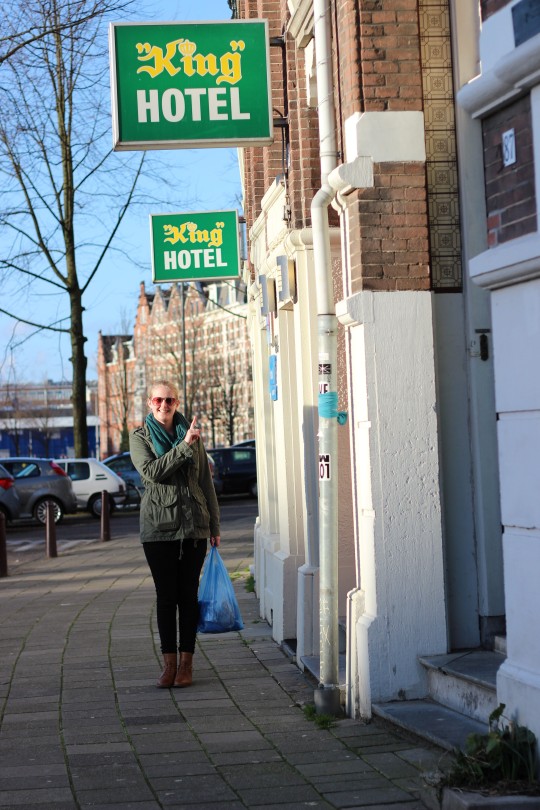
Not the most attractive of hotels but in the best location for tourists! We were right on the canal (with a canal view room), a mere 60 seconds from the centre of Leidseplein and the tram stop. Everything we needed was on our doorstep, including Vondel Park, the Bulldog, the Heineken museum and much more.
I’ve left this part of my blog way too long to remember everything clearly but i will tell you the highlights and what i would recommend. First of all the hotel is perfect for travelers on a budget and the location is perfect for both food and drinks and also for quick travel around the city.
Leidseplein has a wide range of eateries all within walking distance. My favourite for general cuisine was ‘In De Buurt’, a very modern and classy restaurant with complete wine list and bar also available. They served fantastic rustic food for a reasonable price. The other restaurant i cannot forget is about 20 minutes walk from Leidseplein square or 10 minutes on the tram and goes by the name ‘De Bekeerde Suster’. This one is great for people who love beer and BBQ ribs as much as i do! They have a generously sized menu consisting of honest, hearty meals and a huge range of beers, ales and lagers on both draught and by the bottle.
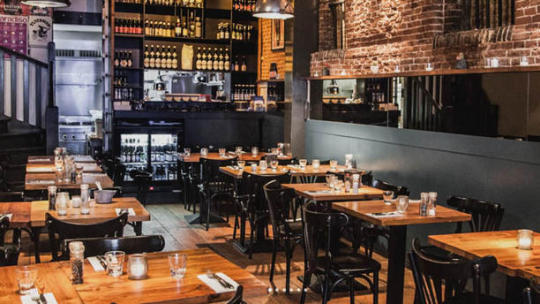
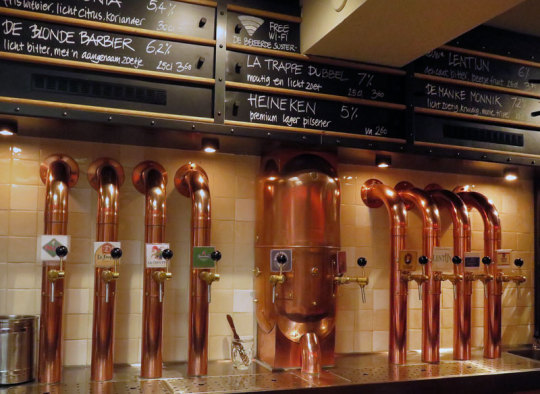
When it comes to drinking, the famous spot to be is ‘The Bulldog’. Once you go you will understand why. This place is jam-packed full every night of the week and open till late. They have many around the city but the biggest is in Leidseplein square. It’s a place you can go for live music, cocktails, sports and beers on the ground level or the place you can go to smoke your favourite seed alongside freshly squeezed juice, closely followed by a mountain of pancakes in the lower level. They also have cafe’s under their brand name where you can go for special brewed tea and space cakes. The best night we had in there might even have been on a supposedly ‘quiet’ Monday night (even though to our virgin eyes it seemed full) to listen to a live Jazz band. Fantastic atmosphere! If your style is a little different to mine then fear not as Leidseplein square has something for everyone, from comedy clubs, to dive bars, to live rock music, to swanky cocktail bars playing lounge music. The majority of these places also have outside seating with overhead heating, perfect for a romantic glass of wine and people watching.
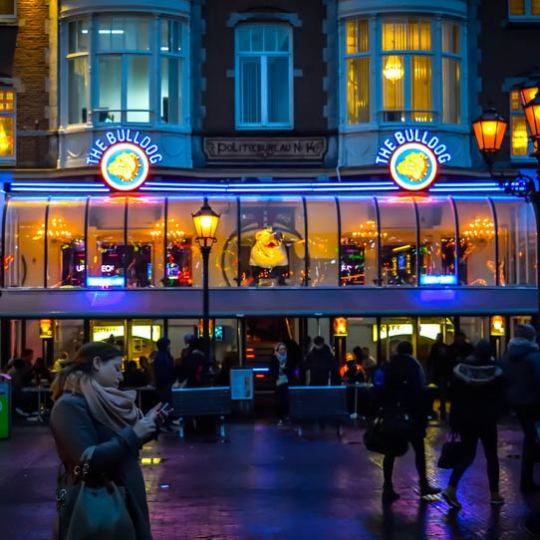
As for museums, site seeing and excursions, here are my top 10;
1. ‘Anne Frank’s Huis’ is of course a must. People all over the world, when they think of Amsterdam, connect it to Anne Frank (give or take a few other attractions!) and are eager to feel the history behind it. When i say ‘feel’ i mean feel... the aura inside is enough to make your hairs stand on end. The building now, due to the influx of tourists is remarkably big as far as Amsterdam houses go but only because it’s been extended to fit in a reception, cafe and gift shop. However, the house itself is preserved and is the absolute original. We paid a mere €9 each for a full tour plus the extra optional costs in the cafe and gift shop.
2. A canal cruise was also one of the best things we did in the city. It’s called ‘100 Highlights Cruise’, costs €15pp and lasts 60 minutes. The description is in the title but i’ll tell you anyway! It takes you on a guided tour along some of the canals, explaining what you are seeing along the way through headphones. (These headphones are included in the ticket price and give you the option to select which language you desire). We were lucky enough a witness an unusual and rather funny occurrence on our trip, as half way along one of the canals we narrowly had to squeeze past a water skip. It was obviously supplied by the council to do some canal cleaning, much like a road-sweeper but the range and peculiarity of the objects they were retrieving from the bottom of these canals were incredible. I’m sure there are more bicycles 6ft under water than there are in the Tour De France! The local joke when tourists ask ‘How deep are the canals?’ is for the locals to answer 'Three meters; one meter of water, one meter of mud and one meter of bikes’. Only in Holland.
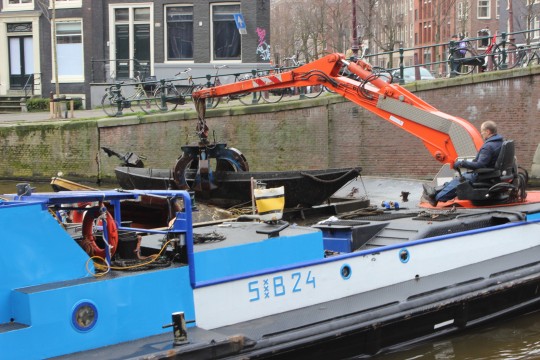
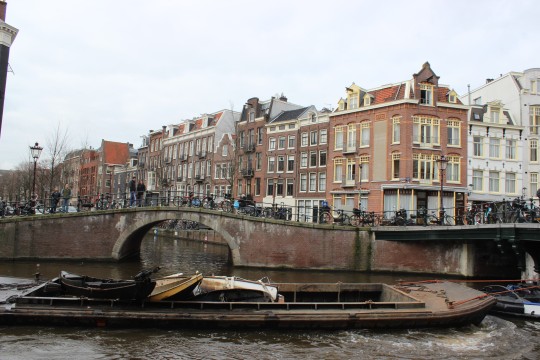
3. Vondel Park! This was such a beautiful part of the city, full of lakes and grassy pastures and is again only about 10 minutes walk from the ‘King Hotel’. It became clear that this must be the place-to-be in the summer months, as scattered around the park where huge stages and remnants of concerts and festivals. However, even in February the park was beautiful and full of life, both wildlife and human life. Many people jogging, walking the dogs, busking, feeding the ducks, taking photographs. It really is a hub of life all year round. Take a stroll with your morning coffee and breathe in the fresh air, i assure you it won’t be a waste of time.

4. I am not a massive fan of museums in the true sense of the word as i tend to enjoy other attractions a lot more but having said that the ‘Rijks Museum’ might have been an exception for me. This place was truly stunning inside and out. Even at first glance it is a treat for the eyes because of it’s enormous size, regal design and the big ‘I AMsterdam’ letters outside it’s front door. The entrance fee is €17.50pp for a one day ticket allowing you to stay as long as you wish and includes a floor plan.
5. The Sex Museum was possibly the most entertaining. I’ll leave this to your imagination but it is definitely worth a visit and cheap entrance fee. It’s located in ‘Damrak’ the area exactly where the central station is.
6. The Heineken was also one of the few museums i enjoy, one where it is 100% acceptable to drink whilst inside the building. It is actually a distillery turned into an interactive tour in the heart of the city. It’s an 8 minute tram ride from Leidseplein and costs €16pp entrance and tour, if booked online.
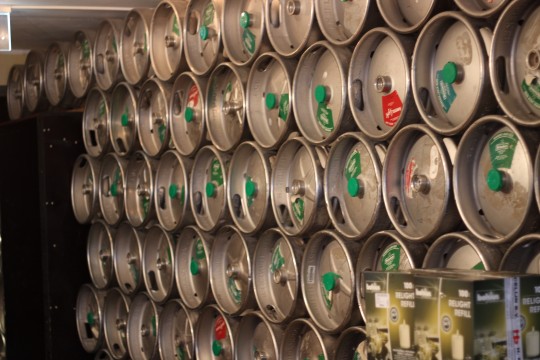

7. The Red Light District is a real eye-opener and a 100% must see! The district is located between Nieuw Market and Dam Square and very close to the central station (15 minute by tram from Leidseplein). We visited here in the night time, purely because we thought it was the logical thing to do so i cannot tell you what there has to offer in the daytime. However, in the night time, the long street with the canal running through the middle, is lit up exactly how you would imagine in neon lights and offers you everything you could want. There you can wander through the side streets and admire the gorgeous women behind the red doors, peruse the sex shops, attend a live sex show or one of the countless strip clubs. The hidden gem is the VIP area on one of the side streets. Inside here are again beautiful prostitutes behind red doors but the most expensive and elite ones. Spoiler: 75% of these ones are actual men and i swear they are more stunning than the regular women!
8. A flower market may sound boring to most people but I personally adored the famous one they have in Koningsplein! The edge of the canal is laced with floating stalls selling thousands of different types of flowers and seeds, whilst on the other side of the walkway you have many tourist and souvenirs shops, so taking a walk down there will definitely keep you entertained for a few hours. This is only a short 10 minute walk from Leidseplein and is open everyday, normal working hours, even on Sunday.
9. Dam Square lies in the historical district of Amsterdam and is a lovely day out to take in the sites of the heart of the city. It’s a short walk from central station to Dam Square, a place filled with beautiful architecture, a combination of highstreet and designer shops, cafes and restaurants. Here is the perfect place to do all your shopping at once, souvenirs, gifts for the family and a quick stop in H&M or Zara along the way, interspersed with pit stops at quaint cafes within easy reach. Here the buildings are magnificent and include structures such as, the Royal Palace, the National Monument, Madame Tussaud’s and many more. The square is never quiet and always has some kind of event going on. Whether it be a fun fair, a market or just full of some of the many street performers. We saw an incredible magician the day we passed through!
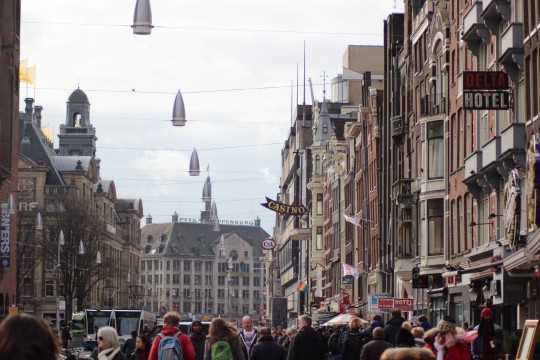
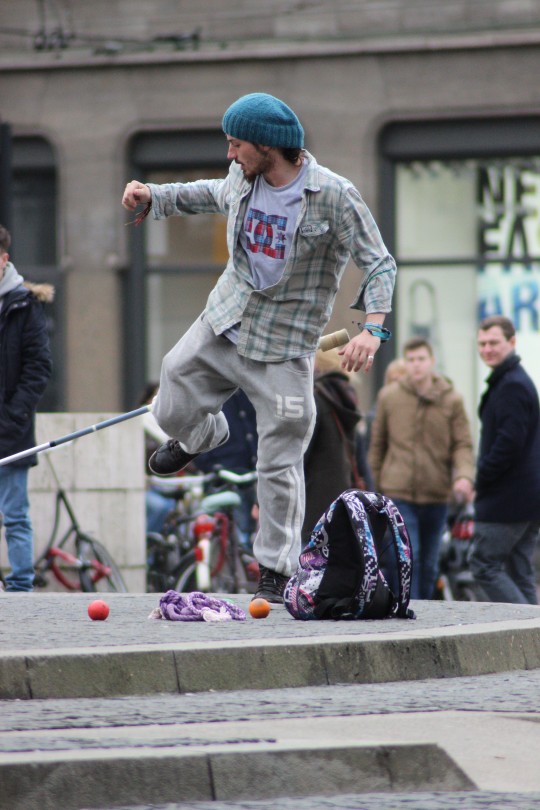
10. The Albert Cuyp Market! This for me was one of my favourites! It’s located in De Pijp, a 12 minute tram journey from Leidseplein and is open every Monday - Saturday. This place is incredible, doused in stalls selling everything from antiques to clothes and serving up street food. Here you can buy local fish from the mongers, real Dutch cheese or watch them make traditional baby pancakes or stroopwafles in front of your eyes.
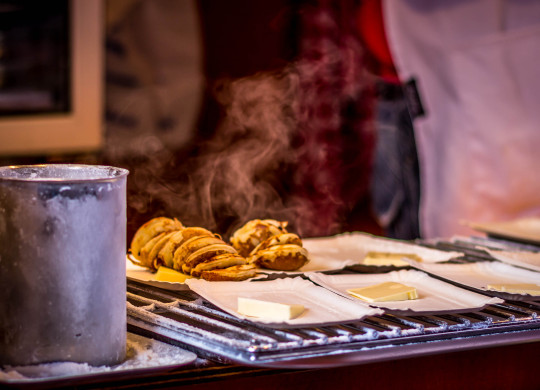
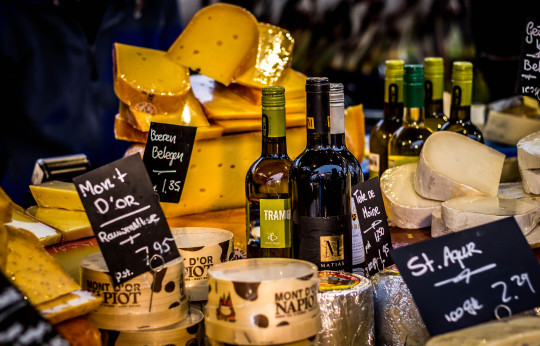
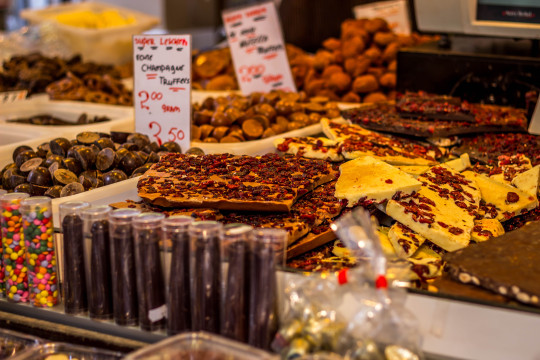

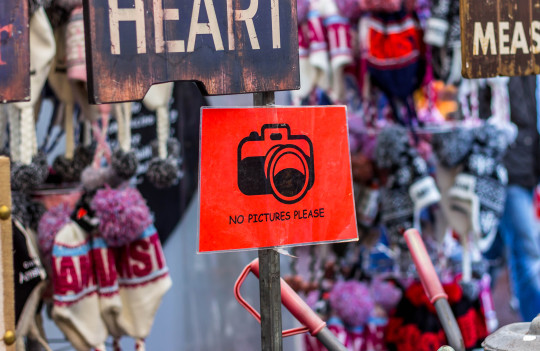
That sums up our busy week in the city! We stayed for 7 days and for us it was the perfect length of time but if you are organised (people who wake up early!) or on a budget I would say you can easily do Amsterdam in 3 or 4 days and manage to squeeze in the highlights. It’s a fabulous city and has something to offer for all walks of life.
One other important tip i should mention is to purchase a travel card. You can get these from the kiosks or at central station and you choose how many days you want the pass for. The prices change depending on which deal you select. This card includes trams and buses and you just swipe the card at the available machines once on board your form of transportation.
One day i hope to return and see it familiar, not with flustered eyes. I would do it all again in a heartbeat. Here are my personal favourite photos of the city break...


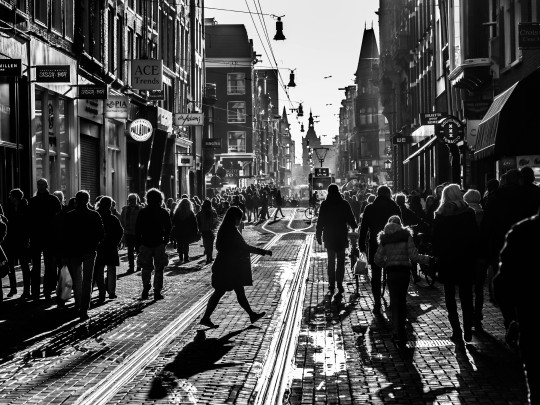
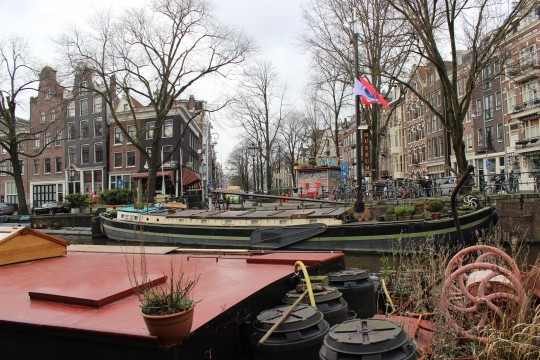
2 notes
·
View notes
Photo

With a plethora of things to do in Florence and considered one of the important cultural and historical hubs of Italy it’s easy to see why so many travelers flock to this city. what
Florence, or Firenze in Italian, is the quintessential Italian riverside city filled with some of the countries best sights and foods. It’s famed for world-class cuisine, museums, classic works of art, and the surrounding Tuscan countryside. The architecture in Florence pulls you in and begs for you to get lost in its historic heart.
Florence is known for being the birthplace of the Renaissance period and packed full of history. When you walk the narrow cobbled stone streets it appears as if little has changed with marble basilicas, dark chapels, gas lanterns, and enchanting frescos. Florence is a located in the central-north of Italy known as Tuscany, halfway between the landlocked country of San Marino and the world’s most iconic leaning structure, Pisa.
When many think of Italy, it’s generally the Colosseum, Leaning Tower of Pisa and the canals of Venice along with delicious treats of gelato, pizza and pasta and while that’s generally a true statement, places like Florence are becoming more and more popular to those wanting to see the other side of Italy.
Florence out of all the places I visited in Italy had the most charm about it with a constant relaxed vibe from the river Arno to the gardens of Boboli and beyond. This Italian city is easily a highlight of any trip to Italy!
Table of Contents
1.)
2.)
3.)
4.)
5.)
6.)
7.)
8.)
9.)
10.)
11.) Eat Your Way Through Tuscany
12.)
13.)
14.)
15.)
1.) Wander Through Boboli Gardens
Giardino di Boboli or The Boboli Gardens tops the list of the most impressive gardens I have visited anywhere in Europe and I am generally not fond of heavily mowed lawns, manicured hedges, and water fountains, but the caretakers of The Boboli Gardens do an exquisite job in maintaining an extremely large area of land to such perfection.
I was born and raised on a farm, 500 kilometers from the closest city and often feel overwhelmed by the chaos of cities, to cope I often seek out the botanical gardens for peace and quiet. For me, it takes the top spot for what to do in Florence.
Located behind the Palazzo Pitti a grand Rennaisance palace that was built in 1458. The historic gardens date back to the 16th century and are considered the first of the grand Italian gardens famed for the century.
There is a certain charm that lay over Giardino di Boboli that reminds of the movie ‘The Secret Garden’. Giardino di Boboli is also a great place to watch the sunset over The Arno River as the last rays of light hit Piazza Del Duomo.
Price: €10 Full / €5 Reduced (Summer March 1st – October 31st) €6 Full/ €3 Reduced (Winter November 1st – February 28th)
Hours: Open every day from 8:15 a.m. — Closing times vary from 4:30 p.m. to 7:30 p.m.
Location: Plaza Piti
2.) Gaze Upon Duomo di Firenze (Florence Cathedral)
Florence’s most famous building, Piazza Del Duomo
The beating heart of Florence has to be Piazza Del Duomo and the Florence Cathedral. The cathedral is one of the world’s largest cathedrals built in the late 12th century and is an icon of Florence and visible throughout the city.
The interior of the Duomo is fascinating the dome was the largest in the world until the modern era with new construction materials. is great seeing from the inside with ancient monuments and artifacts, this cathedral is best seen from various vantage points throughout Florence especially during sunset and sunrise as the roof and dome of the cathedral turns a bright orange and red which dominates the city landscape.
If you want to explore the cathedral, you might want to do so early as possible to avoid the lengthy wait times. Entry into the cathedral is free; however, if you wish to visit the crypt dating back to the 15th century, the dome, baptistery, and the museum are all combined into the cumulative ticket for €18. If you’re for a more in-depth experience you can book a guided tour along with an expedited ticket to avoid the lines here
Price: Free — €18 Combined Ticket (Entry to crypt, baptistery, dome, and museum)
Hours: Everyday 8:30 a.m. — 7:00 p.m. (Saturday until 5:40 p.m.)
Location: Duomo di Firenze
Book Your Guide for the Cathedral!
3.) Explore the Arno River
Exploring the Arno River
The waterways of Europe were the original highways and sources of the trade so many classic European cities and towns are based along waterways. Florence sits on the Arno River and it is the central point of the city. A walk along the central waterway is an awesome way to take the historic city.
A walk here is wonderful for photographs of Florence and provides great viewpoints of the famed Ponte Vecchio Bridge. The Arno is a classic Italian river with an array of bridges some few hundred meters apart meaning you can walk from one side to the other with ease to catch views from a different perspective.
Quick fact: if you follow The River Arno for long enough, it will lead almost directly to the Leaning Tower of Pisa and the Mediterranean!
4.) Cross the Ponte Vecchio Bridge
Florence’s most famous bridge
Just as the rivers of cities were vital lifelines of cities so were the bridges. With its long history, Italy is filled with famed bridges such as the Rialto Bridge of Venice and Ponte Vecchio of Firenze. The Arno River has more than one bridge that crosses its flow yet none of those bridges hold more attention that the famed Ponte Vecchio.
The original bridge was constructed by the Romans and dates back millennia, but the current bridge dates were constructed in 1345 after several versions were swept away in floods. Its historical significance was even spared by Hitler as the Germans destroyed all the bridges in the region during their retreat in 1945, except for the bridge under explicit instructions.
Over the centuries the Ponte Vecchio has been home to a number of shops that line the bridge. Originally the shop fronts were occupied by butchers who would cut and chop up meat to sell while discarding the scraps into The Arno. Now, the shops are occupied by jewelers and art dealers. Each storefront has its own distinct color which can be viewed from standing upon the Ponte Santa Trinita Bridge or roads running adjacent to The Arno River.
At one point in time, Ponte Vecchio was the only bridge to connect the north and south sides of the river and a daily commute past the butcher storefronts wasn’t exactly an ideal thing to do, especially early in the morning. During the rule of The Medici, they ordered that jewelry stores replace the butchers and the throwing of the meat into The Arno be ceased.
Location: Ponte Vecchio Bridge
5.) Enjoy the view from Piazzale Michelangelo
Florence has few viewpoints as good as the lookout high about the banks of the Arno River; however, getting there is a bit of a burner on the calves or if you prefer, take a bike or Vespa to the top as the views are the best anywhere in Florence.
If you know what Florence looks like, it was probably taken from Piazzale Michelangelo. Getting that epic shot of the city can be tricky due to it being one of the most photographed places in Italy so get there extra early for sunrise shots or early for sunset shots. One of our favorite times to photograph in busy spots is what is commonly referred to as the blue hour just after sunset as most photographers leave once the sun drops below the horizon. If you’re a photographer wondering what to do in Florence at sunset this is a solid photo spot.
Location: Piazzale Michelangelo
6.) Climb the Tower at Palazzo Vecchio
Walking the streets of Florence
One of the cool things about Florence is that most of its main tourist attractions are within 10 minutes walking distance of one another and if you go to the famous lookout of Giardino del Bardini, you will see just how close everything is together.
The Palazzo Vecchio is the only other structure in Florence that will give the Piazza del Duomo a run for its money in size. Like most cathedrals and churches in Italy and Florence, the Palazzo Vecchio is one of the oldest and dates back to the late 12th century.
What you will notice about Palazzo Vecchio is its castle-like tower or torre d’Arnolfo which stands almost as tall as the dome on Duomo. The tower itself is nearly the height of a football field, 94 meters to be exact which can be climbed from the inside revealing a spectacle of views once at the top.
If you are keen to take the narrow staircase to the top of the tower, make sure to get there early as crowds build to lengthy ques early.
Price: €14 Full / €12 Reduced Museum & Tower
Hours: Everyday 8:30 a.m. — 7:00 p.m. (Saturday until 5:40 p.m.)
Location: Palazzo Vecchio
7.) Explore the Palazzo Pitti
If you are planning to walk around the manicured gardens of Boboli, be sure to spend an hour or so discovering some of Florence’s most delicate treasures and artifacts in Palazzo Pitti. The palace and gardens at one point belonged to the Medici Family who are credited with the birth of the Rennaisance.
Expect to see a lot of old Renaissance era paintings framed with gold to jewels that were worn by the Medici family. Most notable are a large collection of Raphael paintings and
When I visited Palazzo Pitti, it was not as busy as Duomo or Vecchio so it doesn’t matter what time you arrive but a quick tip if you are traveling on a budget, buy your ticket before 9 am to save 50% on the normal price! Also, it’s important to note that the gardens and palace are separate tickets.
Price: €16 Full / €8 Reduced (Summer March 1st – October 31st) €10 Full/ €5 Reduced (Winter November 1st – February 28th)
Hours: Open every day from 8:15 a.m. — Closing times vary from 4:30 p.m. to 7:30 p.m.
Location: Plaza Piti
8.) Scoppio Del Carro – Exploding Cart of Fireworks
During Easter, a tradition lives strong and vibrant with the annual Scoppio Del Carro or explosion of the cart which basically sees a cart jam-packed full with fireworks set alight in a glorious display of whizzing and bangs, you might want to bring ear and eye protection, things get crazy.
If you’re interested in attending the festival Visit Florence has a great post with the details and history of the festival here.
Date: Easter Sunday. The procession starts at 10:00 a.m. and fireworks begin at 11:00 a.m.
Location: Piazza Del Duomo (Between baptistery and cathedral)
Cost: Free (expect large crowds)
9.) Admire David by Michelangelo
France has the Mona Lisa, Australia has the Big Banana and Nepal has Mount Everest but one thing these countries do not possess is a chiselled man standing in a glorious pose known to Florence as David.
David is possibly the most famous sculpture of all time now and long into the future. Why go and see David? David was made from a single piece of marble by a 29-year-old way back in 1504 to which it once stood outside in the streets of Florence.
Today David by Michelangelo can be seen (still posing) at the Galleria dell Accademia on the southern side of The Arno River.
Price: €12 Full / €2 Reduced (+€4 prebooking fee)
Hours: Closed on Monday. Open from 8:15 a.m. – 6:50 p.m.
Location: Galleria dell’Accamdemia
Fast Track Tickets to the Galleria
10.) See Florence at Night
Most things at night look that little bit better and seeing Florence turn on its lights is truly incredible.
Florence’s streets at night especially in the warmer months have a certain vibe about it making it ideal to get out and see some of Florence’s cathedrals and cobble stoned streets under a shade of orange and yellow.
One of the best night time scenes is Florence’s Piazza Del Duomo shrouded in a bright array of lights which is best observed from up close or if you fancy going for a night stroll, head to the famous lookout point at Giardino del Bardini, high above the river Arno.
11.) Eat Your Way Through Tuscany
Without a doubt, Italy has the best cuisine on earth. Italy’s influence on the rest of the world comes in the form of food. No matter which town or city you go to in the world, Italian food is available and although you might think it’s good, it’s always better when it’s eaten in the country of origin.
Each region in Italy has its own delicacy and seasonal produce which can be found at local restaurants and market stalls. These small locally run and locally grown stalls provide you with the best taste of Florence. Buying from a market stall is going to save you loads if you are traveling on a budget or for a longer period of time.
I fratellini is all about the Panini, a marvelous creation often over indulged by myself and I am sure a lot of others. A Panini is a toasted sandwich with tomato, fresh basil and melted mozzarella cheese.
Nerbone is one of a few market stalls remaining in Florence since the 18th century and the reason it continues to thrive is through its tasty local produce and a specialty which can make tongues turn, Tripe.
For those who are hungry one of Florence’s most notable dishes is the Bistecca alla fiorentine. It’s a large porterhouse steak, or T-Bone, that is perfectly seared rare to medium rare over a wood fire. The steaks are generally massive and meant to be shared with the table like many dishes in Italy — family style.
12.) Live out Under the Tuscan Sun
Views like this are only a short drive from Florence
Florence is situated in one of the most breathtaking countryside’s in Italy known as Tuscany. It’s easily the most well-known region of Italy and famed for its wine and food featured in a countless number of films and books.
Tuscany is known for rolling green hills and lush farmlands that produce some of the best produce anywhere in Italy. One of the best ways to explore Tuscany is to base yourself in Florence and do day trips around the region.
Tuscany is one of the most photogenic regions in Europe but to its equal is the local produce ranging from olives, grapes, salami, beef, and cheese or basically my food pyramid.
If you en-route to Pisa or just want a taste of Tuscany while staying in Florence, San Miniato is the place to be with 360 degree views of beautiful farmland, the Arno River as it flows to the Mediterranean and an opportunity to sample Tuscany’s finest produces.
Book A Tour Around Tuscany
13.) Witness a Game of Italian Football
Italy has some of the most talented football players and teams in the world and pretty much whoever you talk to in the streets of Florence will be a fan or plays the world game.
Florence over the past few years has had great success with their local team, ACF Fiorentina who play in the prestigious Serie A. When rival teams roll into town, the whole town talks football especially when rivals Juventus are in town.
If you happen to be in Florence during one of their games, don’t miss this epic opportunity to attend alongside 43,000 football fanatics! Stadio Artemio Franchi isn’t the biggest of stadiums in Italy, but it stands out with a gorgeous Tuscany backdrop dotted amongst the evergreen hills while holding a rich history through World Cup tournaments to Madonna performing live!
Location: Artemio Franchi Stadium
14.) Hire a Vespa
This is probably the most Italian thing you can do in Italy, ride a Vespa otherwise known as a scooter.
If you don’t fancy peddling a bike around the cobble stoned streets, Vespa’s are another alternative and allow you to cover more ground than you would on a bike.
With there being so much to do in Florence, a Vespa can take you from the old town to the vineyards of Florence within 15 to 20 minutes making it a better option than hiring a car or going on a bus tour.
Make sure to hire a helmet when collecting your Vespa, cobble stoned roads are common and can be rough on the suspension.
15.) Learn About Art at the Uffizi Galleria
As you may have already noticed reading this article, Florence is home to some of the most treasured paintings from the Renaissance era.
The Uffizi Gallery, by all means, remains the most popular of galleries in Florence where paintings dating back to the 17th century are hung for all to see. By far the highlight of Uffizi is the works of Leonardo Di Vinci.
Like most cathedrals and galleries in Florence, Uffizi tops the list as the busiest so purchase your ticket well in advance or online to avoid Florence’s endless queues.
Price: €20 Full / €10 Reduced (Summer March 1st – October 31st) €12 Full/ €6 Reduced (Winter November 1st – February 28th)
Hours: Closed on Monday. Open from 8:15 a.m. – 6:50 p.m.
Location: Uffizi Gallery
Timed Ticket to Avoid Lines
Best Time to go to Florence?
Italy is seriously perfect all year round which is amazing! With the mountainous Alps to the north of Italy and the Mediterranean to the south, Florence is situated in the most idyllic places, Tuscany.
Although Florence experiences perfect summer days, things can get very overcrowded and that’s not a good thing if you have to wait in line to enter a museum. Summer days are perfect for exploring Tuscany and its coastal areas.
For a more mellow experience, going in September to late October means a cooler climate with fewer crowds as prices drop for accommodation and tours.
How to Get around Florence?
Florence isn’t the biggest city in Italy and it’s also not the busiest making it a few options viable for freedom of exploration. I am a big fan of walking around cities and often throughout Europe, there will be one or two companies that have walking tours!
Walking tours are a fantastic way of learning about the city’s history, food, people and culture and the tour guides are awesome as well! Walking tours are generally cheap and you can spend anywhere from 1 hour to a whole day tour.
By far my favorite thing to do is hiring a bike which is so easy in European countries. Most hotels and backpackers have bikes readily available for hire for as little as 10 Euros. If you decide to hire a bike, be sure to get a bike lock as bikes often go missing if left unattended.
Villa Cora, Florence
With all of the bells and whistles of a modern hotel, this new-comer on the Italian hotel scene places guests in their very own Tuscan dreams. The centerpiece here the 19th-century villa constructed by Baron Oppenheim, one of the principal financiers of the Suez Canal.
The villa is Italian decadence with parquet floors, monstrous mirrors, crystal chandeliers and a whole series of reception rooms. Guest at Villa Cora will not have to worry about being pampered because the hotel also houses one of the best spas in Florence offering a wide range of services.
The services and amenities do not stop there with a free shuttle bus that will pick you up anywhere in the city and an outdoor heated pool open year round. In the summer, the rooftop buzzes with guests and outside visitors at the champagne bar there to enjoy the warm Tuscan evenings.
Agoda.com
Booking.com
Hotels.com
Throw Everything You Know About Italian Food Out the Window
Spaghetti bolognese is not everywhere and cannolis are only popular in Sicily, also you will never ever see pepperoni. Instead, you will find the real Italian staples like bruschetta al pomodoro, delicious prosciutto layering a pizza, and spaghetti alla carbonara instead of fettucini alfredo. And cheese!
Oh, don’t even get me started on the cheese in Italy. It’s delicious and fresh and nothing in your average supermarkets will ever compare. I worked at the American restaurant food chain Carrabba’s Italian Grill for 4 years. Trust me, the “Italian” food we think we know doesn’t even compare.
There is likely no region more famed for its food than Tuscany.
“Ciao,” “Grazie,” and “Non-Capisco” will go a long way
The Italians are extremely friendly and polite people, but I still found that learning a few words in their language will get you a long way. It’s easy too! “Ciao” can be used for hello and goodbye, “Grazie,” is used everywhere to give thanks, and when a local mistakenly make you out for an Italian just simply say “Non-Capisco” (I don’t understand).
Read my full list of what to pack for Italy here.
Choose Your Gelato Wisely
There is good gelato and crap gelato – even in Italy. Read your reviews online, and be sure to test out a few different shops. When you find the best, you will know. Our favorite gelato in Italy was hands down in Florence and was called Gelateria Della Passera.
How to travel around Italy?
Getting to Italy has never been cheaper with budget airlines such as RyanAir operating out of many Italian cities. If you are flying from a different continent the main hubs are Rome, Florence, and Milan. Once in Italy, the best way to get around is via train.
For long-distance routes it’s best to book beforehand with Trenitalia and reserve a seat. If you are traveling shorter distances it’s also possible to show up at the train station a buy a ticket there. Or get around Europe with a Eurail.
We’ve rented a car numerous times in Italy and it’s a great way to get around on your own schedule. An automatic rental car can go for as low €15 a day in the low season up to €45 a day in the higher seasons and will ensure you get to all the best places in Italy.
Knowing how to drive a manual car will often get you cheaper rates in Europe. If you’re traveling as a group it is worth your while to hire a car for your trip. Our best experiences have been with SiXT. Check car rental prices here.
Travel Water Bottle
Plastic pollution is a problem around the world so it’s best not to contribute to the problem buying plastic water bottles everywhere – plus the water from the taps here is perfectly safe to drink. We’ve shifted to using an insulated aluminum water bottle as it handles the hot sun well. However, we also love filtered water bottles in areas we’re uncertain of the water supply. Read more about favorite water bottle for travel in our post.
Sun Hat
It gets sunny in Italy, and unless you’re walking around museums you will be outside most of the day. Make sure to protect your face with a nice sun hat.
Buy a Sun Hat
Italian Guidebook
We love to have a physical guidebook when traveling. We spend enough time attached to our phones in everyday life and planning our trips. Once we reach a destination like Italy we put the phone away and pick up a guidebook to help with our trip.
Lonely Planet — Italy
Read: What to Pack for Italy!
THANKS FOR READING!
Join Our Email List!
Read Next:
The Best Travel Backpacks For Europe & Abroad
Things to know before going to Italy
The Ultimate Europe Packing List
16 Unique Things To Do In Venice, Italy + What NOT To Do
15 Iceland Honeymoon Ideas That Make for a Memorable Experience
Travel Banking: These Mistakes Could Be Costing You Money!
A Two Week Italy Itinerary • Don’t Miss the Best Cities in Italy
Is Venice Worth Visiting? An Unexpected Experience in Italy
11 Fantastic Things to do in Luxembourg
About the Author
Calumn Hockey
G’day! My name is Calumn Hockey and I am a keen adventurer, traveler, and photographer from Bowraville, Australia. I have a huge passion for the mountains of the Himalaya in Nepal to the Southern Alps of New Zealand while being one who loves to become immersed in local culture. Over the past few years, I have been fortunate enough to travel to some pretty epic locations such as Sri Lanka, New Zealand, Nepal, and South East Asia. I might not have a high tally of countries under my belt but there is nothing better than exploring somewhere you love in depth and becoming connected with the sights and sounds. Keen to follow my adventures? Follow me on @CalumnHockey
The post 15 Best Things to Do in Florence, Italy appeared first on The World Pursuit.
#>Things#boboli#>Gaze#arno#>Cross#Michelangelo#>Climb#pitti#>Light#david#>See#food#>Live#football#>Hire#uffizi#>How#time#stay#>Tips#wear#things>Wander#duomo>Explore#bridge>Enjoy#Vecchio>Explore#carro>Admire#night#tuscany>Witness#vespa>Learn
0 notes
Text
Birthday In Wulai
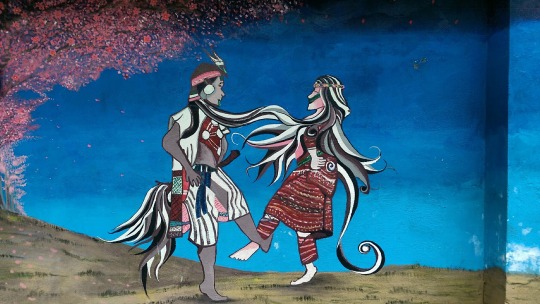
To mark another completed orbit of the Earth around the Sun since the day I stopped not existing, EVA and I decided to head out to the Atayal Tribal town of Wulai, and then on to a small village that lies deep in the mountains at the end of Route 107, Fushan:
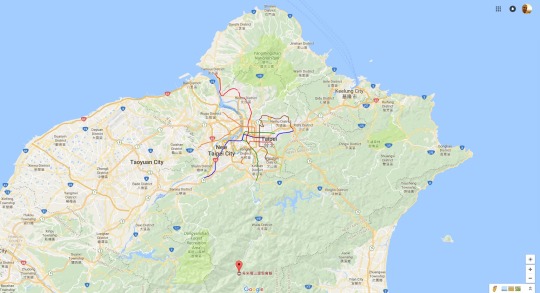
As you can see from the zoom-in map below ... this is literally as far as you can go in this direction. There’s one road in and the same road out. When Typhoon Souledor recently wrecked havoc in Wulai this road got blocked by landslides. Villagers along the route, unable to ride out for supplies had to hike instead. Where the journey would normally take them an hour tops, they walked for 12 hours to reach help. You can see no other road even comes close to Fushan. Once you’re off the road, you’re deep in a forest of vertiginous and fatal slopes liable to mudslides and raging floods. It’s a uniquely inhospitable environment for anyone unfamiliar with it.
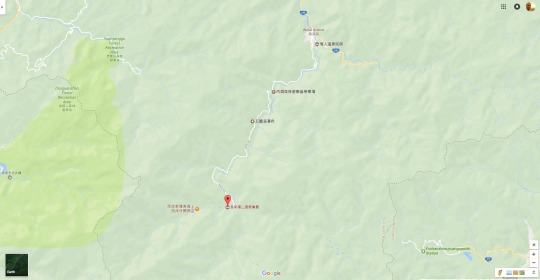
On Saturday afternoon, we hopped on my trusty steed scooter and rode over the mountain through Cemetery City to Liuzhangli and then on down to Xindian where we took a break at Bitan Riverside Park, before completing the relatively shot but winding hop upstream to Wulai. Once there we checked into our hot spring hotel (an expensive treat), popped into town for dinner then returned to steam in the spa before hitting the sack early to save energy for the next day.
After about forty-five minutes out from Wulai we finally arrived at Fushan Village. Lots of signage, in various conditions and accessibility, is available to guide the visitor. Note the romanised Atayal language ...
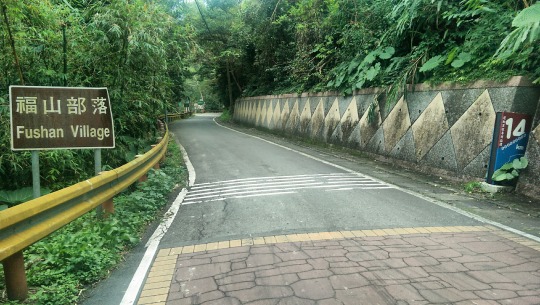

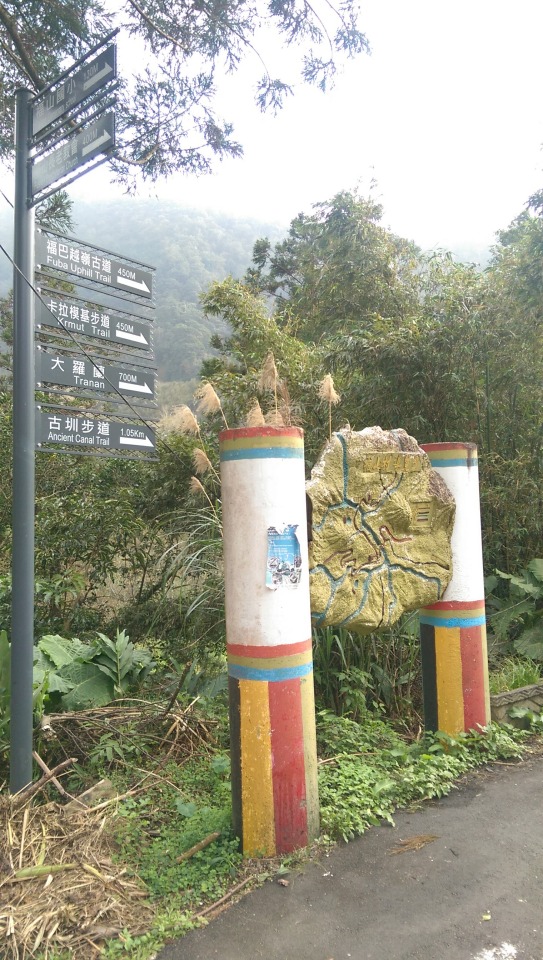
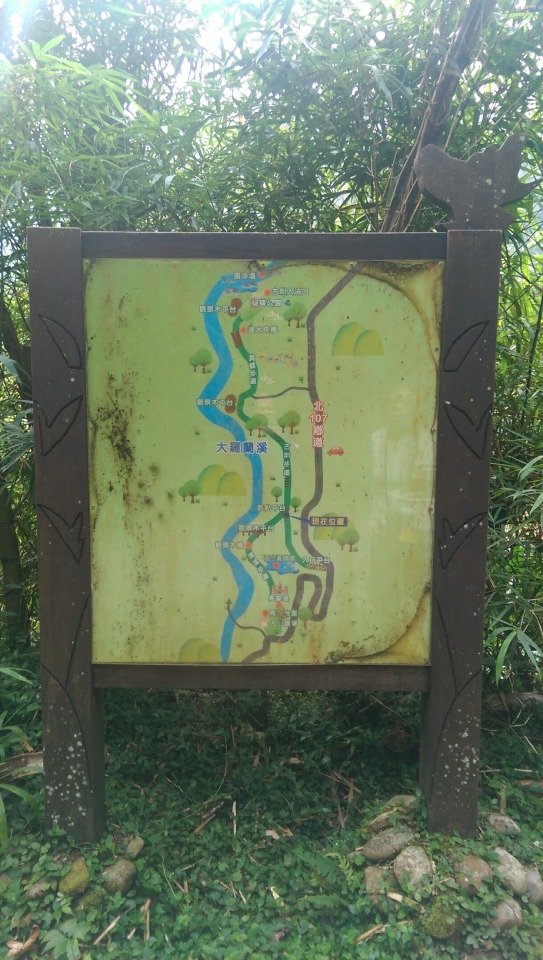


We decided to walk the ancient canal trail to the butterfly park but first I took a snap of this wall design ...
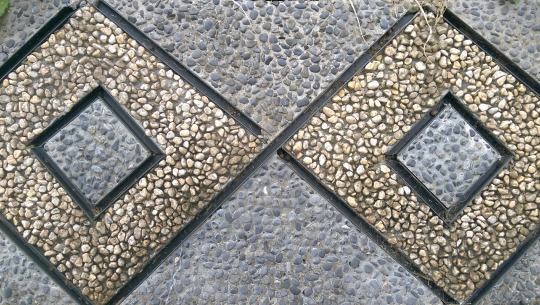
Walking along the canal high above the village ...

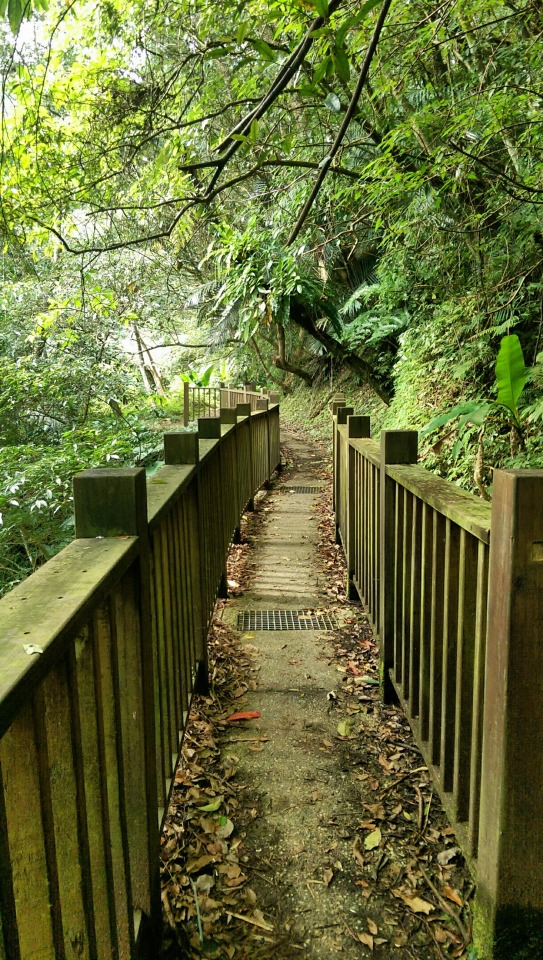
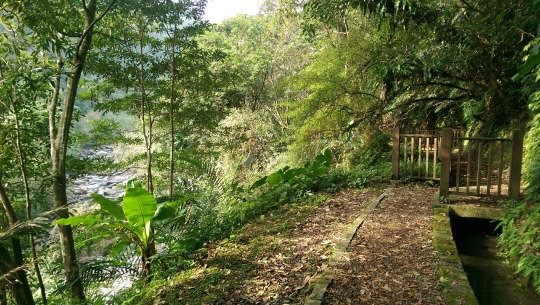

The park itself was still under construction and butterfly season is Spring and early Summer so it didn’t take long to complete the park ...

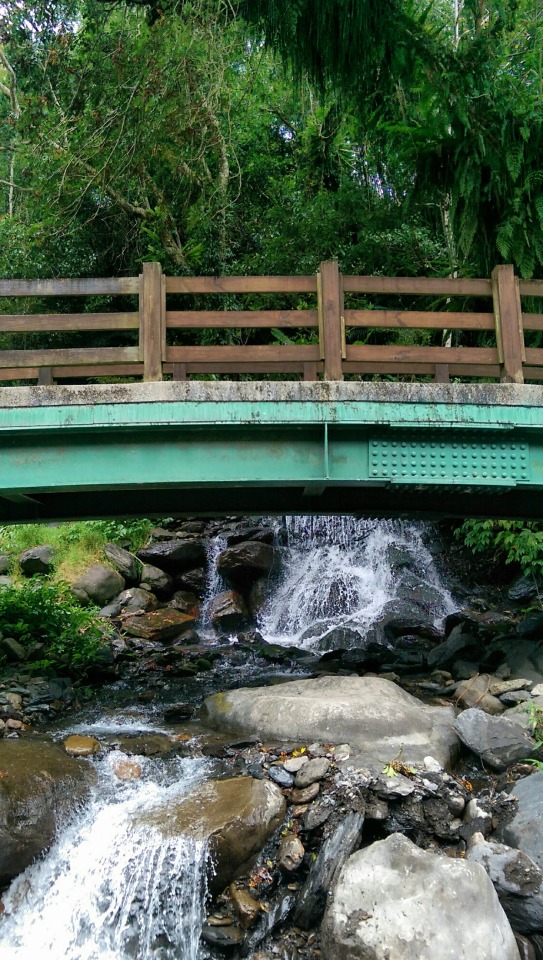
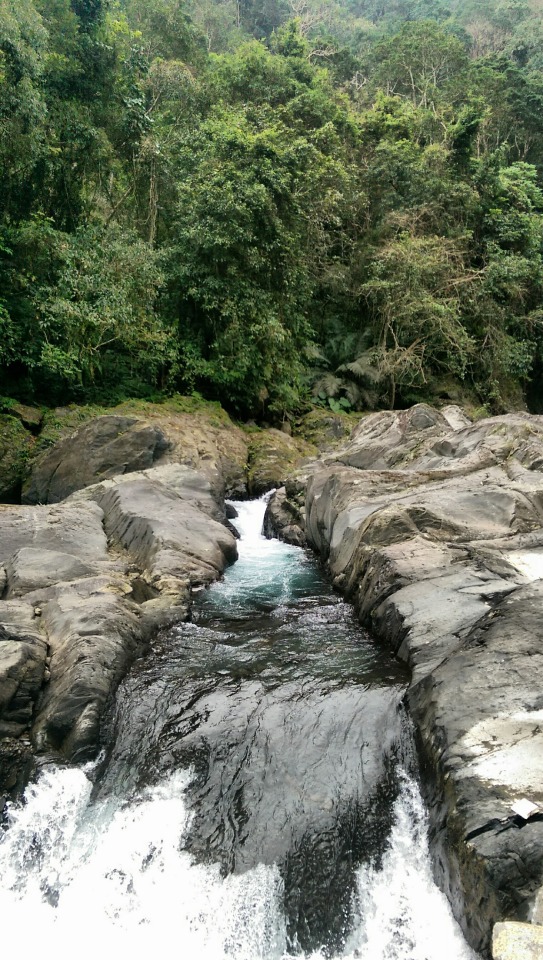
The obligatory flora shot ...

Then it was back to the village ...
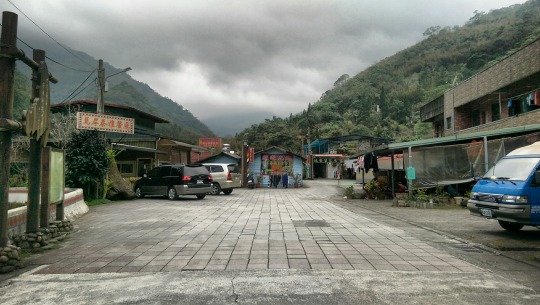
Brick, unlike tile over concrete, ages well in colour and texture ...
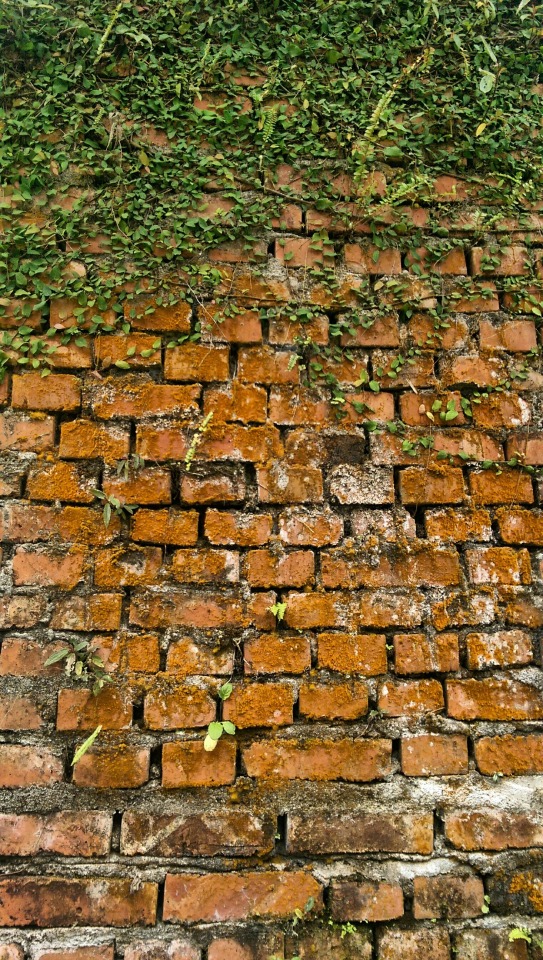
Fushan Village has different sections. There are useful signs like this to help you learn more about where you are ...


It says the Atayal originally settled in Fushan Village which omits the fact that the original settlers here arrived after journeying from locations in Nantou County in the center of the country. Some of the restaurants in Tranan ...
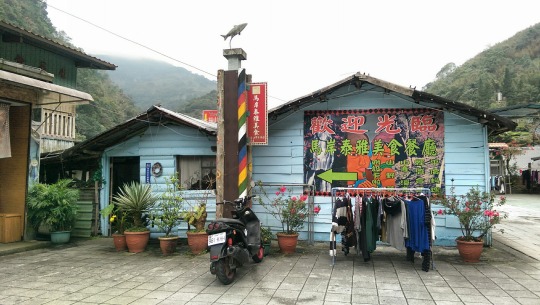

And the picturesque river beside it ...
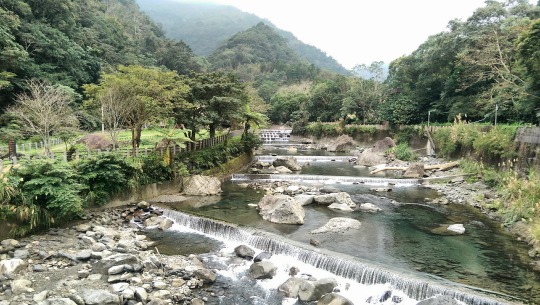
Tranan marks the end of Route 107 ...
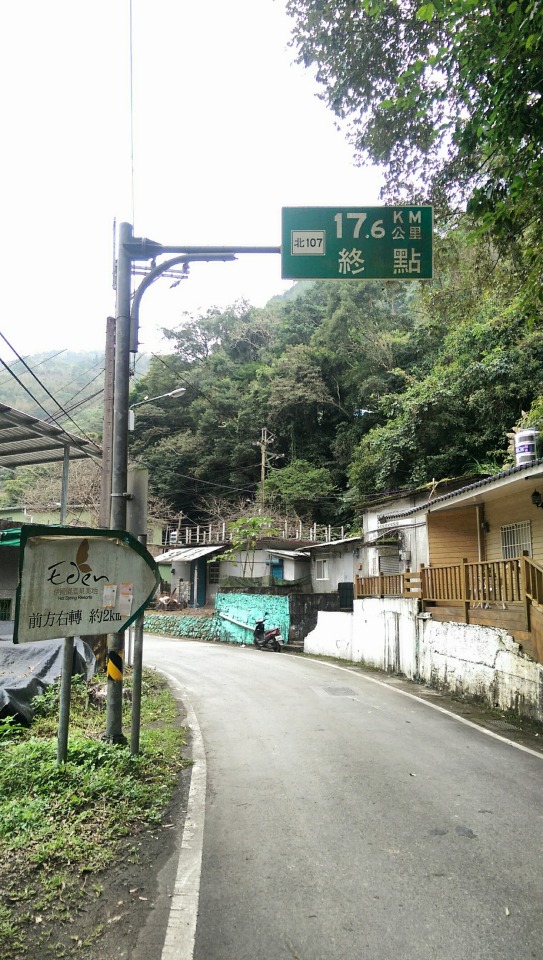
Back to the main village around mountain, we took some time to walk through the buildings ...

... a field of fruit cacti ...

Everywhere, the village is decorated with distinct designs ...

The local elementary school is a centre of the community and functions as an emergency helipad ...
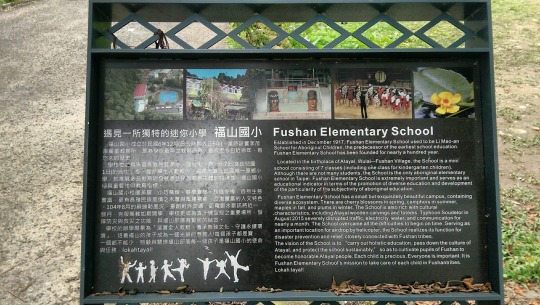
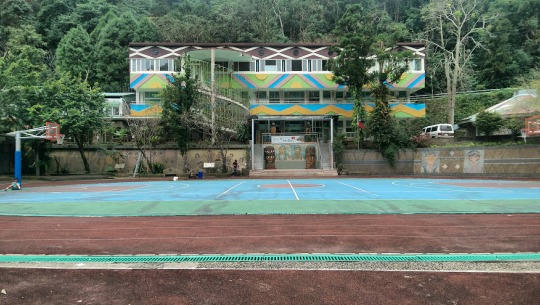
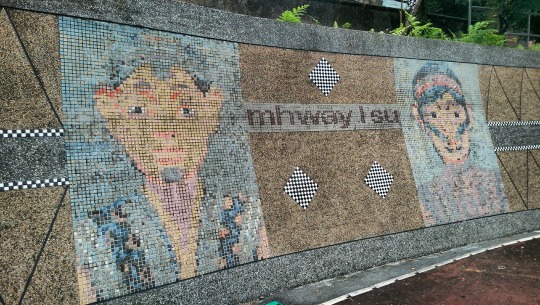
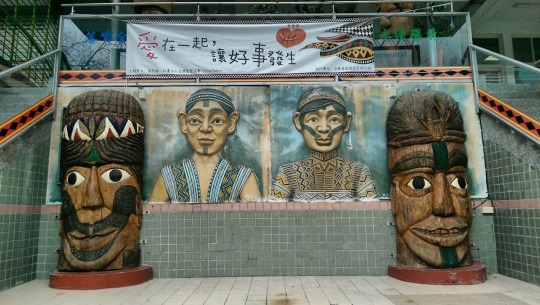
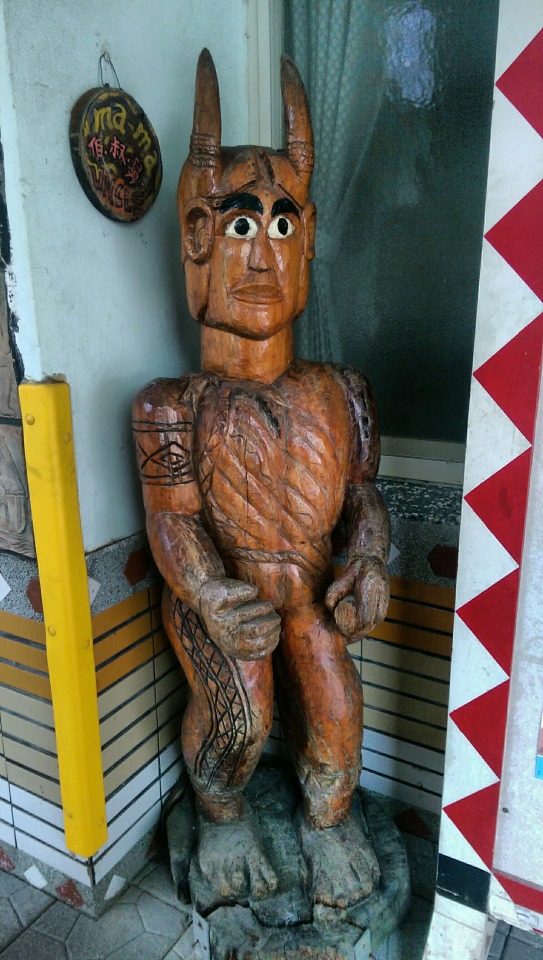
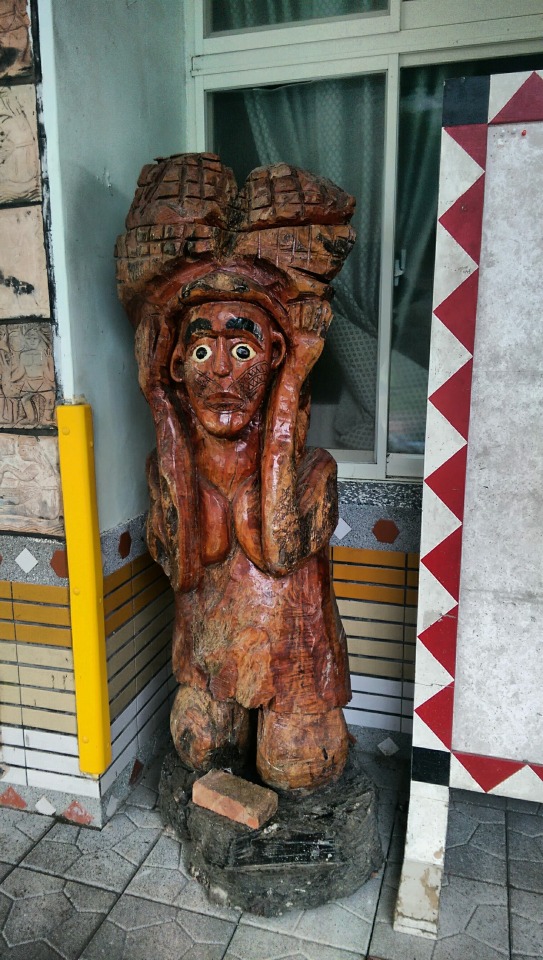
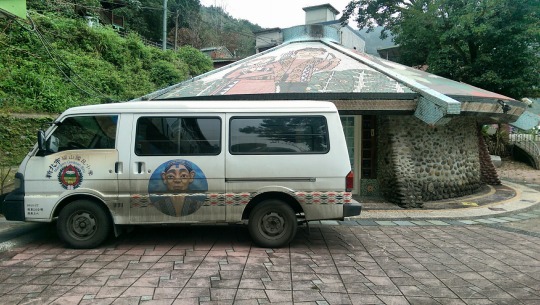


Then it was up the hill to the Presbyterian Church ...
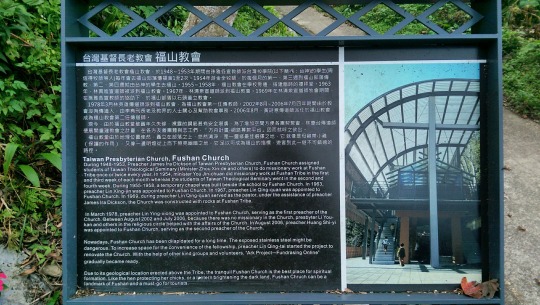
This is the old church ...

... and this is the new one ...
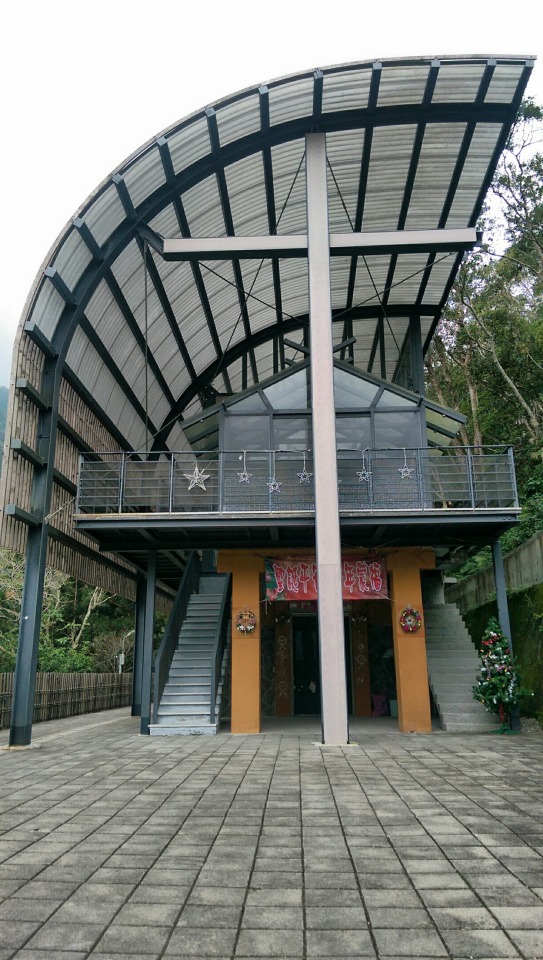
We also briefly met the minister who was leaving after completing the Sunday morning service and tending to his congregation. This is him below on a modified promotional poster for the film Seediq Bale in which he played Seediq revolt leader Mona Rudao ... (Note: it is an appropriative liberal interpretation / act of historical revisionism to say the Wushe Revolt was a part of the Taiwan Independence struggle) ...

... in real life I didn’t recognise him until EVA pointed out he was the very same guy. The church, and faith, is also a major pillar of the community ...


Quite a few dogs milled around the village including a pack of five all slightly disabled canines hopping around. The dogs were friendly but I generally kept my distance (literally once bitten twice shy) ...
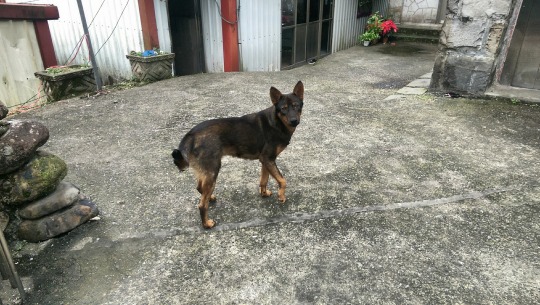
Most of the buildings had painted murals on them, which one youngster explained were done by the families themselves ...
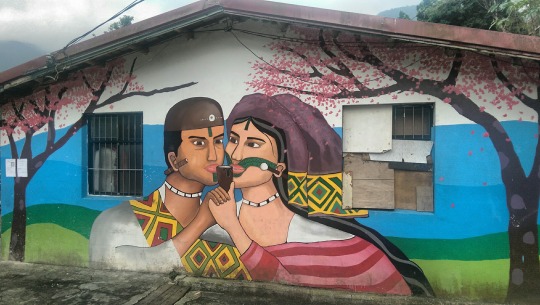
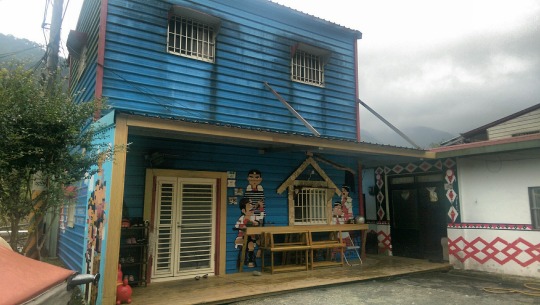
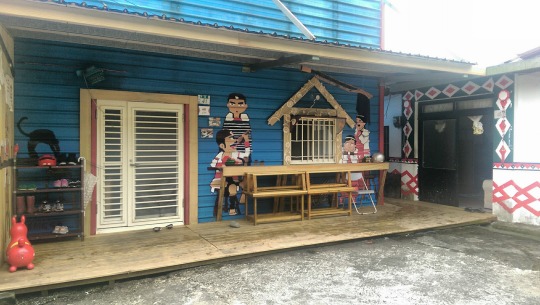
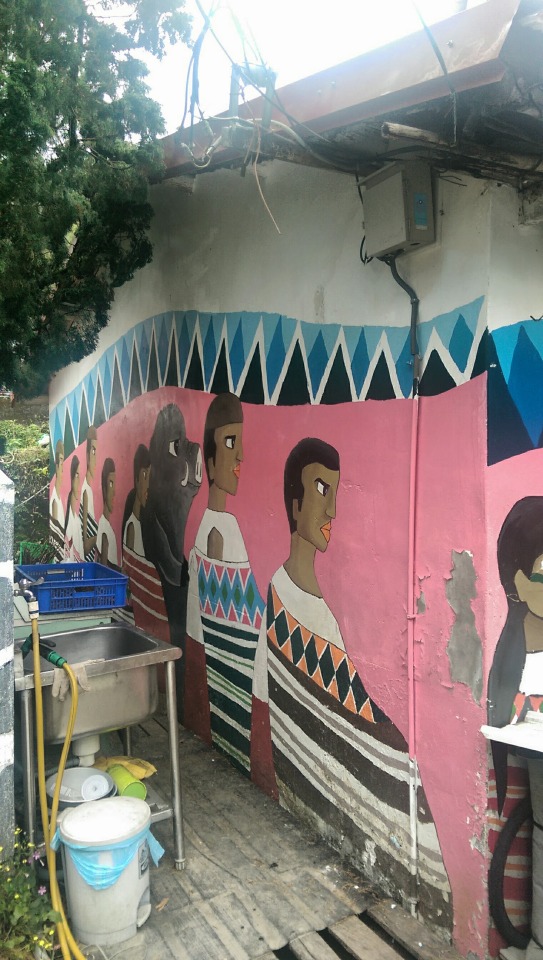
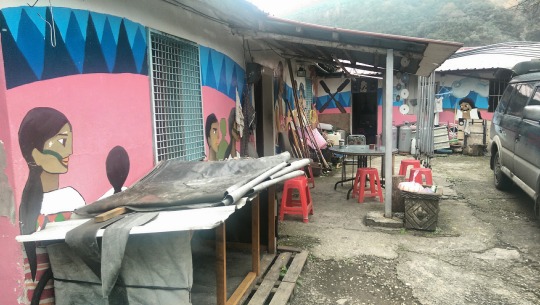

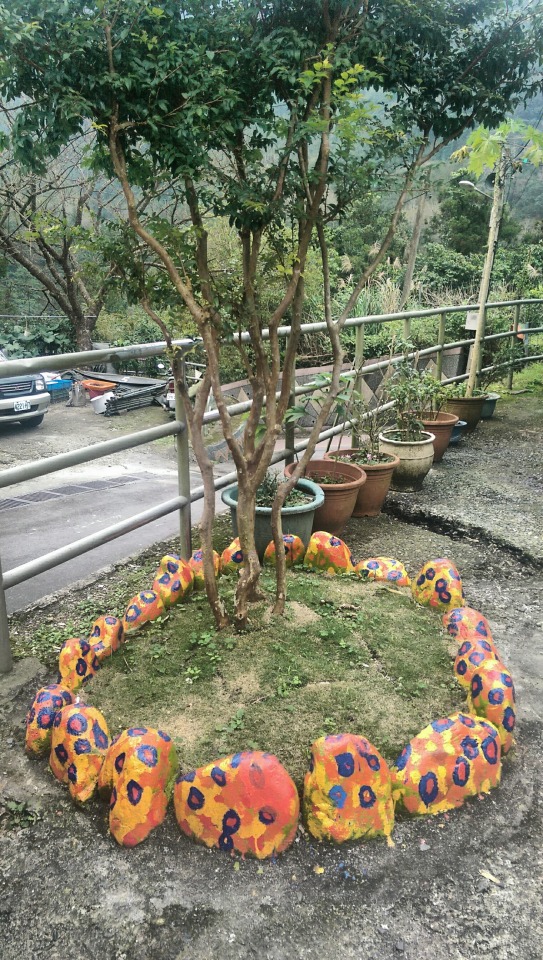
With time getting on and light fading we decided to make our way back to Wulai, stopping along the sheer mountainside road to take in the views ...
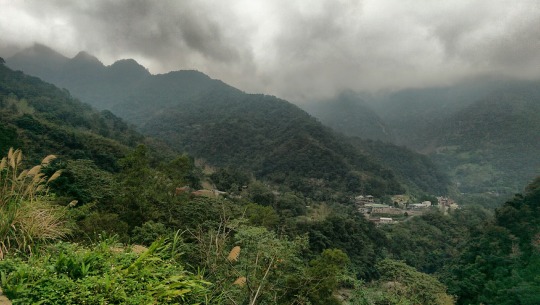

Taiwan is (should be) famous worldwide for it’s suspension bridges. There are a plethora of them amongst the mountains, nearly all of them decorated beautifully and many of them at great height about the valley floor. Here’s one such example ...

Even the stone wall next to the road was carved with Atayal patterns ...
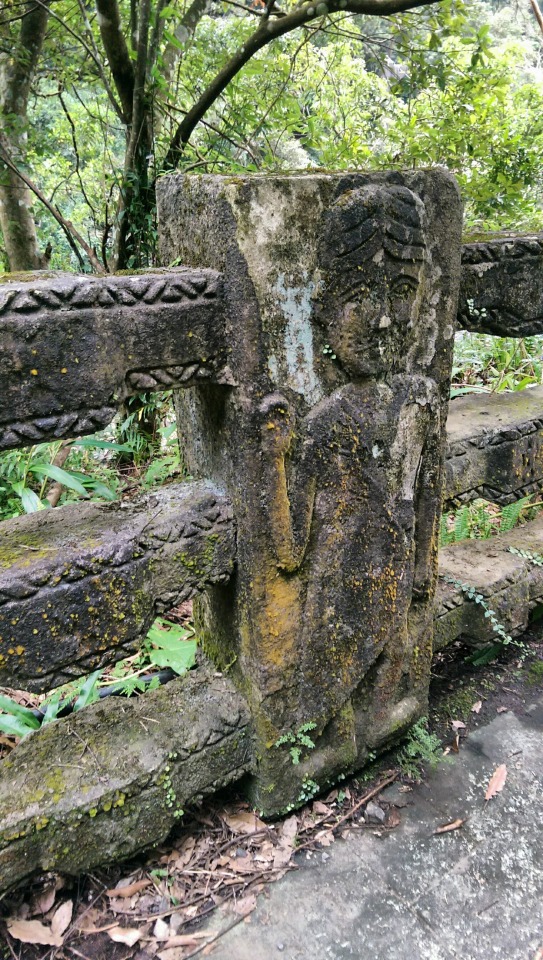

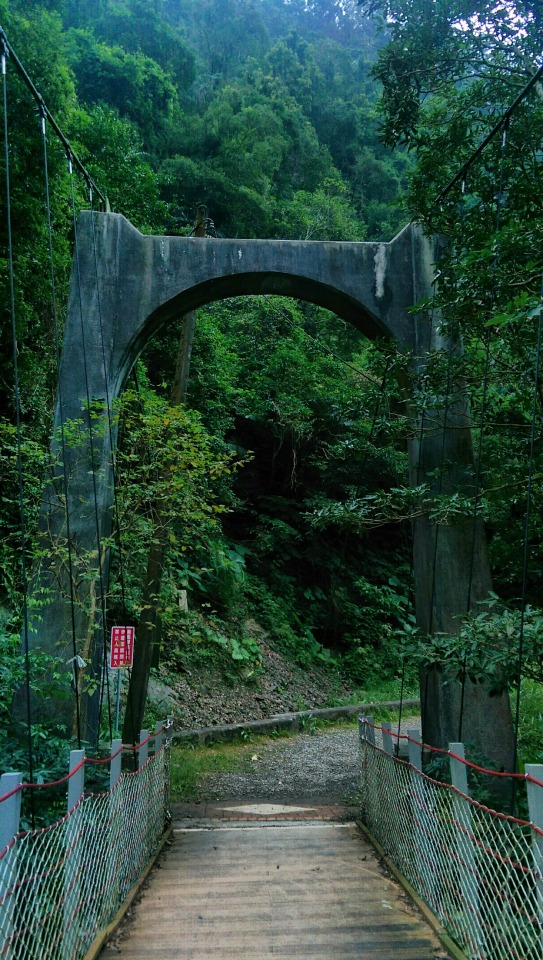
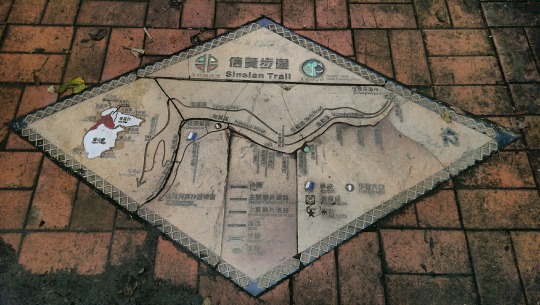
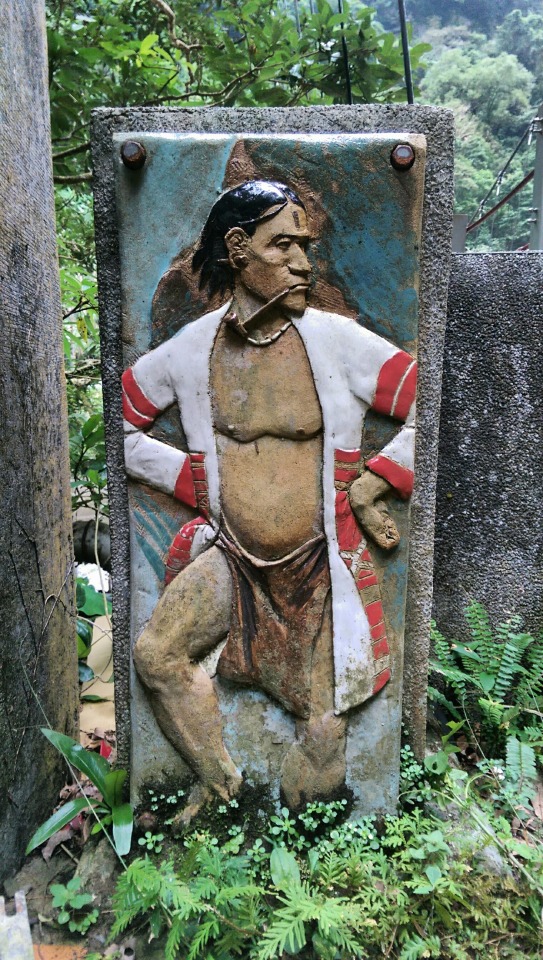
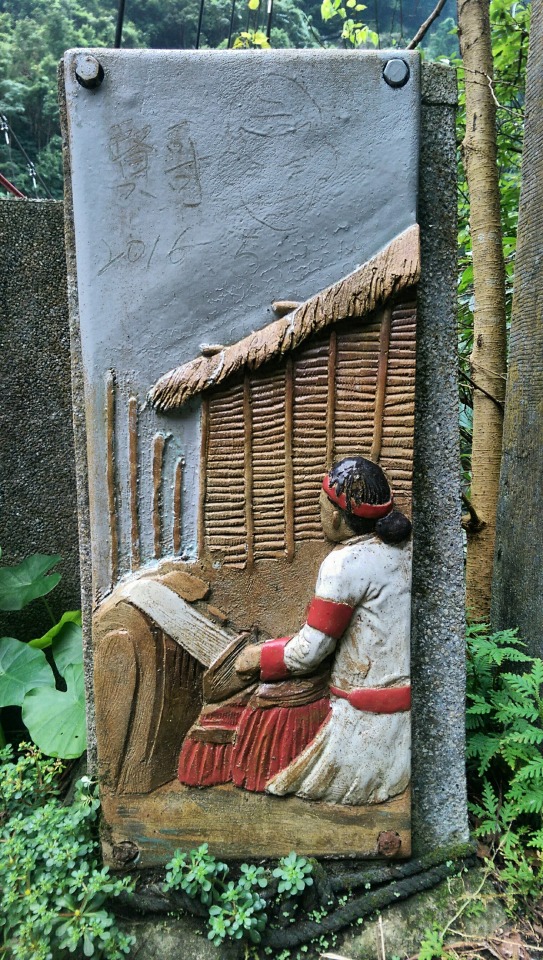
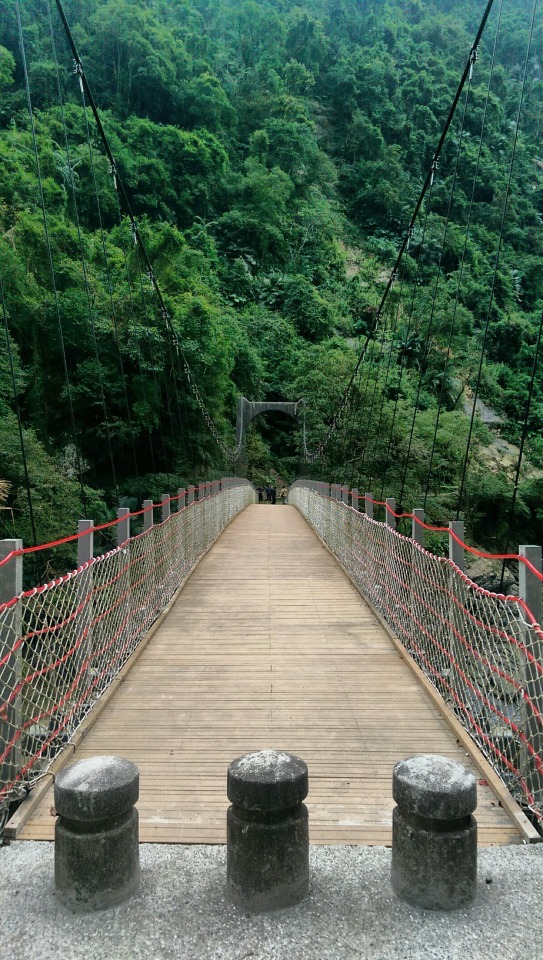
Two prominent components of Atayal culture are hunting and weaving, success at which are used as traditional markers of, respectively, male and female status and maturity within the community. Every male got a forehead tattoo at the age of fifteen or sixteen but only those who had completed a head hunt earned the right to have a prestigious chin tattoo. Likewise, women who demonstrated the ability to weave complex patterns and thread arrangements would earn the facial tattoo that stretched from ear to ear through and around the mouth. Hunting, and specifically with dogs, was a way for the community to add important component to their diet, hunting expeditions often taking up to two weeks or more out in the mountain forests. The capture and killing of wild boar was both a key way for a hunter to gain respect / status but also a big boost for a village running low on food, especially in winter. Thus we see this reflected in statues that can be found in most Atayal villages ...
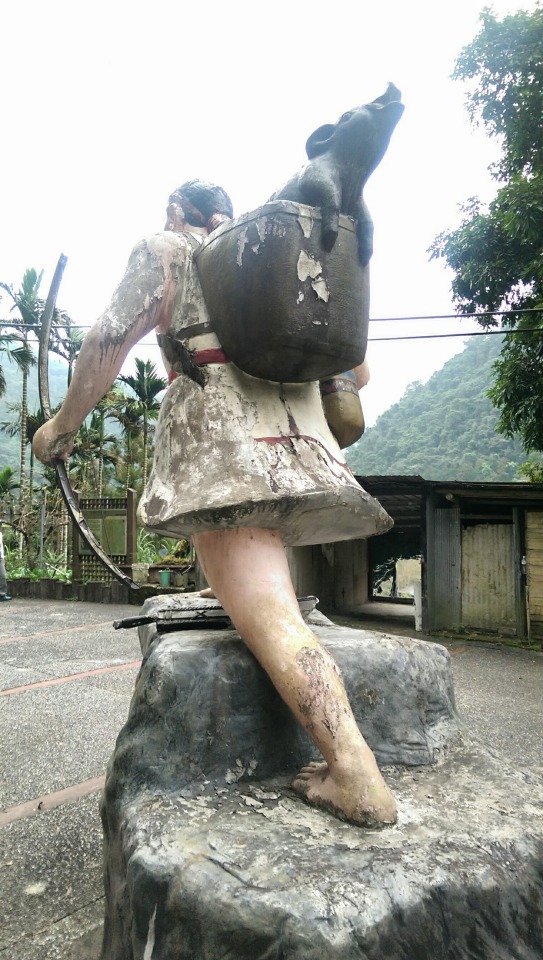
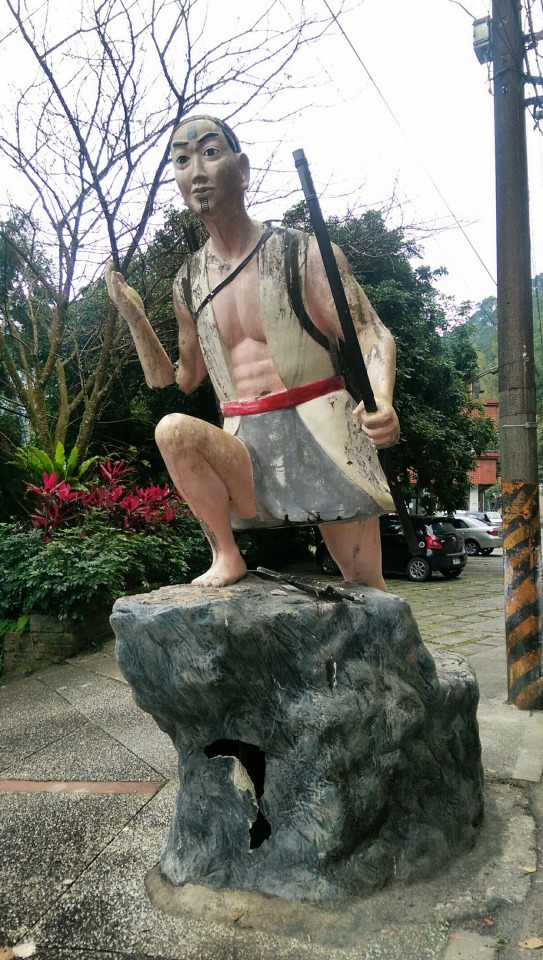
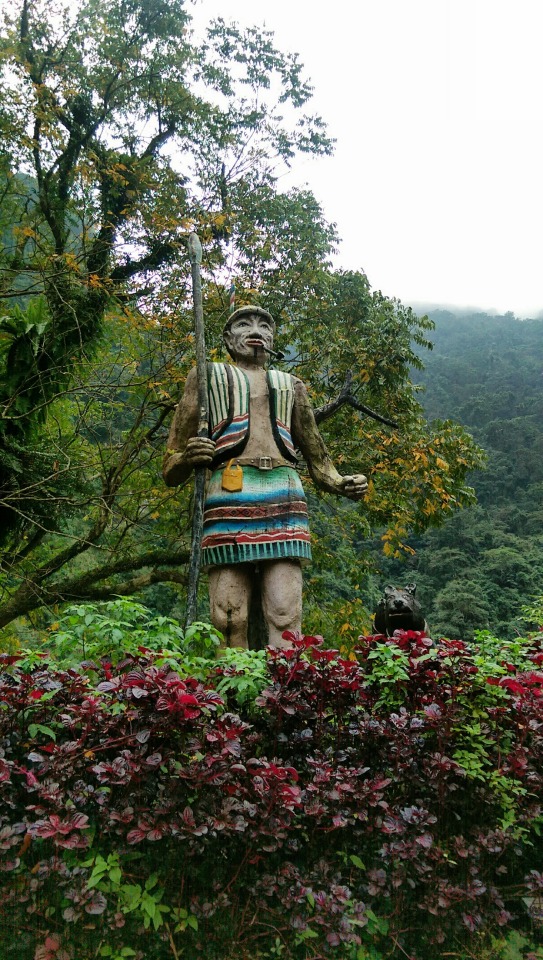
On our way down to Wulai we stopped at Wulai Waterfall ...
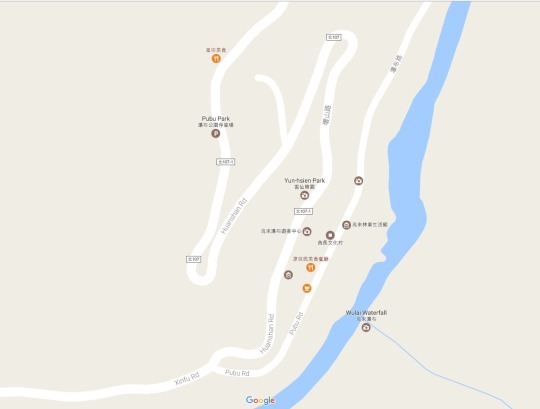

There is a museum here that describes the history of the area as well as introduce the logging business and logging railway that economically transformed the valley and local communities. Apparently the railway which now runs from Wulai to the waterfall but used to run all the way up the valley almost as far as Fushan became a major tourist attraction in the 50s and 60s but was knocked out of commission by Typhoon Souledor. Work is currently underway to fix it. The waterfall area is marked by a collection of hotels and spas, a cable car that spans the valley, and a street of restaurants and shops where you can buy various Atayal and indigenous themed souvenirs. We ate at a place called Ganafu (open weekends only) which served an absolutely amazing Trout burger. The owners were super friendly and took the time to chat with us about Atayal culture and the local economy ...
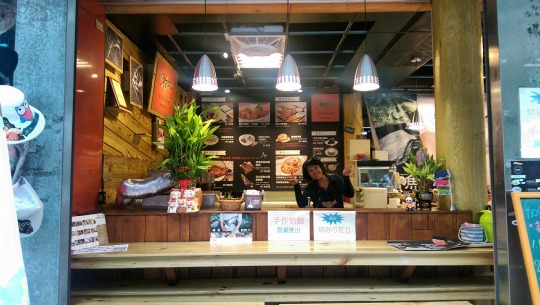
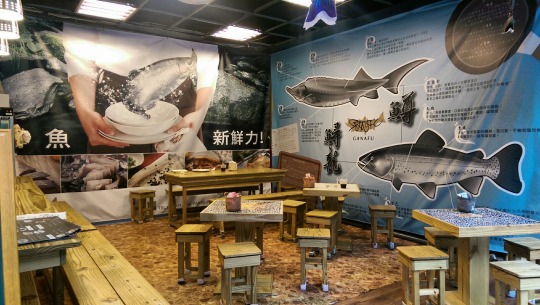
We learned from them that Fushan Village was adapting to survive economically, most recently by increasing tourism (e.g. Butterfly Park, trails, hot spring spa) and will soon provide local guided tours. We noted one restaurant in Tranan was booked that day for a group of one hundred.
Finally, we glided down the small road to Wulai (in mountains I usually run the engine on neutral and coast down the roads to eliminate engine noise and avoid disturbing hikers and wildlife I’m sharing the road with) and stopped by the Wulai Atayal Museum (Mandarin only site) ...
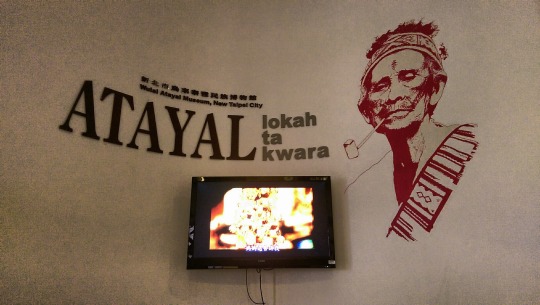
It’s a fascinating place and in it we met one Atayal woman who runs weaving classes and a souvenir shop. I asked why so many Atayal patterns were red, black, and white and was told that it was mostly owing to a lack of available materials to dye the thread in other colours. Personally, I find this tricolour motif of Atayal clothing and weaved products to be the most distinct and aesthetically pleasing of all the indigenous styles in Taiwan. Somewhat macabrely, the museum has a map showing where each indigenous group largely resides / originates from in Taiwan and appears to have a running tally of the number of members (who comprise about 550,000 or 2.6% of Taiwan’s total population). It was a sombre to reflect that many of the tribes down to hundreds of members would, along with their languages, oral histories, and culture, probably expire in the coming decades. Here’s the info board in question (apologies for the poor quality) ...

The museum is definitely worth a visit and contains enough material on three floors to spend a good few hours. There’s also lots of interesting quirks such as this sign on the Atayal tradition of head hunting which seems to have been written by someone keen to rebut certain allegations ...

I think we’ll be returning to Fushan Village again for the Butterflies and the trails sometime in the Spring or Summer, if only to walk one of two famous hiking routes that run from the village all the way to the plains of Taoyuan in the west or the Yilan delta in the East. (The hikes both take about eight to ten hours, one way).
8 notes
·
View notes
Text
De Blasio Could Save Lives by Closing New York City’s Streets. Why Won’t He?
I was walking down the sidewalk in my neighborhood in central Brooklyn when two older women turned the corner in front of me. They both wore masks and latex gloves. They were in conversation, but walked about six feet apart. They had been walking along an avenue with wide sidewalks, but turned onto the sidewalk I was walking along, which was just a few feet wide. As we walked towards each other, it became clear we could not all walk along the sidewalk while maintaining social distancing. I had two options: walk as equidistant between them as possible, perhaps two feet or so from each, or walk into the road.
I repeat this calculus every trip outside dozens of times. I want to be a good pandemic samaritan, but I also don’t want to get hit by a car. And every time this happens, I wonder to myself why roads haven’t been blocked off for pedestrian use.
In 2017, after Mayor Bill de Blasio was re-elected for his third and final term, he decided to make the theme of his lame duck term “the Tale of Two Cities.” It was fresh, original, and not at all a lame throwback cliché, just like de Blasio himself. He explained that there is the rich New York and the poor New York. Little did he expect that an entirely new and unprecedented type of Tale of Two Cities would take place during his term.
Thanks to coronavirus, there is now an empty New York City and a crowded one. The empty city consists of the office buildings, bars, restaurants, libraries, tourist attractions, and streets. It is an object of great fascination for those of us grappling with the blood draining from a metropolis that used to be debatably worth paying exorbitant rents to access. We hope the empty city is merely falling asleep like a limb awkwardly tucked under a torso and the blood will come rushing back to it once it shifts position. But with each passing day we become ever so slightly less sure of this, partly because of a lack of confidence in de Blasio himself to roll the city over.
That lack of confidence stems from what’s happening in the other New York City, the crowded one: grocery stores, hospitals, the living room in our cramped apartment shared with two roommates all of whom are now working from home until further notice or unemployed with nowhere to go, the park where everyone goes to get fresh air and exercise, the playground where kids expend a fraction of their pent-up energy, and the sidewalk which is less than six feet wide, making social distancing a physical impossibility.
In the face of the coronavirus pandemic, for which New York City has become the national epicenter, this tale of two cities is, to a large extent, inevitable and necessary. But there is one thing, one very obvious thing, the city could do to ease some of the crowding in parks, sidewalks, and playgrounds.
The city could close a portion of its more than 6,000 miles of streets to through traffic and open it to people.
The benefits of closing off many streets to traffic are obvious to anyone who visited the Prospect Park loop during the last week. It has been packed with joggers and families to such an extent that it’s not possible to maintain six feet of distance from anyone else. Many neighborhood playgrounds and parks around the city have a similar problem.
While parks are too crowded, streets are virtually empty. In the days immediately following a state executive order limiting business activity, traffic plummeted some 35 percent and it has further declined after the state issued a shelter-in-place order days later. According to urban mobility app Citymapper, only about five percent of trips normally taken in New York City are being made today.
Thanks to this lack of traffic, I now jaywalk across major thoroughfares like Flatbush and Atlantic Avenues without breaking stride—a death sentence during normal times—because there are so few cars. Residential streets are even more desolate. The one I live on would regularly experience traffic jams a block long during rush hour. This hasn’t happened in weeks. On Monday afternoon, a car passed my window every three to four minutes on average. Closing off some streets would have zero impact on traffic because there isn’t any.
Instead of taking this painfully common sense solution at face value—one public place is very crowded, another very empty; let us redirect some of the people from the crowded space to the empty one—and executing it, the city has spat in common sense’s face and shoved it to the ground for good measure. Here, I’m referencing de Blasio’s threat to close not the streets, but parks and playgrounds if they continue to be too crowded, which of course they will, because people have nowhere else to go for fresh air and exercise since the city won’t close off streets. (On Tuesday, the city announced the closure of 10 playgrounds "where we have consistently found a lack of regard for social distancing." Closing playgrounds may in fact be good policy because of all the shared surfaces; parks less so.) It’s a vicious cycle that feels aggressively hostile towards those of us cooped up in something smaller than a mansion on 88th Street.
But it’s not too late to do the right and obvious thing. The good news about closing off streets to most vehicle traffic is it takes little more than a few road cones.
The half-baked idea I thought of a week ago and haven’t immediately thought of a reason why it wouldn’t work—which I guess makes it pretty well-baked by now— is to close off every fifth residential block to traffic. This can be done by placing two orange traffic cones at each end of the block, far enough apart that emergency vehicles and local traffic can still get through but close enough together to force drivers to slow down and see that people may be using the street.
New York already does this, to varying degrees, with two different summer programs: Summer Streets and block parties. Summer Streets is a Department of Transportation program that closes off seven miles of main roads from the pitifully narrow window of 7 a.m. to 1 p.m. on three Saturdays in August. Block parties, which are more in line with what I’m talking about here, merely require a permit in order to close off the street and are limited to one day. The day of the event, the police put a barricade at either end of the block or someone from the block association parks their car across the crosswalk. Fun ensues.
Safe streets advocates have been calling for expanded Summer Streets and block party programs for years, because, as DOT’s own website puts it, “Summer Streets is an annual celebration of New York City’s most valuable public space—our streets.” It seems that if it is truly our most valuable public space, we ought to enjoy it a bit more, especially now.
To be far fairer to de Blasio than he deserves, I will mention the city did recently close off a few blocks per borough—a grand total of 1.5 miles of road—for four days precisely this reason. It is astounding, though, that the city thought this would aid in social distancing one iota. How did they figure closing off four blocks in Bushwick would make the slightest difference in a borough of 2.5 million people?
It’s not at all clear what the Mayor is afraid of, as there has never been a better time to do this, both practically and politically. During these “normal times” to which I keep referring but am increasingly unable to clearly recall, every effort to close streets to cars is typically opposed by a cadre of conservatives: local businesses who think it will hurt their bottom line, crotchety residents who are worried about their parking, and occasionally local politicians who are worried about getting the votes of the people who are worried about their parking.
But these are not normal times. Most of the crotchety people who are worried about their parking have long since gotten in their cars, left their parking spots, and driven far away. Or, they have realized there is nowhere worth driving to and, with alternate side parking suspended, don’t plan on moving the car any time soon. The business owners who normally worry about their bottom lines have much bigger worries about their bottom lines at the moment. All of the usual opposition is either nowhere to be found or no longer opposed.
When I asked the Department of Transportation about all this, it directed me to City Hall, which did not respond to a request for comment. It’s a shame, because closing off hundreds of streets could go a long way towards closing the gap between the new tale of two cities. You’d think de Blasio, of all people, could understand that.
De Blasio Could Save Lives by Closing New York City’s Streets. Why Won’t He? syndicated from https://triviaqaweb.wordpress.com/feed/
0 notes
Text
Headlines
Riot declared as fire burns in Portland police union offices
(AP) A fire inside a police union building led authorities in Portland, Oregon, to declare a riot and force protesters away from the offices as violent demonstrations continue in the city that had hoped for calm after federal agents withdrew more than a week ago. A group of demonstrators broke into the Portland Police Association building, set the fire and were adding to it when officers made the riot declaration late Saturday, police tweeted. Video shot by a journalist shows smoke and flames arising from inside the building. Several hundred people had gathered outside the offices, which are located about 5 miles (8 kilometers) north of the federal courthouse that had been the target of nightly violence earlier this summer. The Portland Police Association is a labor union that represents members of the Portland Police Bureau.
For pandemic jobless, the only real certainty is uncertainty
(AP) For three decades, Kelly Flint flourished as a corporate travel agent, sending everyone from business titans to oil riggers around the planet. Then came the worst pandemic in a century, leaving her jobless and marooned in an uncertain economy. Furloughed since March, Flint has dipped into her retirement account to pay her bills, frustrated that her $600 weekly emergency federal aid payments have expired. She yearns, too, for an end to the twin disasters that now dominate her life: recession and pandemic. “I don’t deal well with the unknowns,” she says. “I never have.” Across America are legions of Kelly Flints, women and men who don’t know when they’ll receive another paycheck — or if. The coronavirus outbreak and resulting economic upheaval have thrown millions of lives into disarray. Industries have collapsed, businesses closed, jobs disappeared. Compounding the misery is a question no one can answer: When will this all be over? In recent congressional testimony, Federal Reserve Chairman Jerome Powell repeated his earlier warning: The strength of any recovery will rely on the nation’s ability to contain the virus. The outlook for the U.S. economy, he said, is “extraordinarily uncertain.” Uncertain. If 2020 had to be condensed into a single word — and there are many, many words to describe it — uncertainty would hover at the top of the list. Uncertainty about health. About the future. About the country itself. And uncertainty about livelihoods and jobs and economic security in a historical moment where each day seems to bring a fresh wave of unwanted developments.
Bolivia Under Blockade as Protesters Choke Access to Cities
(NYT) Antigovernment protesters in Bolivia blockaded some of the country’s main roads this past week to challenge the delay of general elections and rebuke the government’s poor response to the coronavirus pandemic. The protesters—who support Bolivia’s former president, Evo Morales—say they have set up 70 roadblocks, marooning about six million residents of three highland regions, including Bolivia’s most important metropolis, La Paz. Already, the blockade has raised fears of food and gasoline shortages, pushing throngs of La Paz residents into the streets to line up outside food markets and gasoline stations. Bolivia’s unrest could be a harbinger of what’s to come elsewhere in Latin America, where citizens are losing faith in their countries’ ability to contain the pandemic, and to mitigate the economic crisis brought on by measures to combat the virus. The pandemic has killed more than 210,000 people in Latin America and plunged its economy into the deepest recession in at least a century, according to the United Nations. Bolivia is suffering one of the biggest outbreaks in the region, when adjusted for population; the virus has killed 3,000, sickened top government officials and overwhelmed hospitals.
When Covid-19 Hit, Many Elderly Were Left to Die
(NYT) Of all the missteps by governments during the coronavirus pandemic, few have had such an immediate and devastating impact as the failure to protect nursing homes. Tens of thousands of older people died—casualties not only of the virus, but of more than a decade of ignored warnings that nursing homes were vulnerable. In recent months, the coronavirus outbreak in the United States has dominated global attention, as the world’s richest nation blundered its way into the world’s largest death toll. Some 40 percent of those fatalities have been linked to long-term-care facilities. But even now, European countries lead the world in per capita deaths, in part because of what happened inside their nursing homes. Spanish prosecutors are investigating cases in which residents were abandoned to die. In Sweden, overwhelmed emergency doctors have acknowledged turning away elderly patients. In Britain, the government ordered thousands of older hospital patients—including some with Covid-19—sent back to nursing homes to make room for an expected crush of virus cases. (Similar policies were in effect in some American states.) Few countries embody this lethally ineffective pandemic response more than Belgium, where government officials excluded nursing-home patients from the testing policy until thousands were already dead. Nursing homes were left waiting for proper masks and gowns. When masks did arrive from the government, they came late and were sometimes defective.
Paris makes masks mandatory as virus toll crosses 722,000
(AFP) Paris on Saturday made face masks compulsory outdoors in crowded areas and tourist hotspots, as infections in and around the French capital rose and the global death toll crept past 722,000. The mask will be obligatory for all those aged 11 and over “in certain very crowded zones”, said a police statement. Several French towns and cities have already introduced similar measures, as well as parts of Belgium, the Netherlands, Romania and Spain.
Masks in class? Many questions as Germans go back to school
(AP) Masks during class, masks only in the halls, no masks at all. Distance when possible, no distance within same-grade groups, no distance at all. As Germany’s 16 states start sending millions of children back to school in the middle of the global coronavirus pandemic, the country’s famous sense of “Ordnung” has given way to uncertainty, with a hodgepodge of regional regulations that officials acknowledge may or may not work. Germany has won plaudits for managing to slow the spread of the coronavirus quickly, efficiently and early, but the opening of schools is proving a new challenge as the country struggles to balance the concerns of anxious parents and children, skeptical scientists, worried teachers and overtaxed administrators. With U.S. President Donald Trump pushing for American schools to reopen in person and on time even as the country nears 5 million confirmed coronavirus cases, and other countries moving ahead with plans to resume classes despite rising infections, many eyes are on the real-life experiment offered in Germany to see what works and what doesn’t.
Hard-hit Italy cautiously embraces new normal in coronavirus era
(LA Times) With tourists still absent and office workers continuing to toil from home more than two months after Italy’s strict coronavirus lockdown ended, few were out and about on Rome’s central Via del Corso last week. But in the Farmacrimi drug store, one product was being briskly traded. “Masks keep on selling,” said manager Federica Faragali. “People buy them like cappuccinos.” Among the places where face coverings are widely on display is the Circus Maximus, where socially distanced spectators—including women in gowns with matching masks—are back watching open-air performances of Verdi’s opera “Rigoletto.” Five months after Italy was wracked by the West’s first major outbreak of the coronavirus, the nation continues to move cautiously toward a semblance of normality and has thus far not seen a major secondary flare-up of COVID-19 deaths. New daily cases inched up on Friday to 552, but that was less than 1/10 of the 6,500 daily cases reported at the peak March 21 and 1/100 of the new cases in the U.S., where more than 50,000 are being reported each day.
Afghanistan to release 400 ‘hard-core’ Taliban to start peace talks
(Reuters) Afghanistan agreed on Sunday to release 400 “hard-core” Taliban prisoners, paving the way for the beginning of peace talks aimed at ending more than 19 years of war. Under election-year pressure from U.S. President Donald Trump for a deal allowing him to bring home American troops, the war-torn country’s grand assembly, or Loya Jirga, on Sunday approved the release, a controversial condition raised by the Taliban militants to join peace talks.Deliberation over the release of last batch of Taliban prisoners, accused of conducting some of the bloodiest attacks across Afghanistan, had triggered outrage among civilians and rights groups who questioned the morality of the peace process. In 2019 alone, more than 10,000 civilians were killed or injured in the conflict in Afghanistan, putting total casualties in the past decade over 100,000, a United Nations report said last year.
Clashes Erupt in Beirut at Blast Protest as Lebanon’s Anger Boils Over
(NYT) Violent clashes between demonstrators and security forces transformed much of central Beirut into a battle zone of flying rocks, swinging batons and clouds of tear gas on Saturday, as the fury over a huge explosion in Beirut’s port this week fueled attacks on government buildings. By nightfall, angry protesters demanding the ouster of the country’s political elite had stormed three government ministries, a handful of legislators had resigned, and the prime minister had called for early elections, the first major signs that the blast could shake up the country’s political system, widely derided as dysfunctional. Many Lebanese considered the blast, which sent a shock wave through the capital that destroyed entire neighborhoods and killed at least 154 people, as only the latest and most dangerous manifestation of the corruption and negligence of the country’s leaders. The clashes on Saturday erupted across broad swaths of the city’s center, with demonstrators yanking down barricades blocking access to the Parliament, chanting “Revolution! Revolution!,” and throwing rocks at the security forces, who flooded the area with tear gas and fired rubber bullets. Fires burned in nearby buildings, filling the sky with smoke, and sirens screamed as ambulances rushed the scores of people injured in the clashes to hospitals.
Saudi Aramco half-year profits plunge 50% from virus impact
(AP) Saudi Aramco’s net income plunged by 50% in the first half of the year, according to figures published Sunday, offering a revealing glimpse into the impact of the coronavirus pandemic on one of the world’s biggest oil producers. Profits for the first six months of the year plunged to $23.2 billion, half of last year’s $46.9 billion for the same time period. The results were announced as Aramco’s second quarter earnings dipped to $6.6 billion compared to $24.7 billion during the same time last year, reflecting a staggering 73% drop. The majority state-owned company’s financial health is crucial to Saudi Arabia’s stability. Despite massive efforts by Saudi Crown Prince Mohammed bin Salman to diversify the economy, Saudi Arabia still depends heavily on oil exports to fuel government spending.
1 note
·
View note
Text
Positive Outcome for Cabo Roig Business Meeting has been published at http://www.theleader.info/2017/08/18/positive-outcome-cabo-roig-business-meeting/
New Post has been published on http://www.theleader.info/2017/08/18/positive-outcome-cabo-roig-business-meeting/
Positive Outcome for Cabo Roig Business Meeting
The local council will this week give a deep clean to the public footpaths all along the Cabo Roig Strip. Also much needed small waste bins will be installed and provision will be made to empty them regularly.
Extra larger bins for waste and recycling will be brought from Orihuela to help cope with the huge increase of waste generated during the busy summer tourist season on the coast. These decisions were made at a meeting organised by Pedro Mancebo of the Orihuela Chamber of Commerce between Damaso Aparicio local councillor for street cleaning and waste collection and members of the “Cabo Roig Strip Business Association” and “O.C. Avanza Business and Entrepreneurs Association”.
As a result of meetings held at the Chamber of Commerce in Orihuela with business owners in Cabo Roig, Pedro Mancebo organized an urgent meeting to discuss different issues affecting their businesses in Orihuela-Costa especially following warnings by the local police that glass and bottles could only be placed in bins up to 10pm.
This new rule would have caused great difficulties for bars and restaurants because of the sheer volume of waste that would need to be stored inside the bars and restaurants for long periods of time causing safety, health and other risks and maybe even fines from the health department. During the meeting the town hall representatives assured the business owners that the town hall concerns were about kitchen waste and domestic rubbish only being placed in the bins between 9pm and midnight.
The town hall made it clear that all recyclable materials such as glass and paper could be placed in the recycle containers at any time of day. In return the business owners said that they would dispose of glass and other waste in an effective and quiet manner to minimize the noise for neighbours.
Damaso Aparicio and the waste collection manager for the area also highlighted the need for a deep cleaning in the whole of the Cabo Roig area, especially on “The Strip” where thousands of tourists and residents walk every day. The image of this area concerns the business owners as they endeavour to keep the area tidy.
The town hall has promised to increase its efforts to keep the area property maintained. A campaign of deep cleaning of footpaths will occur every Monday and Friday until the end of the summer season. On behalf of the Chamber of Commerce, Pedro Mancebo pointed out that there are many other business areas in Orihuela Costa that need more attention from the Town Hall and he obtained the commitment from the councillor to address the problems everywhere. Future meetings will be held with business owners in different areas of Orihuela-Costa.
Also discussed were the illegal street traders who place their wares wherever they like, whereas the legal businesses are limited to certain small spaces that they need to pay the town hall for, in addition to all the other taxes that they pay.
According to the Chamber of Commerce these hundreds of illegal traders do not have permission to trade in the streets, they don’t have proper invoices for their goods and don’t pay any taxes or social security and they unfairly damage legal businesses and traders from the Thursday and Saturday Stall Markets.
These illegal street vendors hugely affects the good image of Orihuela-Costa in front of tourists and residents so this problem has been highlighted by the chamber of commerce to the Tourism Department run by Sofia Alvarez. The Cabo Roig Strip and OC Avanza Business Associations have requested a greater police presence in Orihuela Costa at least during July and August.
A local Chinese supermarket was also discussed because they do not flatten their cardboard boxes before putting them in the recycle bin and so they overflow the bins very quickly and leave no room for anybody else and they often use normal bins instead of the recycle ones. The meeting ended on a very positive note with everybody agreeing that next year a similar meeting could take place in the months before the busy summer season.
Raymond Kearney
0 notes
Text
Pick Your Poison added to Google Docs
Pick Your Poison
Fall activities like apple picking and leaf peeping are generally considered safe, but with record crowds and a COVID surge expected to collide this fall, locals are worried
In the initial months of the COVID-19 pandemic, the outpouring of New York City residents to surrounding rural areas offered a boon to Twin Star Orchards. The U-pick apple farm and maker of Brooklyn Cider House cider sits just outside the small village of New Paltz, New York, about 80 miles north of New York City and halfway to Albany.
Susan Yi, who founded the business along with her brother Peter, says a wave of transplants buying new homes in the Hudson Valley gave business a bump during the usual off-season of April and May. Newly remote workers with flexible schedules have driven more business on Fridays, too, and the farm has added live music, usually reserved for holidays, to bring people out on Saturdays. There was even a socially distanced Fourth of July pig roast on its sprawling outdoor pavilion.
But as fall approaches at Twin Star Orchards, Yi worries that the farm’s high season could bring as much trouble as much-needed income. “Fall is always very busy with late September [to] early October as the peak, with apple-picking and leaf-peeping drawing a lot of people to the area,” she says. “We are typically packed each weekend, so we are a little concerned about keeping the crowds spaced out during that time.”
As spring turned to summer, the Northeast began to get a grip on the COVID-19 pandemic. New York state made a miraculous about-face from the nation’s hotbed to a model for how to contain the pandemic with aggressive lockdowns and testing. It made nearby places like New Paltz safer too. However, the popularity of fall activities could undermine those trends by coaxing people out of their homes just as experts predict a second wave of cases.
With what we know about the spread of COVID-19, outdoor escapes like apple picking seem relatively safe, making these fall getaways especially attractive for cooped-up city dwellers and parents desperate to distract their kids. The brilliant reds and oranges of fall foliage — shining in the face of everything this year — can still be admired from the isolated safety of a family car. The smell of “world-famous” apple pies will still be wafting across New England, and the treats are just as easily devoured at six-foot-spaced outdoor tables. Country farms are the stuff of quarantine cottagecore dreams, where animals offer themselves for therapeutic cuddles and no one needs to shuffle off the sidewalk to maintain social distancing.
James Kirkikis / Shutterstock The annual pumpkin festival in Keene, New Hampshire, with its signature tower, attracts thousands of visitors each year
But as tempting as this autumnal fantasy and its perceived safety may seem, the crowds it’s expected to draw to rural areas are inspiring mixed feelings among local business owners. After six months of financial hardship, including a delayed start to summer travel, some hope a fall boom will compensate for lost business. Others, fearing the potential for super-spreaders to hide among the pie stands and farm rows, worry that travelers could bring a second wave of infections to their doorsteps.
In May 2019, Greenleaf opened in Milford, New Hampshire, a small town famous for its pumpkin festival and leaf-peeping. The restaurant was only a few months old for its first festival in October last year. “Seeing all the people from the surrounding communities and traveling from afar to take part in this festival in such a small town was great to see,” says chef-owner Chris Viaud. “We were like, ‘Next year, we’re going to do this big. We’ll make sure we’re ingrained in the community and take a bigger part in this.’” Now the restaurant is in limbo as the town decides whether or not to cancel this year’s pumpkin festival.
Like nearly all other restaurants across America, Greenleaf is struggling with reduced traffic due to COVID-19. While it has received financial assistance from government programs, that can only take the restaurant so far, Viaud says, and he’s relying on business to pick up in the fall. Even if the pumpkin festival does get canceled, he still expects people will want to travel, and that puts him in a tricky position. “It’s a tough conversation. We have to think of ourselves and the wellness of our staff, but then the flip side of that is the wellness of the business,” he says.
Even in areas of the Northeast traditionally known more for summer and winter activities, fall has become an unexpected fulcrum of seasonal tourism. In Stowe, Vermont, for instance, summer hiking and winter skiing drive most tourist traffic, but summer travel was dampened by the coronavirus’s first wave, and Vermont’s popular ski mountains may shut down this winter. Local businesses need customers to show up in the next few months.
That might be tricky for Plate, a popular Main Street restaurant in Stowe that’s balancing its responsibility to locals against its dependence on tourists. “Early when we very first opened [for outdoor dining in May], we saw a lot of locals coming back to support us,” says chef-owner Aaron Martin. “Once people started traveling more, we noticed that it was mostly tourists, and our locals were feeling safer to stay away.” Martin says locals have returned tentatively, but they prefer the restaurant’s small, 10-seat patio to the indoor dining room — even at the 40 percent capacity it’s implemented to maintain social distancing. Some customers refuse to dine altogether if they can’t be seated outside. The chef chalks up their hesitance in part to the fact that out-of-state visitors tend not to follow Vermont’s 14-day mandatory quarantine for travelers. As temperatures drop, the restaurant will eventually have to pack up the outdoor seating, sacrificing the valuable added revenue along with it.
Viaud and Martin agree the potential for a second wave makes it difficult to make plans for the next few months. “Everyone’s listening to the media. In the fall, there is a scare of another spike. What does that mean for the businesses around?” Viaud wonders. Martin has no doubt about what would happen in Vermont. “We have a great governor who’s done a wonderful job. If we have a second wave, he’ll shut us all down again,” he says.
Boston Globe via Getty Images Fresh cider donuts at Cider Hill Farm in Amesbury, Massachusetts
While some people might be stressing about the approaching autumn, apple trees and pumpkin vines are forging ahead at full speed. “The farm doesn’t know a pandemic from a regular year. The fruit’s going to grow either way,” says farm operations manager Jay Mofenson of Lookout Farm in South Natick, Massachusetts. “We have certain fixed expenses of equipment needs and labor needs that, regardless of the pandemic, have to continue.”
Lookout was founded in 1651, making it one of the nation’s oldest continually operating farms. Today the 180-acre orchard is home to 55,000 trees, drawing around 50,000 eager amateur apple pickers each year. While the farm does sell some apples to wholesale distributors, Mofenson says, “Agritourism is really our primary focus.”
Luckily for the farm, summer peach season is typically much slower than the fall, only attracting an average of 5,000 visitors in a normal year. Not only does this mean Lookout didn’t sacrifice much U-pick business during the initial wave of the pandemic, but it also gave Mofenson and his team a chance to reconfigure the entire operation ahead of the anticipated fall crowds. They re-envisioned the customer experience from the moment a guest gets out of their car to the moment they return to the parking lot. They nixed the trains that usually ferry people to the fruit trees, established a one-way path through the rows, and set up a reservation system with caps on the number of pickers per hour.
Across the country, in Camarillo, California, home of the Abundant Table, the leaves aren’t much of a draw, but the farm still offers a classic fall experience. Programming extends well beyond U-pick to include a produce shop, educational programs for kids and adults, open community farming initiatives, and other BIPOC-focused nonprofit efforts.
All of these programs were paused in the initial days of the pandemic, but Linda Quiquivix, institutional sales partnerships and CSA manager, says the team is planning their return in the coming months, with strict social-distancing measures in place. “The really cool thing about us is we’re a collective. We’re a democratic workplace,” she says. “We get to decide what conditions we work under. We always keep abreast of the [COVID-19] situation, so we don’t have any problems codifying plans according to new realities.”
Quiquivix explains that after the highly publicized breakdown of the food system early in the pandemic, community farming, U-pick, and the produce stand give people a chance to support local farming, which many customers are recognizing as increasingly important. The Abundant Table is also collaborating with the Rodale Institute, a nonprofit focused on organic farming, to set up a U-pick, no-till pumpkin patch. As kids shift to remote learning in the fall, Quiquivix is hoping the school district will allow a class of sixth graders to come help analyze the pumpkin patch once a week, not only to discuss maintaining soil carbon by avoiding tilling, but also the pre-colonial farming practices of the Chumash people on that land.
Lookout Farm Lookout Farm in Massachusetts has transformed its outdoor dining area for social distancing.
Farther north, at R. Kelley Farms in Sacramento, owner Ron Kelley committed to his summer crops back in April, planting his seeds when rumors still indicated the pandemic would clear up soon. U-pick typically accounts for 60 percent of business for the 28-year-old farm, and the summer high season has been going well. Kelley has implemented social distancing and a reservation system, allowing him to host visitors from as far as 100 miles away to pick crowder, purple hull, and black-eye beans.
But that’s all changing in the fall, which doesn’t drive nearly as much business for him. The potential costs outweigh any potential gains for offering his usual winter greens for U-pick. “My business is the least of my concerns. I’m worried about my health,” he says. “I’m 72 years old and do not want to take any chances of getting ill from working outdoors in the fall and winter.”
While most restaurants and farms plan to do everything they can to stay in business, Kelley is more open about the potential of closing up shop. “I’m at the age that this may be the straw that breaks the camel’s back.” he says. “Once I finish this year, then I’ll take a hard look at it, decide whether I want to gamble again next year or what exactly I want to do.”
“It’s going to be a challenging year. I can’t say where we’re going to end up, financially speaking,” Mofenson says bluntly. But there’s always an upside to working through the crisis. “The farm is a very special place to us, to a lot of people. The benefit is tons of comments all the time from people about how grateful they are to have an opportunity to be outdoors, to see the kids smiling. It’s really been a silver lining to this whole situation.” He adds, “Hopefully everyone has a better 2021.”
via Eater - All https://www.eater.com/21396380/outdoor-fall-activities-during-covid-19-apple-picking-leaf-peeping
Created September 3, 2020 at 08:26PM
/huong sen
View Google Doc Nhà hàng Hương Sen chuyên buffet hải sản cao cấp✅ Tổ chức tiệc cưới✅ Hội nghị, hội thảo✅ Tiệc lưu động✅ Sự kiện mang tầm cỡ quốc gia 52 Phố Miếu Đầm, Mễ Trì, Nam Từ Liêm, Hà Nội http://huongsen.vn/ 0904988999 http://huongsen.vn/to-chuc-tiec-hoi-nghi/ https://drive.google.com/drive/folders/1xa6sRugRZk4MDSyctcqusGYBv1lXYkrF
0 notes
Quote
Fall activities like apple picking and leaf peeping are generally considered safe, but with record crowds and a COVID surge expected to collide this fall, locals are worried
In the initial months of the COVID-19 pandemic, the outpouring of New York City residents to surrounding rural areas offered a boon to Twin Star Orchards. The U-pick apple farm and maker of Brooklyn Cider House cider sits just outside the small village of New Paltz, New York, about 80 miles north of New York City and halfway to Albany.
Susan Yi, who founded the business along with her brother Peter, says a wave of transplants buying new homes in the Hudson Valley gave business a bump during the usual off-season of April and May. Newly remote workers with flexible schedules have driven more business on Fridays, too, and the farm has added live music, usually reserved for holidays, to bring people out on Saturdays. There was even a socially distanced Fourth of July pig roast on its sprawling outdoor pavilion.
But as fall approaches at Twin Star Orchards, Yi worries that the farm’s high season could bring as much trouble as much-needed income. “Fall is always very busy with late September [to] early October as the peak, with apple-picking and leaf-peeping drawing a lot of people to the area,” she says. “We are typically packed each weekend, so we are a little concerned about keeping the crowds spaced out during that time.”
As spring turned to summer, the Northeast began to get a grip on the COVID-19 pandemic. New York state made a miraculous about-face from the nation’s hotbed to a model for how to contain the pandemic with aggressive lockdowns and testing. It made nearby places like New Paltz safer too. However, the popularity of fall activities could undermine those trends by coaxing people out of their homes just as experts predict a second wave of cases.
With what we know about the spread of COVID-19, outdoor escapes like apple picking seem relatively safe, making these fall getaways especially attractive for cooped-up city dwellers and parents desperate to distract their kids. The brilliant reds and oranges of fall foliage — shining in the face of everything this year — can still be admired from the isolated safety of a family car. The smell of “world-famous” apple pies will still be wafting across New England, and the treats are just as easily devoured at six-foot-spaced outdoor tables. Country farms are the stuff of quarantine cottagecore dreams, where animals offer themselves for therapeutic cuddles and no one needs to shuffle off the sidewalk to maintain social distancing.
James Kirkikis / Shutterstock
The annual pumpkin festival in Keene, New Hampshire, with its signature tower, attracts thousands of visitors each year
But as tempting as this autumnal fantasy and its perceived safety may seem, the crowds it’s expected to draw to rural areas are inspiring mixed feelings among local business owners. After six months of financial hardship, including a delayed start to summer travel, some hope a fall boom will compensate for lost business. Others, fearing the potential for super-spreaders to hide among the pie stands and farm rows, worry that travelers could bring a second wave of infections to their doorsteps.
In May 2019, Greenleaf opened in Milford, New Hampshire, a small town famous for its pumpkin festival and leaf-peeping. The restaurant was only a few months old for its first festival in October last year. “Seeing all the people from the surrounding communities and traveling from afar to take part in this festival in such a small town was great to see,” says chef-owner Chris Viaud. “We were like, ‘Next year, we’re going to do this big. We’ll make sure we’re ingrained in the community and take a bigger part in this.’” Now the restaurant is in limbo as the town decides whether or not to cancel this year’s pumpkin festival.
Like nearly all other restaurants across America, Greenleaf is struggling with reduced traffic due to COVID-19. While it has received financial assistance from government programs, that can only take the restaurant so far, Viaud says, and he’s relying on business to pick up in the fall. Even if the pumpkin festival does get canceled, he still expects people will want to travel, and that puts him in a tricky position. “It’s a tough conversation. We have to think of ourselves and the wellness of our staff, but then the flip side of that is the wellness of the business,” he says.
Even in areas of the Northeast traditionally known more for summer and winter activities, fall has become an unexpected fulcrum of seasonal tourism. In Stowe, Vermont, for instance, summer hiking and winter skiing drive most tourist traffic, but summer travel was dampened by the coronavirus’s first wave, and Vermont’s popular ski mountains may shut down this winter. Local businesses need customers to show up in the next few months.
That might be tricky for Plate, a popular Main Street restaurant in Stowe that’s balancing its responsibility to locals against its dependence on tourists. “Early when we very first opened [for outdoor dining in May], we saw a lot of locals coming back to support us,” says chef-owner Aaron Martin. “Once people started traveling more, we noticed that it was mostly tourists, and our locals were feeling safer to stay away.” Martin says locals have returned tentatively, but they prefer the restaurant’s small, 10-seat patio to the indoor dining room — even at the 40 percent capacity it’s implemented to maintain social distancing. Some customers refuse to dine altogether if they can’t be seated outside. The chef chalks up their hesitance in part to the fact that out-of-state visitors tend not to follow Vermont’s 14-day mandatory quarantine for travelers. As temperatures drop, the restaurant will eventually have to pack up the outdoor seating, sacrificing the valuable added revenue along with it.
Viaud and Martin agree the potential for a second wave makes it difficult to make plans for the next few months. “Everyone’s listening to the media. In the fall, there is a scare of another spike. What does that mean for the businesses around?” Viaud wonders. Martin has no doubt about what would happen in Vermont. “We have a great governor who’s done a wonderful job. If we have a second wave, he’ll shut us all down again,” he says.
Boston Globe via Getty Images
Fresh cider donuts at Cider Hill Farm in Amesbury, Massachusetts
While some people might be stressing about the approaching autumn, apple trees and pumpkin vines are forging ahead at full speed. “The farm doesn’t know a pandemic from a regular year. The fruit’s going to grow either way,” says farm operations manager Jay Mofenson of Lookout Farm in South Natick, Massachusetts. “We have certain fixed expenses of equipment needs and labor needs that, regardless of the pandemic, have to continue.”
Lookout was founded in 1651, making it one of the nation’s oldest continually operating farms. Today the 180-acre orchard is home to 55,000 trees, drawing around 50,000 eager amateur apple pickers each year. While the farm does sell some apples to wholesale distributors, Mofenson says, “Agritourism is really our primary focus.”
Luckily for the farm, summer peach season is typically much slower than the fall, only attracting an average of 5,000 visitors in a normal year. Not only does this mean Lookout didn’t sacrifice much U-pick business during the initial wave of the pandemic, but it also gave Mofenson and his team a chance to reconfigure the entire operation ahead of the anticipated fall crowds. They re-envisioned the customer experience from the moment a guest gets out of their car to the moment they return to the parking lot. They nixed the trains that usually ferry people to the fruit trees, established a one-way path through the rows, and set up a reservation system with caps on the number of pickers per hour.
Across the country, in Camarillo, California, home of the Abundant Table, the leaves aren’t much of a draw, but the farm still offers a classic fall experience. Programming extends well beyond U-pick to include a produce shop, educational programs for kids and adults, open community farming initiatives, and other BIPOC-focused nonprofit efforts.
All of these programs were paused in the initial days of the pandemic, but Linda Quiquivix, institutional sales partnerships and CSA manager, says the team is planning their return in the coming months, with strict social-distancing measures in place. “The really cool thing about us is we’re a collective. We’re a democratic workplace,” she says. “We get to decide what conditions we work under. We always keep abreast of the [COVID-19] situation, so we don’t have any problems codifying plans according to new realities.”
Quiquivix explains that after the highly publicized breakdown of the food system early in the pandemic, community farming, U-pick, and the produce stand give people a chance to support local farming, which many customers are recognizing as increasingly important. The Abundant Table is also collaborating with the Rodale Institute, a nonprofit focused on organic farming, to set up a U-pick, no-till pumpkin patch. As kids shift to remote learning in the fall, Quiquivix is hoping the school district will allow a class of sixth graders to come help analyze the pumpkin patch once a week, not only to discuss maintaining soil carbon by avoiding tilling, but also the pre-colonial farming practices of the Chumash people on that land.
Lookout Farm
Lookout Farm in Massachusetts has transformed its outdoor dining area for social distancing.
Farther north, at R. Kelley Farms in Sacramento, owner Ron Kelley committed to his summer crops back in April, planting his seeds when rumors still indicated the pandemic would clear up soon. U-pick typically accounts for 60 percent of business for the 28-year-old farm, and the summer high season has been going well. Kelley has implemented social distancing and a reservation system, allowing him to host visitors from as far as 100 miles away to pick crowder, purple hull, and black-eye beans.
But that’s all changing in the fall, which doesn’t drive nearly as much business for him. The potential costs outweigh any potential gains for offering his usual winter greens for U-pick. “My business is the least of my concerns. I’m worried about my health,” he says. “I’m 72 years old and do not want to take any chances of getting ill from working outdoors in the fall and winter.”
While most restaurants and farms plan to do everything they can to stay in business, Kelley is more open about the potential of closing up shop. “I’m at the age that this may be the straw that breaks the camel’s back.” he says. “Once I finish this year, then I’ll take a hard look at it, decide whether I want to gamble again next year or what exactly I want to do.”
“It’s going to be a challenging year. I can’t say where we’re going to end up, financially speaking,” Mofenson says bluntly. But there’s always an upside to working through the crisis. “The farm is a very special place to us, to a lot of people. The benefit is tons of comments all the time from people about how grateful they are to have an opportunity to be outdoors, to see the kids smiling. It’s really been a silver lining to this whole situation.” He adds, “Hopefully everyone has a better 2021.”
from Eater - All https://ift.tt/351zsYv
http://easyfoodnetwork.blogspot.com/2020/09/pick-your-poison.html
0 notes
Text
Opened 24 hours! by MixedupMaeson
This happened recently and I'm not sure what to make of it,
I need to give some background before going into it. My name's Booker, I work in a small town in the middle of nowhere. Everyone knows each other, everyone talks to each other, we don't get tourists often, we don't get reporters or military personnel coming through. We are small, we have a few bigger stores but mostly it's just mom and pop shops. I work for a knock off Denny's near the end of town, it's right near a freeway entrance that's not often used but it's close to bars and a few schools so we get business.
Normally we open at six and close at ten, except for the summer. During the summer we are opened twenty four hours on Friday and Saturday and every other day is the same. People in my town often get off work earlier in summer or go to bars, we get a lot of teenagers who will come in at all hours of the night getting high and eating our pancakes. We'll call this place Lenny's since I'd rather not have people snooping.
Across from Lenny's is a Carl's Jr that's running on the same or similar hours to us, we often trade food with one another.
Now, a little background on me, I'm twenty five and Im a writer. I also have a few mental disorders, I don't want to describe them in great detail as I don't want to bore you but what you need to know is that when I was a kid, before medicine, I would black out which hasn't happened for years! But when I do black out I normally act...off, I'm almost like a different person. Another thing that happens is I lose track of reality. It's not like suddenly I'm in space or something,
It's more...I forget where I am and people become almost blurry, especially faces. It's really scary but medicine tends to keep me afloat and keep these things from happening. Anyways, like I said I'm a writer and so is my dad.
When I was thirteen he gave me a voice recorder. Yaknow, like those ones in the old movies. They're like a little brick you talk into, he uses one for his own writing. He writes for those magazines that say stuff like...Johnny Depp is wearing a mask made of someone else's skin or aliens change your eye color when they abduct you or something. He was convinced since I was born that he was abducted and things went down hill for him there.
He was taken away and I'm not sure where he is now, but boy do I wish I had his input. Maybe that's why I'm writing this, maybe he'll see it and help me. I'd also like to point out that when I black out I don't ever use this recorder so I don't know what exactly happened.
On with the story,
So it was a Friday night at Lenny's, I don't remember exactly why it was slow all this is fuzzy but I was cleaning a few booths and my chef was watching a game on his phone. It was a boring night, just me and him my other coworker called out. It was rounding ten at night when I got an alert on my phone. --City wide curfew put in place. 10 pm till unknown time--
I was a little shocked, I looked up at my car outside and down at my phone's clock. It was five till ten, I debated on getting in my car and leaving but I wasn't sure if I'd make it. Sometimes, we get weird texts like this, no one ever knows why and they normally last for a half hour or maybe an hour. I decided to just stay put,
I tried to call my manager to see if I should lock the door but no answer. My chef and me just...decided to stay where we were. Now, everything's fuzzy after this. Around ten thirty I don't remember much, I woke up in bed on Sunday morning at eight am. I was groggy, starving and felt like I haven't had water in a week. That's when I rolled over and found my voice recorder, it was hidden under my pillow. I thought I just...blacked out for the first time in years but then I started listening. I made an entire voice diary of the night.
I got up, got some water and noticed my legs were torn up and bandaged, my arms were sore and my head had dried blood on it. One of my eyes was black and blue, and the whites were bright red. That's when I knew something weird happened.
Here's my voice recordings word for words,
"11 pm: Oh my God I'm so bored! Our WiFi went out, middle of a YouTube video too! I have 4g but I think I'll save it just in case. I guess the curfew isn't lifted. What a bad day for a curfew! Hardly have any customers. Whatever."
"11:15 pm: I thought I heard something, I was trying to get information from people on Facebook when I heard a few soft booming noises. Nothing out the windows, we have a million windows everywhere you'd assume I'd be able to see /something/! But I think I'm just being paranoid, normally the curfew is lifted by now. Usually just some idiot robbing a bank or something. I hope it gets lifted soon I'm bored"
"11:30 pm: No one on Facebook knows anything but they all said they got the same texts, my room mate told me she thinks there was a police chase or something since she saw some lights but nothing on the news apparently. Why don't we have TV's in here? I hate using my 4g to talk to people I have no clue why the WiFi went out. I heard those booms again but I also saw the Carl's Jr guy smoking outside so I think it was just them taking out the trash. They have those big bins and they're all stoners so they were probably just fucking around."
"Midnight: My chef is getting antsy, he says he wants to leave so he can see his family. It's only the first twenty four hour shift of the summer and at this point he thinks we won't have any customers. I mean, I agree but the curfew! Hopefully it gets lifted soon Ill probably ditch. I just bought a bunch of games and DVDs I'd love to crack opened. On the plus side, booming stopped and the WiFi is back. My chef and me have been snapchatting my room mate so I'm not on edge anymore. I'll probably stop recording I was hoping something cool would happen. Say hi! -sounds of movement as another voice perks up- hello everyone listening! -more movement sounds- that's my chef, Roger! He just had a baby!!"
"1 am: There's something weird going on down the street. Me and Roger we're playing some card game on his phone when we heard the booming again. We ran to the window but the Carl's Jr was dark! Like they left, in fact, everything was dark. You can't even see my car and it's only a few steps into the parking lot! There's a stop light by the restaurant and there are police cars all over the place! But...they don't have lights on, and...they're moving really slowly. I'm watching them right now, they're going down the street in perfect unison. What's going on?"
"1:15 am: I see a tank!! Like..a tank tank!! It's huge and moving really slowly, that's what those booming sounds where. But why is a tank here? We're all wilderness, tanks would have a shit time getting through the trees why come here? I tried to take a picture with my phone but I dropped it! Stupid idiot...when I grabbed it and looked back up the tank was stopped behind a bunch of trees I can't get a shot. Roger is freaking out, the second he saw the tank he ran back into the kitchen. I'm going to go see what he's doing"
"1:30 am: Roger left. I went back to see if he was okay and he was gathering his things. He told me tanks were a bad sign and he's lived here for thirty years and never once saw a tank! He told me I should leave too, but that tanks right where I need to go anyways... I don't get why he's freaking out, a military group is probably just coming through or something...right? Military people do that? Right??
On the plus side, I don't think I'm as alone as I thought I was...I watched Roger drive away and for a split second I saw someone standing on the sidewalk next to Carl's Jr. I think it was one of the workers, same height and build but their face was...a little...blurry, I'm anxious, did I take my meds? Oh Lord I hope I took them..."
"1:45 am: I'm locking everything, I saw two more people. The only light anywhere is inside my building and by the street lamp, I turned to look at my phone and looked back and there was someone there! I've seen enough horror movies. I went to the emergency door in the back and locked it, I looked outside and someone was out in the back. I couldn't make them out, it's dark...but I saw their shape. I'm hoping maybe I'm seeing things. I've seen things before. Yaknow...little things like spiders maybe.."
"2:30 am: Nothing happened, I turned off all the lights and locked everything. No one's here? Maybe I did imagine it...I'm eating a sandwich in a booth just looking over at the street and the tank it gone, the police are gone, there's nothing. WiFi is out again, Im-- What was that? -shuffling, the sound of recorder being set down- What the fuck...there's a guy outside.. he's...banging on the glass door, trying to open it...i-i can't make out his face...I'm gonna watch him. Maybe he's just some random customer who didn't hear about the curfew..."
"2:40 am: He went away, my phone has no signal out of nowhere. I'm not sure what's happening but have you ever felt like you were being watched? The lights in Carl's Jr flickered back on but no one's inside, I'm staring at my car. I have a baseball bat in the back..thank God my shitty nephew left all his sports crap in my trunk but should I risk going to get it? I don't know. I'm scared, I'm not sure if it's all in my head or it's outside. -a pause, the sounds of shuffling- I'm going to get that bat...what if that guy wanted to rob me? Or worse?? What if he's he reason for the curfew? What if he's some mass killer an-- no. I can't let my anxiety get the better of me. It's probably in my head I didn't take my meds it's in my head. -softly- it's in my head it's in my head...I need to get that bat or I'm dead..."
"2:45 am: -out of breath- I saw-- I saw the tank! The tank from earlier! I got my bat, the tank...police! Military! I ran to my car...I unlocked it and slide inside, it took me all of two seconds to find the clutter in the backseat. I thought it was in my trunk thank God it wasn't because the thought to open my fucking trunk didn't even--
Whoa!! Wh-- -static, cutting out before going dead-
"They shot the tank! No...wait no not..fuck the tank fired a gun a tank gun! And...fuck, they hit something /in the sky/ there was something up in the clouds -static- and it was huge!! I'm starting to calm down, okay okay, -taking in a few shaken breathes- there was this...the tank fired okay! The bullet hit something in the sky, it took up most of the sky! I...it looked like clouds but it wasn't, when it flashed I saw a bunch of military personnel everywhere. Where they the ones trying to get in? I don't know. I'm hiding under a table with my bat but I can't see what's happening through the window and I don't know if I'm making this up or not I've never experienced anything like this. It has to be real, right? It has to be..."
"3:15 am: More people, they're coming to the doors and pounding on the windows. Why? It can't be the military! But I can't see them I can only hear them, I'm still under this table I haven't moved. The tank hasn't fired again but a siren went off about five minutes after. I got another alert on my phone, it says to stay indoors that there's a tornado??? There's not a fucking tornado!! There a military fighting North Korea or something outside!! God okay I need to calm down, I'm not sure who Im screaming at...God the pounding is so so loud. I'm going to go into the back maybe I won't hear it. I need to get out of here I should have left with Roger. I hope Roger is alright...okay, wish me luck to..whoever finds this, I'm going to run to the back and hide in the dry storage."
"3:37 am: I'm here! I'm hiding...I'm freaking out a little, but I'm alright...I jumped up and ran to the back. I didn't even look out the windows, God I'm so afraid. I'm holed up in this tiny little closet thing but the door doesn't close all the way and it's so dark, I'm not even sure who I'm talking to anymore. I'm going to die I know I'm going to die, I'm --
A window just broke. They're coming for me. They're going to kill me. Why else would they pound on the windows? I can still hear the pounding -voice cracking in fear, static-"
"4am: -whispering- I'm terrified they're moving around, I'm not going to die. I refuse. I'm going to beat the living hell out of these fuckers with my bat and run to my car! I'm going to go out the back door, it's an easy lock! I just turn the little knob and it opens. It's ea-- They're getting closer, I hear them right out the door. I'm goin-- -soft creek of a door, distorted screaming-"
"4:12 am: I'm in my car! I beat the shit out of them! They got me a few times, my eye hurts like a bitch but I'm not stopping!!"
"4:50 am: -out of breath- my car stopped working! I'm running! It was fine, I was five minutes from my apartment. -takes in a few breathes- then I heard this loud humming and this light! It was so /bright/!! It was like the sky was on fire!! Then my car just stopped...it just STOPPED!! No reason it came to a stop and i ran but I just stopped so I can record this. I see my apartment complex, my legs are so sore an-- -humming, static- oh my, the LIGHT oh my GO-- -Loud humming, tape cutting out-
"Unknown time: -broken up, static- where am I? I'm so afraid...I can't open my eyes...-cutting out-"
That's the last of it, I woke up at 8am on Sunday. I'm not sure what's happening...After listening to all the tapes I tried to recall anything but just nothing. My neighbor brought my car back, he told me he found it down the road and it's got a huge dent into it. He said I ran into a tree...I guess that explains my bruised up arms and legs? I'm not sure. I drove to my work and my manager told me that we don't start the twenty four hours till next week? She told me I locked myself in the building, my chef wasn't there and left at ten and that these guys broke in to rob the place? And that I beat the hell out of them with a bat.
I don't know what to believe...I guess that makes sense? But I have...I have Snapchat of me and Roger that night with times on it and a recording of us. I called him but he also says he left at ten. My manager says the people pounding where probably customers or something but why would they show up when it wasn't twenty four hours??
There are so many holes but maybe I'm crazy, maybe I did black out, but...I never record when I black out...my therapist says I blacked out too, there are reports in the newspaper about the robbers stealing from the Carl's Jr as well and claimed that the guy who was smoking outside was /killed/ by these people. They found his body mangled and without any blood in the dumpster, who drains their victims blood? This isn't Lost boys!
I check my texts, the only one is one claiming a tornado had touched down where a build was that looks more like a bomb was dropped on it. I drove by it and it was...a mess but I guess a tornado can do that. Last I checked Facebook and texts between me and my room and there were none. I asked her...I asked her what happened,
She told me I came home around 8am when she was up getting ready for work and she helped me bandage up my legs. She said I was crying and shaking, my eyes were even bleeding and red, I wouldn't say anything to her and just went to bed. I don't remember. She said I slept through all of Saturday...the sheriff came in and tried to wake me but I guess he couldn't wake me up and I kept screaming all day. I'd wake up, scream and go back to sleep.
My therapist thinks I forgot to take my meds for a few days since I was so caught up with things and stress just..cause an incredible break down. I got my license taken away and my cars in the shop...my manager gave me a week off. I guess maybe all they're saying is right, it makes sense..I'm just a little out of it maybe. I probably did black out, my therapist is going to talk to me about it more. I'm going to show her the tapes maybe they'll help...but...
The only thing that really has me confused though...My eyes, they were brown. In all my selfies, they're brown. In everything, they're brown. I just looked at myself in the mirror.
They're green.
0 notes
Text
In the endless retellings of how I fell in love with Prince Rupert of Cordova, the details have become a little hazy. Rupert claims that he saved me because of his princely behaviour, but I think it’s just because he couldn’t resist that white dress I was wearing. Of course, when I told him that, he said he couldn’t wait to see the next white dress I was going to wear, so I think my version is more accurate.
In the official biography of us, ‘Rupert and Lucy: True Love Forever’ by Hannah Rogers-Brooks, our meeting is described as ‘a perfect hazy Manhattan summer, where the hot air brought together two people, destined to be together. When Rupert saw Lucy, it was like the world stopped. She was dressed in virgin white, a colour that has become synonymous with her upstanding character and morals. Prince Rupert couldn’t resist rescuing the damsel in distress. From that first moment, it was love that would shape a nation.’
We were on vacation in Spain shortly after that book was published, and Jon brought it along for a laugh. “‘Upstanding morals and good character?’ Good think Miss Rogers-Brooks doesn’t know you.” He said, waving the book in front of my face.
“My morals have always been upstanding,” I protested.
“Well maybe I’ll have to write my own version of events.” Jon mused, clearing his voice. “When Rupert and Lucy met she smelled like that indistinguishable mixture of shit and stale air that blankets New York, and Rupert looked like a right prat wearing a tux in the middle of Times Square.”
“I hate to admit it,” Rupert said, rolling over onto his stomach, “But that version is a lot closer to the truth.”
“I did not smell like shit!”
Rupert grinned, “No, but I did look like a prat.”
As much as Rupert and I appreciate the fluffy retelling of events, it’s not entire accurate. Actually, the only part that Hannah Rogers-Brooks got right was that I was a damsel in a white dress, but I certainly wasn’t in distress. New Yorkers don’t do distress, we just sort it out, which is why I was stranded in the middle of Times Square after bailing out of a cab in Saturday night traffic.
See, on the night Rupert and I met, I was running extremely late for my sister’s Broadway debut.
Normally, I am a very punctual person. Actually, I pride myself on punctuality. My mother had a reputation for being chronically late, and growing up with her had led my sister, Norah, and I to show up to everything at least 20 minutes early. So really, by my standards I was only five minutes behind schedule at the beginning of the evening.
chedule, and it took a lot longer to get dressed t
In my defense, the A train was running way behind shan I was planning. The gown I bought, with the full intention of returning it after the evening was over, was a two man job. Instead, I just hopped around the apartment, trying to get the zipper up while listening to the endless buzzing of my phone as Addison, my best friend and roommate, tried to track me down.
“I SWEAR I’M COMING!” I shouted, frustrated with phone and zipper simultaneously.
“First time for everything, sweetheart!” Someone yelled back from the street. I had left the windows open. Oh, the joys of New York.
After having spent way too much time trying to get the dress on, I realized I couldn’t take the train down to the show. Instead, I ran outside to hail a cab. Being summer, almost all the cabs that whizzed by our Harlem address were full, and just because I was in a fancy dress, it didn’t give me precedence.
Finally, a cabbie took pity on me, and I slid in the back to call Addison.
“Honestly, Luce,” Addison said, her soft Georgia accent becoming more pronounced with her frustration. “You could've left work early, or brought the dress with you. It’s only your sister’s Broadway debut.”
“Surprisingly enough Addison, I know that already.” I griped back. Addison and I had know each other long enough that I suspected she could tell I was more mad at myself than at her. “It’s the trains in this damn city, they never run on time.”
“Amen to that,” My cabbie, Gomez, chimed in from the front seat. “The MTA is a joke.”
I grinned, reminding myself to leave Gomez with a bigger tip than I had initially planned. “See, Gomez agrees with me,” I added.
Addison sighed on the other end of the phone. I could imagine her standing there, her hand on her hip, with her fingers tapping like they always did when she got annoyed. “How far away are you?”
“We’re just fighting Times Square traffic. I hate tourists, did I ever tell you that?” I said, glaring at the fourteenth pedestrian too busy looking at the billboards to notice the car trying to get through. In response, Gomez laid on the horn.
“Get out and walk or you’re going to be late, and I’m not explaining that one to Norah.” Addison demanded. Before I had a chance to reply, she hung up.
“Well Gomez, I appreciate the ride, but I’m going to hoof it from here. Good luck with the tourists,” I said, handing him over the fare and his tip. Gomez smiled back, revealing one missing tooth, which I’m sure came with a good story.
“You take care too, Miss Lucy. Knock ‘em dead,” He replied as I slipped out of the taxi and into the hot Manhattan air.
See, I hate the city in the summer.
Despite the fact that New York is undeniably beautiful, or at least parts of it are, the city stinks. Too many people, poor garbage collection and the natural smells that come with heat and sweat mingling together. The air gets too heavy, too close in the summer. It’s claustrophobic, especially in places like Times Square, where all 7 million people that inhabit the city seemed to be gathered. It was nearly impossible to break through the throngs of people, even for a girl wearing a long white dress and out of place next to the flip flops and crop tops,
“Excuse me!” I shouted at the third wandering hand that just ‘magically’ found its way to somewhere it didn’t belong. “Girl on a mission here!”
The frat boy who belonged to the hand grinned and high fived his buddy. “Nice dress sweetheart!” He yelled, and I got a full whiff of the whisky on his breath. “Want to party?”
I did my best impression of a pissed off New Yorker until he got the message and moved away with the sweeping tide of the crowd. I was about to follow the ebb and flow when a voice made me hesitate.
“Need a hand?”
Now, New York isn’t exactly the world’s friendliest place. Sure, the people can be fantastic, but most of the time they prefer to glare at your instead of help you get where you need to go. However, when the occasional stranger comes along to save you, you hope that they look exactly like this guy did.
Still, I gave him a hard look before acknowledging his poor choice of words, “Well, at least you asked.” I intoned.
Hottie in the suit raised an eyebrow, grinning back. “May I help you get where you’re going?” He corrected himself.
Honestly, if I could describe the first time I saw Rupert, it would include a halo surrounding his perfectly styled, but still adorably curly hair. I don’t think I really even took in the colour of his suit (which was blue) but I did notice that it matched his perfect eyes. The thing I noticed most was his smile. As cliche as this sounds, and trust me, I know it does, his smile was perfect. It was the smiled you’d expect from Prince Charming, only this wasn’t Prince Charming (that I knew yet), just some guy in New York actually being nice.
“Thank you,” I said, “I’m trying to get the Schoenfeld Theater.”
He smiled, looking pleasantly surprised, “So am I, actually. Little Women Premier?”
“Yes,” I nodded, “My sister is playing Jo.”
His smile broadened, taking in that fact, as if it was the most fascinating thing in the world. In retelling this, I realize how much I make it rosy, but bear with me- a girl doesn’t get to meet her actual prince charming every day. In fact, most girls don’t ever get to meet a prince.
“Well, you can’t be late then,” He said, grabbing hold of my hand. “Just follow me, okay?” He nodded, looking intently into my eyes. Despite the he was a complete stranger, something told me to trust him, and for once, I listened.
“Okay,”
Rupert was an expert at crowd-dodging, a fact I later learned came from escaping hoards of girls in Cordova. Most of the time, the royal family did their best to act as normal as possible and went without a large protection detail, however, there were a couple years, the puberty years, where Rupert became very popular. He had become a master of evading screaming teenage girls, as well as the paparazzi, a fact that served us both well in New York crowds.
He dove right in, pulling me behind, but making sure to keep me close enough that I didn’t get lost in the hustle and bustle. The crowds parted considerably easier for him then they had for me,a fact I learned later was thanks to his protection officer, Garrett, flashing his gun at anyone who stared too long.
With Rupert’s excellent guidance, and Garrett’s silent assistance, we were soon through the hoards and standing in front of the Schoenfeld just as the doors were closing. “Come on,” He said, pulling me forwards. He stopped to have a brief word with the woman taking tickets and released me into her care. “Larissa here will take you to your seat. Enjoy the show,” He said.
“I hope I’ll see you at the after party,” I managed to choke out. It was a poor thank you, but I was working on half a brain and a bit of shock.
I didn’t catch his reply as Larissa rushed me to my seat.
“Aren’t you lucky, he was a dish!” Larissa chirped, handing me my program. “Just down here dear, beside that pretty blonde in the red dress. Oh, and please turn off your phone, no recording devices.”
I nodded, taking in her information with a sort of glazed look. I was fighting the urge not to turn around and try to find where my handsome rescuer was sitting.
“Sure, thanks,” I said, sliding into the aisle and making my way down to sit next to Addison.
Thankfully, she only had time to give me her most impetuous glare before the overture started.
0 notes
Video
youtube
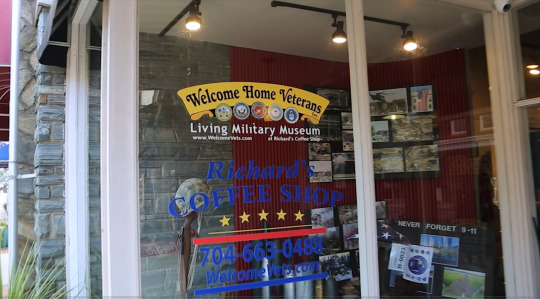
Discover Downtown Series - Richard’s Coffee Shop
A Hero’s Welcome Downtown
By Kelly Sopp
Welcome Home. You’d be hard pressed to find two more comforting words in the English language, especially to a US military veteran. Welcoming soldiers home is exactly what Richard’s Coffee Shop, on Main Street in Downtown Mooresville, is all about. This unique spot is one part military museum, one part café, and one part a gathering place. And whether you’re a veteran or not, you’ll immediately feel at home there.
Building on a Dream
Everyone who comes to Richard’s has a fascinating story to share. And the story behind this Coffee Shop is an incredible one, too. It starts with Richard Warren, a US Army, Vietnam combat pilot who flew a Huey attack helicopter during the war. Like so many young men in the 1960’s and early 1970’s, he risked his life to serve his country and returned to an ungrateful nation. After the war, Richard’s wife Pat had the idea to open a coffee shop and thought the business might help Richard better transition into civilian life. So Richard named it Pat’s Gourmet Coffee Shop, and they opened their doors on Main Street. Having a soft spot in his heart for his fellow servicemen, Richard began offering free coffee to veterans on Thursdays. He had a wonderful way of welcoming vets, making them feel honored and appreciated whether they’d seen active duty or not. Word spread about the little coffee shop in Downtown Mooresville, and soon people started coming from all around the Charlotte area to meet Richard and share their own stories. Veterans began bringing in their memorabilia to hang on the walls. They pinned up photographs, postcards, medals and hats until the walls were nearly covered. Richard created The Book of Honor, and he asked every veteran who stopped by to sign it with name, rank, and time/location of service. The couple had put honor on the map, resulting in Our State Magazine naming it “The Most Patriotic Coffee Shop in America”.
Living to Serve
According to his friends, Richard lived a very simple life in a small house nearby. Despite the hot and humid summer climate, he went without creature comforts like air conditioning so that he could put his earnings back into the coffee shop. He started a non-profit called Welcome Home Veterans, which was designed to give fellow servicemen the proper welcome he felt they deserved but never received. Through his non-profit, he was able to collect small donations and use what little money he earned to help other veterans with their financial troubles, health issues or setbacks while transitioning to civilian life.
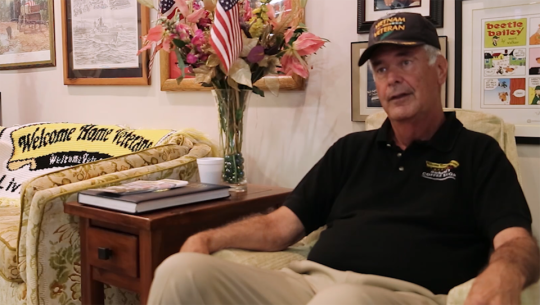
A Common Bond
Just as all good stories have unexpected twists, this one does too. John Hedley (a retired US Army Lieutenant Colonel and Vietnam vet, pictured above) brought some of his out-of-town army buddies into the coffee shop one morning. They shared their service stories, and recalled how their Reconnaissance Platoon wore red kerchiefs around their necks during combat, which was quite unusual. Richard’s face lit up because he remembered those red kerchiefs. To their mutual astonishment, they discovered it was Richard who had flown an offensive air strike that had saved their lives. Richard and John Hedley became very good friends over the years. And when Richard developed cancer due to exposure to Agent Orange, he appointed John to the Board of Directors of Welcome Home Veterans.
Paying It Forward
Richard passed away in 2009, having collected 4,000 names in his Book Of Honor . John, along with a group of loyal friends, decided they would do whatever it took to keep Richard’s dream going. When the landlord wouldn’t renew the lease, the group rented a space on South Main Street, all the while working to pool enough resources to purchase a permanent home in a building across the street from the original coffee shop. Formerly an art gallery, the new location allowed them to grow. They added a living military museum and expanded the coffee shop into a café. In honor of their friend, they named it Richard’s Coffee Shop.
A Living Tribute
There is an impressive military display in the large window that runs along the street. Inside, American wars are displayed chronologically, from the Revolutionary War to the Gulf Wars. Photographs, letters, uniforms, maps, and medals of honor are artfully curated and displayed. When designing the overall space, John drew inspiration from a museum he visited at Pearl Harbor whose items were displayed in an especially engaging way. More than a museum, John’s idea for Richard’s Coffee Shop was to create a tribute to those who serve, and a living history for anyone who is interested. Incredibly, the shop has never purchased a single piece of memorabilia or photography. Rather, each item for their museum has been donated by a veteran, a veteran’s family member, or has a direct connection to someone who has visited. “That’s the magic of this place,” says John. “It’s so much more personal.”

Good Coffee, Good Conversation
In the back, volunteers run the café where you can order coffee, breakfast, snacks and lunch. Groups of friends and strangers mingle, tell the latest jokes, and regale stories enjoying the bond of a shared military experience. Humor is front and center here. There’s a dedicated “happy table”, a “liar’s table”, and even a “pretty women’s” table. There’s a room that’s dedicated to Blue Star and Gold Star Mothers. There’s an Honor Room, dedicated to the coffee shop regulars who have passed away. A reading room is stacked with military books. And there’s a private prayer room available, with a chaplain who holds hours and makes appointments for council or conversation. Richard’s even has a gift shop featuring memorabilia and the book We Were Soldiers Once… and Young by famous war journalist, Joe Galloway, who visits regularly.
Putting Out The Welcome Mat
Since opening Richard’s, The Book of Honor has logged more than 15,000 signatures and counting. John is especially proud to continue the tradition of giving all veterans a proper Welcome Home. “To have gone through that kind of sacrifice and come back to find out people hate you for what you did…it was a terrible experience,” John recalls about his own return from Vietnam. “Now, the traditional greeting around Vietnam vets is ‘Welcome Home’. If nobody else is going to welcome us home, then we’ll welcome ourselves home.” Of course the sentiment extends to all men and women who serve, not just Vietnam veterans. “If you look around here, and you see what’s on the walls, it’s really a tribute to service,” says John. “It’s an honorable tribute that pays respect to the men and women who raise their right hand and promise to serve. There aren’t a lot of us who do that.”
A Meaningful Journey
In addition to the regulars at Richard’s Coffee shop, many visitors make a special stop while driving south for the winter, or while traveling to see family. Young people come to better understand what their parents and grandparent’s generation have been through. History buffs come to see a unique perspective of war. And veterans come to shake hands with others who have served. “Richard’s Coffee Shop is a place of support,” says John. “Many veterans come back, often from serving in a hostile environment, and they are having issues…feeling not quite normal. They come here and there are people they can relate to, who are going through the same things, the same issues, and have the same feelings. They can come in here and all of the sudden they find they are not unique. There are other veterans just like them who understand what they’re going though.”

Strike Up The Band
Music is a wonderful part of the healing process at Richard’s. On Saturday mornings, regulars and tourists crowd around to participate in the southern, folk-style music circle. Anyone is welcome to bring an instrument and jam along, or sit in and just learn to play. You’ll find yourself in the company of washtub base players, banjo players, guitar and fiddle players, harmonica players, drummers and more. If you’re up for it, jump right in, sing along and slap your knee. You’ll recognize the uplifting and songs and hymns. And don’t worry! The words will come back to you.
Giving It All Back
In keeping with Richard’s dream of helping fellow veterans, the Welcome Home Veterans non-profit continues to offer support to anyone who was honorably discharged. Richard’s Coffee shop both sponsors and participates in a number of events in order to help raise funds. There’s a 5K run, an annual golf tournament, BBQ dinners, and a large Veteran’s Day Parade accompanied by a weeks long outreach program featuring organizations where veterans can find the additional resources and assistance they may need. The parade has become a big event, with nearly the whole town of Mooresville turning out to welcome them home. “None of us served to look for thanks” says John. “We don’t expect people to thank us for what we do. But nothing makes us feel better than when people spontaneously thank us, or give us recognition for the services and sacrifices that a lot of folks have made to keep this country free.”
Richard’s Coffee Shop located at 165 N Main Street, Mooresville, NC 28115. Hours are Monday – Saturday, 7:30 AM – 3:00 PM. Free Coffee for veterans on Thursdays. Music Jam is on Saturdays, beginning at 10:00 AM. To donate or volunteer, please visit the website. http://www.welcomevets.com/
0 notes